The Grizzle Blog


This article breaks down how Headspace generates over 720,000 monthly organic visitors. You’ll learn how this ecosystem helped generate over 2 million paying subscribers for Headspace and how you can apply these lessons to a SaaS content marketing strategy.
The Headspace content strategy: delivering value through content ecosystems
The Headspace product is itself a content platform. It exists to guide people through basic meditation principles, inviting them to subscribe and take advantage of features to expand their meditation journey.
But you don’t need to be a paying customer to reap these benefits. Every piece of content is designed to deliver value and educate their audience regardless of membership or means..
The Headspace home page prioritizes this mission before presenting product features:
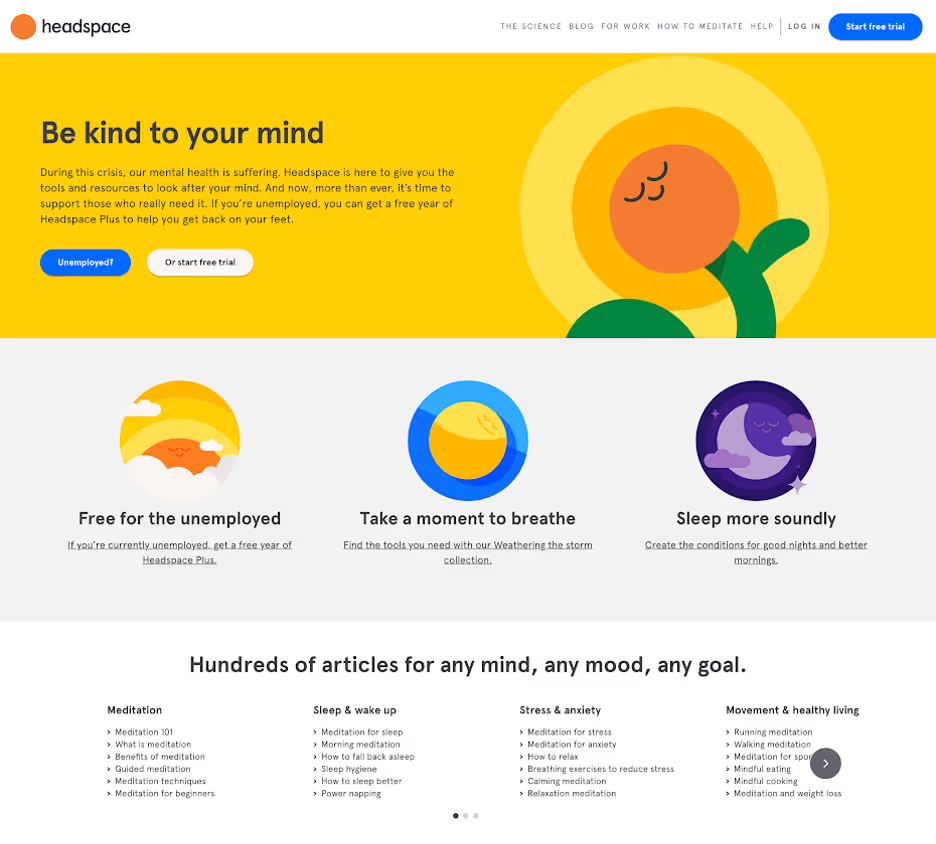
There’s a blend of urgent and evergreen content. If you’re new to the meditation scene, there’s plenty here for you to get started no matter your experience level.
Here’s what else Headspace does exceptionally well:
- A deep understanding of their customer personas—no matter where they are in their mindfulness journey
- Dedicated to over-delivering value on evergreen topics
- Rapid and agile responses to trends and major shifts in the world (e.g. when they offered free subscriptions to users affected by the COVID-19 pandemic)
- Cheerful and engaging branding that’s present throughout every blog article, video, and design asset
This strategy ensures their audience finds the information they need to start their meditation journey immediately.
This is what great content should do; inform, educate, and entertain in a way that builds awareness. Most importantly, it gets them invested in your product.
For SaaS and tech brands starting with content marketing for the first time (or those looking to improve their existing strategy), here are some lessons you can take from Headspace’s approach:
- Set the context: Why do you exist in the world? What are you hoping to help your customers achieve? This must be present in everything you create and publish.
- Conduct qualitative research: Data is critical for developing a content strategy. But you must talk with your customers to gain a true understanding of their needs. Ask them what they struggle with and what their goals are.
- Map needs to topics: Help customers solve these challenges by creating content on specific topics. Map your content to each pain-point. Identify trends that you can capitalize on.
- Go where your customers are: As part of those conversations, find where your customers are most active. Which channels, communities, social platforms, and publications have their attention?
- Build a community: Go one step further and become that channel. Create a space to let your audience come together, building a community around your product.
For example, martech brand Mutiny has created a community that brings senior marketers and revenue leaders together—both online and in-person:

Not only does Mutiny’s community bring advocates and buyers together, but they also use it as a platform to share their stories. This philosophy transforms their customer into the hero, allowing the broader Mutiny audience to learn from their peers.
Your content strategy must serve your audience and align with your business objectives. Before publishing anything, ensure it accomplishes both of these outcomes.
Creating SEO-driven content in a competitive market
Headspace’s dedication to value-driven content helps them rank for highly competitive keywords like “meditation” and “mindfulness”:

Collectively, the 143,000+ keywords they rank for generate over 720,000 visitors a month (according to data from Ahrefs).
To put that into perspective, you would need a monthly paid media budget of $619,000 to generate that traffic volume.
Let’s break their SEO-driven content strategy down further, starting with this content hub on “meditation basics:”
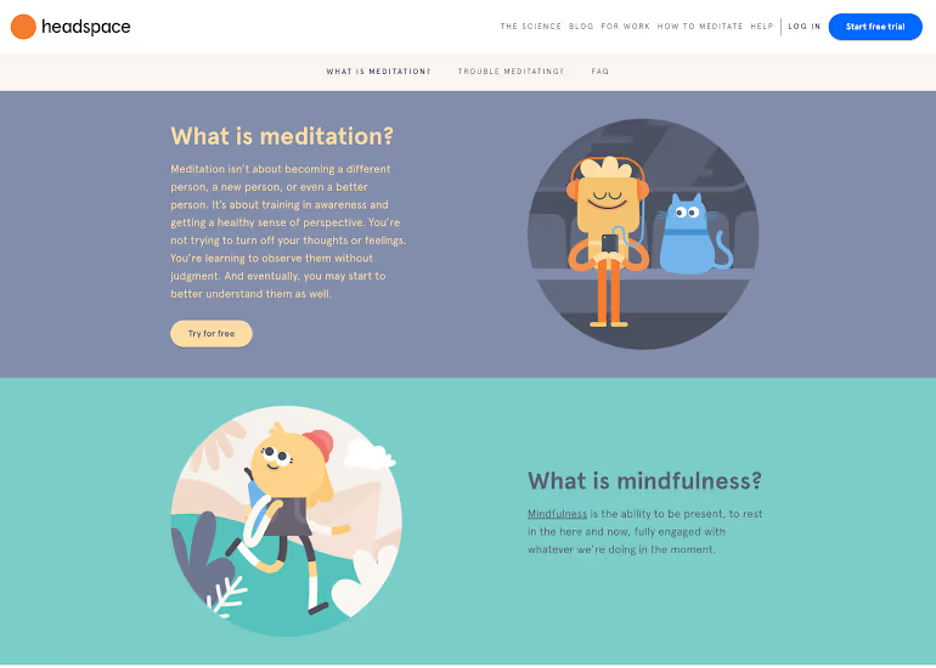
Using a hub-and-spoke approach, Headspace can create content around more specific topics, building out a comprehensive resource. This helps them build topical authority and rank for highly competitive keywords.
For example, this page currently ranks at position #9 in the SERPs for the term “transcendental meditation:”
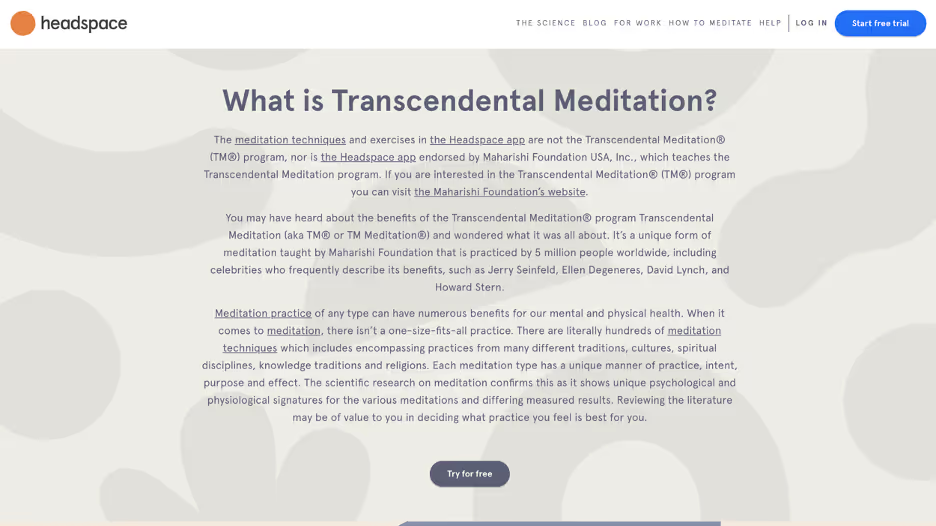
This article builds credibility and authority—both in the eyes of readers and the Google algorithm—by:
- Using objective data from third-party sources to back up claims
- Covering the basics of TM without overwhelming the reader
- Wrapping the content in a beautiful UI to keep readers engaged
The result is an incredibly engaging piece of content that organically attracts readers and backlinks.
Optimizing content for better results
A deeper analysis of Headspace’s blog presents several opportunities to improve results.
First and foremost, it could benefit from a more editorial-friendly format. In other words, remove the landing page style and reposition them as articles by expanding on each section.
Furthermore, according to Clearscope, there are several opportunities to include new themes that will help improve rankings:
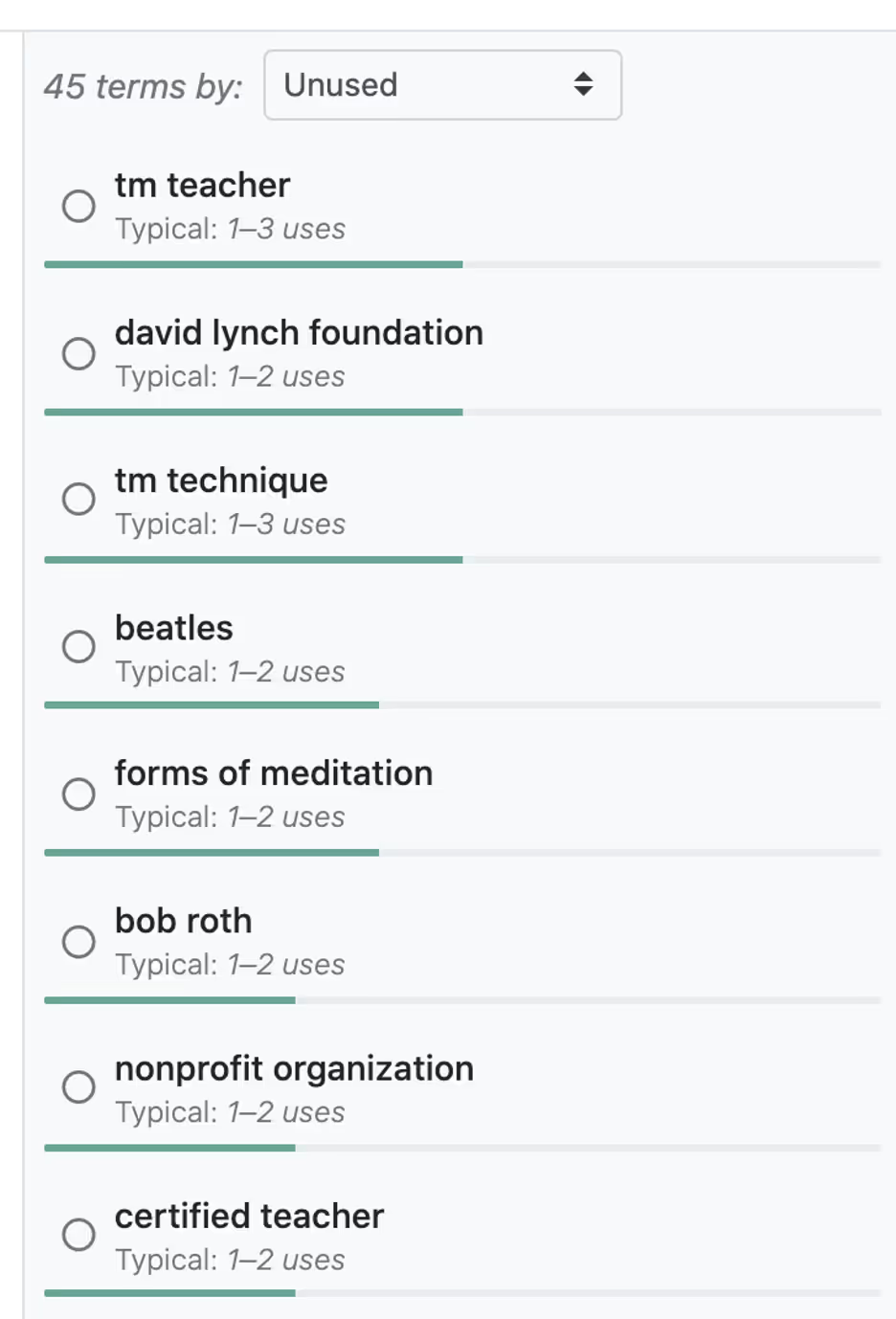
The same goes for their blog content. For example, this article ranks at position #17 for the term “high functioning depression,” which generates over 17,000 searches a month:

As you can see on the right-hand pane, there are several themes that the article could include to improve search performance.
I explore this in more depth in the video below:
Adopting a content optimization process can improve traffic and future-proof your content. It requires you to tend to your content like a garden. A publishing schedule and distribution act as soil and fertilizer, but you must water and prune those plants to see them flourish.
Charming and educational video content (generating over 120 million views)
Headspace's YouTube presence embodies the high-quality, educational content they're known for:"
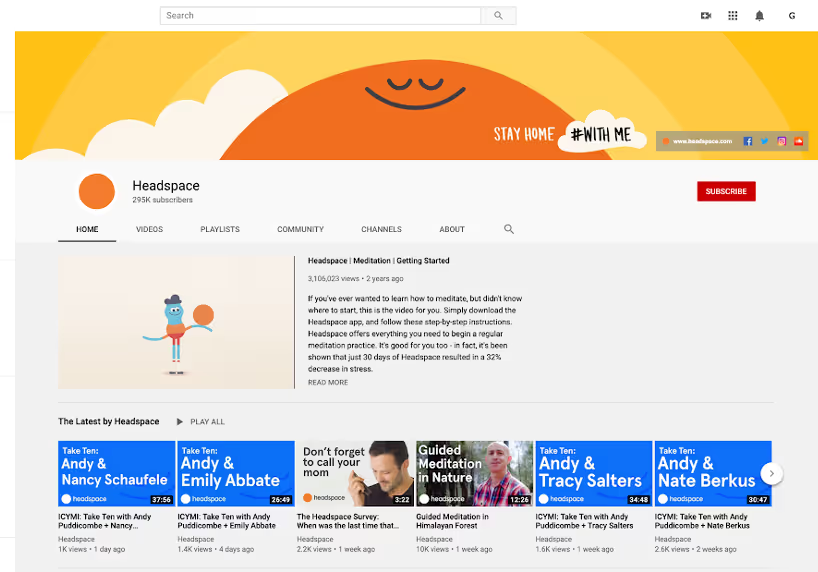
Their presence on the world’s second-biggest search engine is impressive, with over 500 video uploads to date. According to Social Blade, Headspace’s YouTube channel generates an average of 658,543 views every day:

Their YouTube channel offers a cohesive experience that shares educational content around relevant topics.
Many SaaS and tech brands treat YouTube as a dumping ground for webinars, product demos, and sales enablement content.
This is a mistake. While you may attract views, you won’t build an engaged audience hungry for your next upload.
Thanks to their commitment to high-quality video content, Headspace has generated over 620,000 subscribers.
However, the question remains: how do they use YouTube as a standalone marketing platform? To answer this, let’s dig deeper into one of their most popular videos on understanding dark thoughts:
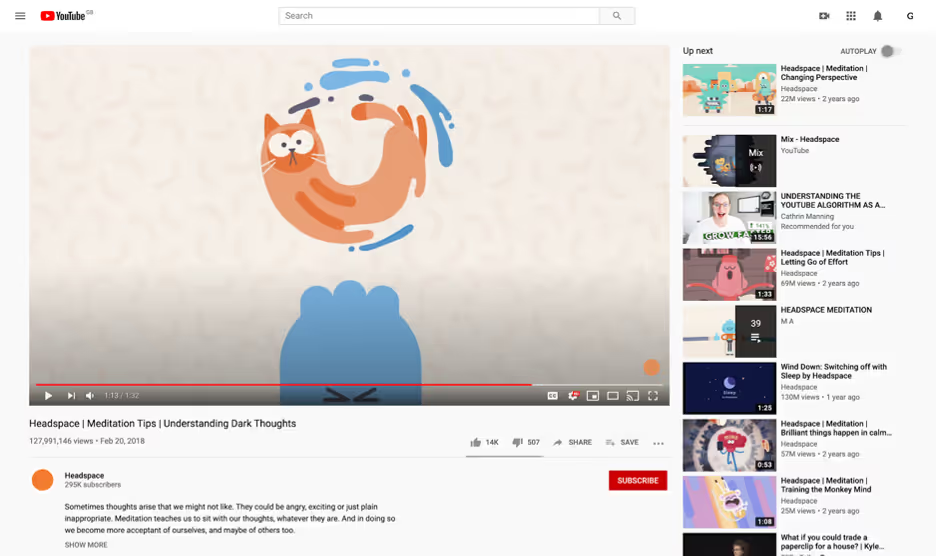
Based on the comments, we can deduce that paid media—namely pre-roll ads—has driven the majority of these 139 million views.
Despite this, it still garners a high level of engagement—with more than 14,000 likes and over 900 comments from people who find the disruption welcome.
We’ve discussed how content can fuel your paid media efforts in the past, and Headspace is proof that it works.
YouTube is also the second biggest search engine in the world, another factor that Headspace capitalizes on:

This particular video ranks for the term “meditation” and has generated over 80,000 organic views in four months.
In short, video is a critical component of Headspace’s organic and paid acquisition strategy. It generates clicks, educates their audience in entertaining ways, and drives new users.
Creating exceptional video content at scale
Producing high-quality video used to be a mammoth task. However, it’s not as expensive and time-consuming as it used to be.
By establishing visual styles and adopting proven video frameworks, producing video content at scale is now simple and affordable.
Headspace uses constraints to publish beautiful video content consistently. There’s a clear visual style, with each video focusing on a specific purpose:
- Short guides: Beautifully animated videos that provide advice on specific topics
- Interviews: Long-form videos where Headspace’s founder, Andy Puddicombe, interviews experts and thought leaders
- Direct-to-camera: A scripted format where Andy sits in front of the camera to provide meditation advice
They’ve also created several “limited video series” around specific topics. One example is “Sleepcast,” an audio series providing free bedtime meditations:

Applying constraint to your video marketing allows you to scale up production while maintaining a high bar for quality. Commit to specific frameworks and batch elements of the production process to maximize resources.
For example, if you’re looking to publish four direct-to-camera videos a month, batch the live-action portion across one or two days.
Use your social media presence to set audience expectations, create a cohesive experience for viewers, and get them excited for future videos.
Digital PR, link building, and getting featured by Bill Gates
Headspace have gained their fair share of press attention. With mentions from CNBC, Forbes, and even Scientific American, they’ve effectively climbed the attention ladder.
Done right, digital PR contributes to brand awareness and helps you connect with prominent industry influencers.
Headspace’s digital PR activity took on a life of its own when they caught the attention of Bill Gates. In his own words, the product helped him go from meditation skeptic to believer:

Headspace consistently get picked up by publications for several reasons:
- They create exceptional content in a variety of formats: This includes blog and video content, as well as “traditional formats” such as books. Package and position your content in new ways to open up distribution opportunities.
- They simplify complex ideas: The science behind meditation can be daunting. Andy and the team have broken this into digestible chunks, seen throughout their entire content ecosystem.
- They produce owned data: Journalists are hungry for new studies and data to cite. It helps them back up their content, make accurate claims, and increase their stories' credibility. Create data-driven content, become a go-to resource, and generate backlinks in the process.
Headspace goes one step further, partnering with scientists and organizations to conduct their research. Not only does this amplify their reach, but it makes these studies more credible:
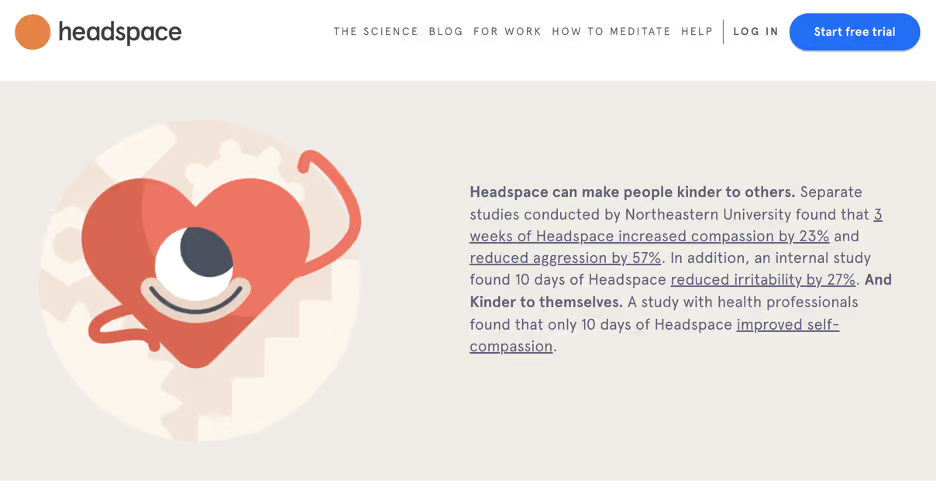
This approach can help fuel your link building efforts. Do this by creating assets that allow creators and brands to enhance their content. Experiment by creating content around highly shareable formats:
- Thought leadership: Expand on a topic and deliver delightful experiences. Make your content so comprehensive that others can’t help but link to it.
- Studies and research: Use owned data to conduct research and report on trends. Survey your audience about their experiences or thoughts on specific topics.
- Infographics & visual content: Content creators are hungry for illustrations, graphs, and infographics to include in their content. This helps them make their content more valuable and engaging.
Social media scheduling tool Buffer took a data-driven approach to digital PR with their “State of Social” report:
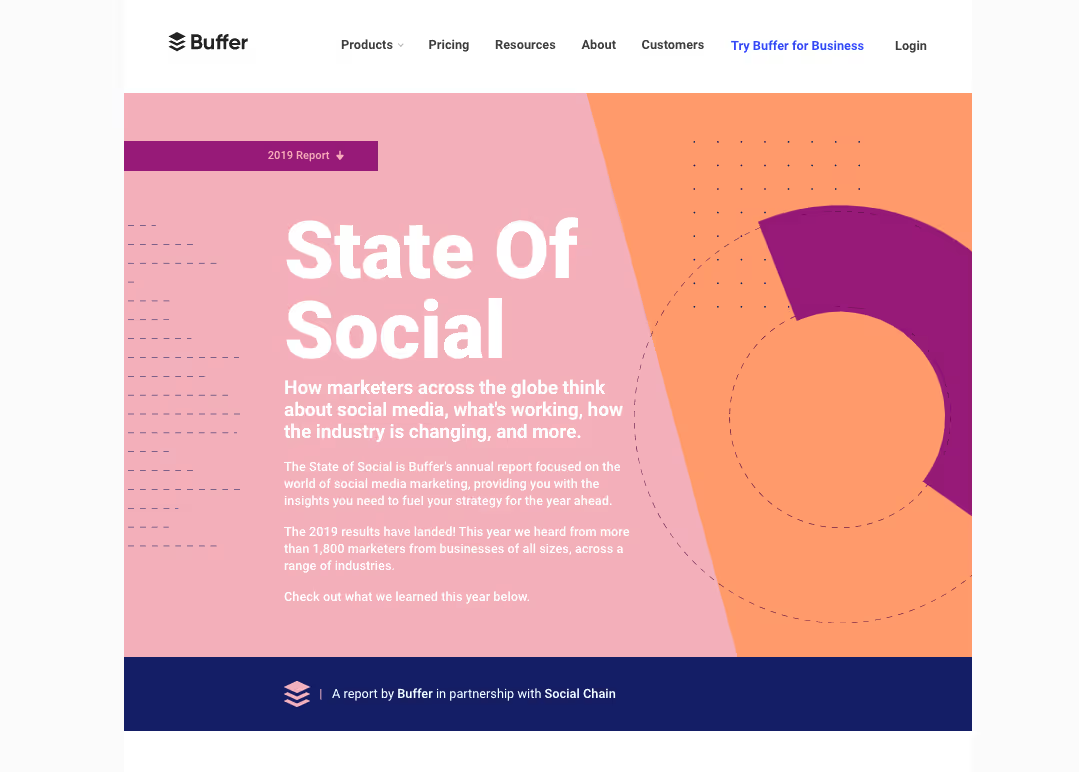
Over 100 blogs and publications cited this report in its first 14 days of publication. At the time of writing, it now has over 1,280 referring domains.
Developing strong relationships is a critical ingredient for digital PR. Cold outreach has its place, but establishing partnerships and collaborating with other brands is more effective in the long term.
Why? Because editors, bloggers, and journalists get bombarded with generic pitches every day. Instead, find ways to collaborate and help everyone win.
For example, we recently helped a martech client get featured in several publications and blogs by creating content with other marketers. Using this approach, we achieved a 37% response rate and a 44% link acquisition rate.
It’s not just about links. These conversations will lead to other business opportunities that ultimately help you capture a wider audience.
Building a personal brand around Andy Puddicombe’s expertise
Founders often start their business around a problem they have first-hand expertise in. It’s essential to get that expertise out into the world.
To date, Headspace Founder, Andy Puddicome, has talked at leading conferences like TED, SXSW, and The Ellen Show:
His story is compelling and easy to connect with. The journey that led him to create Headspace is full of valuable lessons we can use when adopting a meditation practice.
No matter the size of your company—or your role within it—you can share your voice and story to build connections and bridge the gap between brand and customer. This works best for:
- Founders and CEOs: Become the face of your company. Connect with influencers and connectors in your space. Those relationships will last a lifetime when the time comes to step away from the spotlight.
- Marketers: Same goes for growth, demand generation, and content leaders. You can make your job easier by becoming the face attached to every blog post, guest post, or video. You’ll achieve results for your company while advancing your career in the process.
For example, May Habib, Co-founder and CEO at Writer, uses LinkedIn to share content around generative AI and product updates happening at Writer:
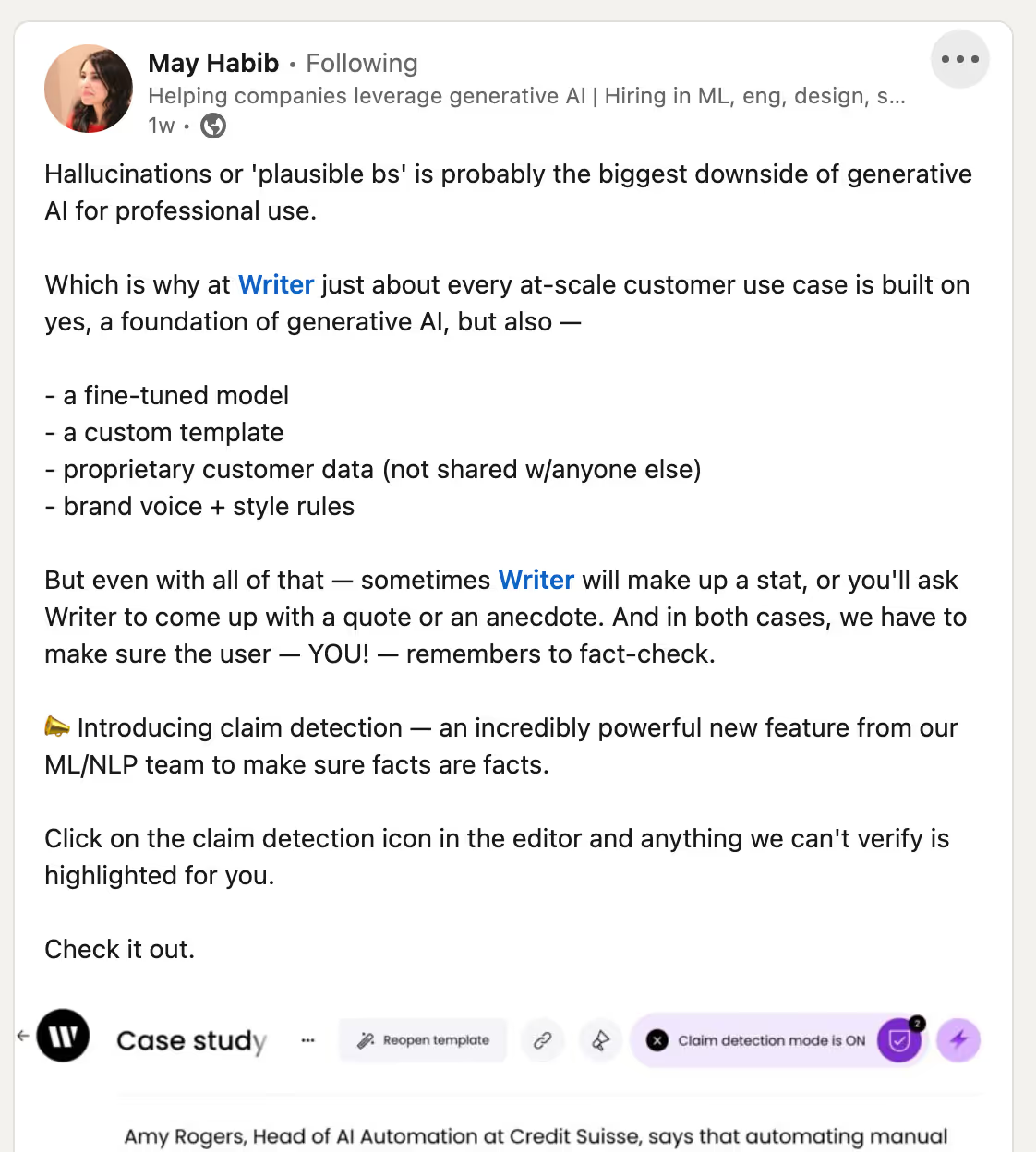
People connect with other people. Building a personal brand and human presence is important for both startups and enterprise companies alike.
Converting readers and viewers into paid subscriptions
No matter where you look, Headspace offers one clear call-to-action:
“Download the app.”
This kind of CTA can often be a huge ask when selling complex or high-ticket offerings. For product-led SaaS or tech brands like Headspace, it makes absolute sense.
Let’s look at what the customer journey from “awareness” to “subscription” may look like for a single user to understand why:
- They browse YouTube and get suggested a video from Headspace teaching a specific meditation technique
- They watch the video and decide to read more about the concept on the Headspace blog
- They follow a link to another article and decide to download the app and follow the free 10-day meditation program
The Headspace content ecosystem contributes directly to user acquisition. From here, they can deliver more value in the app with free lessons, using relevant CTAs and offers to convert free users into paid ones—the classic freemium model.
In this sense, the Headspace product is part of this content ecosystem. It makes sense to drive app downloads from blog posts, YouTube videos, and other owned content assets.
For SaaS and tech brands, the offers and CTAs you use across your content will depend on the complexity of your product, solution, and the nature of your sales process.
You might offer a newsletter CTA to build an audience and slowly nurture them into leads. Or, you could offer a free trial or demo of your product. This is especially effective when crafting crafting bottom of funnel content.
Headspace can nurture free users with three methods:
- Email marketing (newsletters, announcements)
- Mobile push notifications (retention)
- Product marketing (adding new free content)
For example, the email below invites free users to dive back into the app if they’ve not tried a meditation after a specific period of time:

The CTA encourages the user to learn the basics, easing them in by addressing a time-based objection: it takes three to 10 minutes.
Users are far more likely to continue their journey and invest in a monthly subscription if they consume free content within the app.
Build a content ecosystem
Any B2B or SaaS brand can learn something from Headspace.
They’ve built their content strategy on the premise of delighting, educating, and empowering their audience at every touch-point. It’s no wonder they’ve created a product loved by millions of users.
Great content marketing establishes a strong foundation for trust to emerge—all while contributing to critical growth goals needed for success.
Start with your existing customers. Discover why they value your product and put more of that into the world. Do this across your selected channels, and you’ll quickly build a brand your audience loves.


In this article, you’ll learn how to create a digital PR-driven link building strategy, the content formats that generate natural backlinks, and how to achieve a link acquisition rate of 44% from your outreach.
Link building and the law of shitty clickthroughs
Most link building advice focuses on tactics like “broken link building” and the “skyscraper technique.” However, these approaches quickly lost their effectiveness due to how popular they became.
People bombarded link creators with emails that followed the same framework:
- A personalized first line containing a superficial compliment
- Details on the broken or outdated links in their content
- A request to replace it with newer, “better” content
It’s not an attractive offer. You’re competing with dozens of SEOs following the same advice, even using identical email templates word-for-word. Some people suggest nurturing link creators on social before reaching out, but this is both time-consuming and insincere.
This results in burning relationships before they’ve even begun. There’s a misalignment between common practice and what link creators care about.
The more link creators are exposed to an approach, the more they’re aware of the intent behind it and the less effective it becomes. It’s the law of shitty clickthroughs in action.
The solution: produce creative and data-driven content
The link building practices above lack three critical elements to successful, long-term link building:
- Creating something truly interesting;
- Providing link creators with something they value, and;
- Intelligent, well-targeted outreach.
This means producing data-driven and creative content while establishing long-term partnerships with link creators, not treating them as commodities.
This philosophy is how we’re able to generate an average response rate of 37.5% and a link acquisition rate of 44% across our B2B digital PR campaigns.
Two proven principles must act as the foundation for your digital PR and link building campaigns:
- Data: Collect data in the form of studies or benchmarks, or curate existing and third-party data to create a unique narrative
- Creativity: Produce assets, media, and tools to ride trends and delight audiences
Let’s dive into three specific formats that employ these principles, along with examples from brands who use them:
1. Become a go-to source of data with industry reports
Studies and data-driven reports are a tried-and-tested approach to digital PR. They help link creators back up their claims while offering readers new insights.
However, most industry studies fail to share something new. If they do, it’s executed in such an uninspiring and uninteresting way that they capture little attention.
This low bar for quality means it’s easy to stand out for marketers willing to put the work in. Providing a better experience, using good content design principles, or building interactive user experiences give link creators something attractive they can use in their stories.
For example, Mailmodo has positioned their State of Email 2023 report as a product they’ve heavily invested in:
Mailmodo improve the report’s perceived value by:
- Collaborating with other SaaS brands during the production and promotion phases
- Communicating the value of the ebook with benefit-driven copy
- Increasing social proof by adding the Product Hunt “#4 product of the day” badge, further cementing its positioning as a standalone product
Buffer is another example of how great content design can improve performance with their State of Social report:
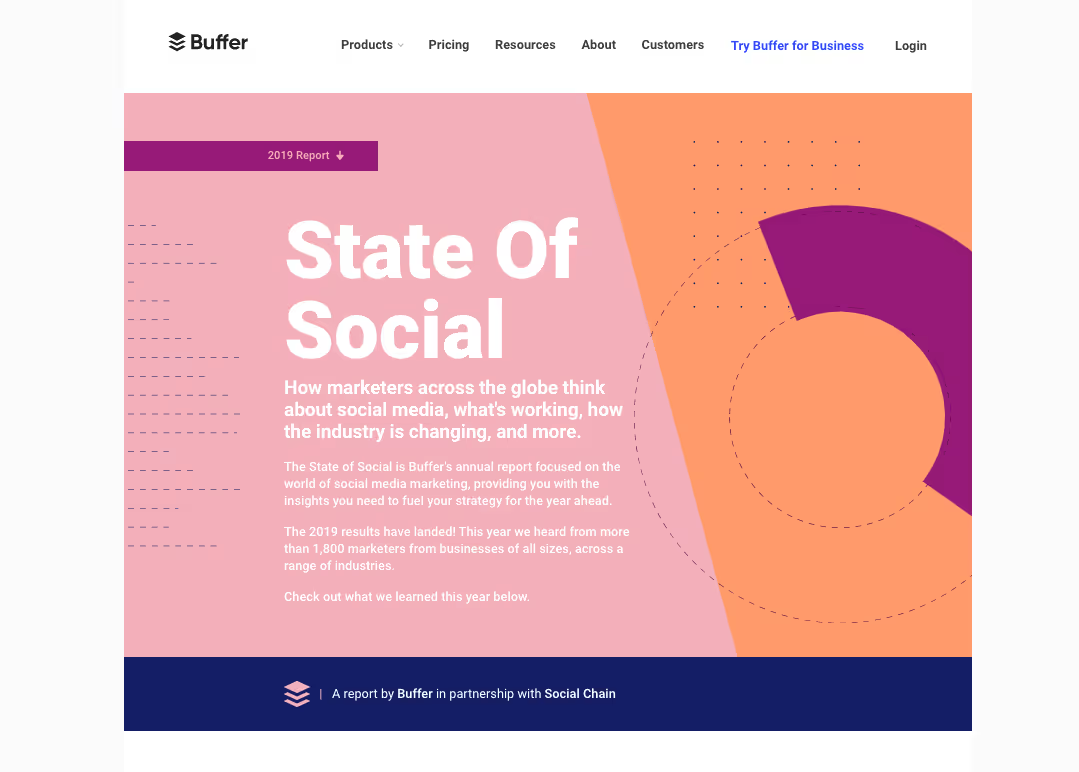
At the time of writing, Buffer’s report has generated over 2,800 backlinks across 1,220 domains—including mentions in Entrepreneur, HubSpot, Search Engine Journal, and other leading business and marketing publications:
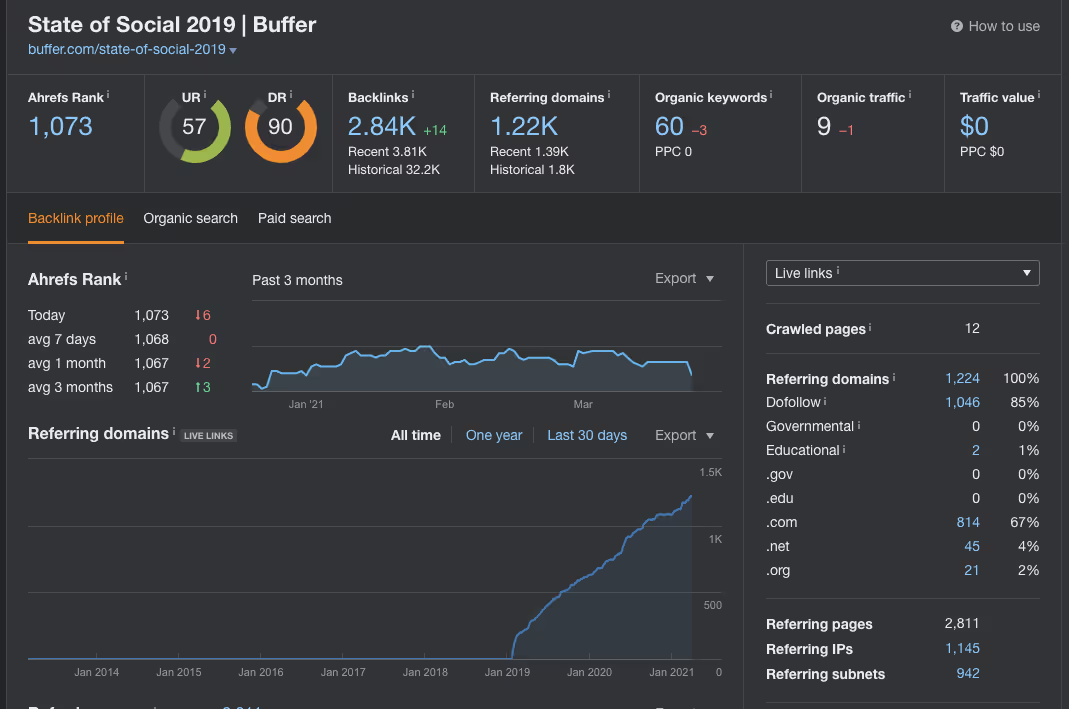
While these reports generate little search traffic, the increase in domain authority combined with intelligent internal linking lifts all ships.
1. Find a relevant and unique angle
All great data-driven projects start with a unique angle. For example, dozens of sales studies are conducted every single year. Pipedrive is one of the few to create a statistically-backed, journalistic-style dive into the state of diversity and inclusion in the sales workforce:
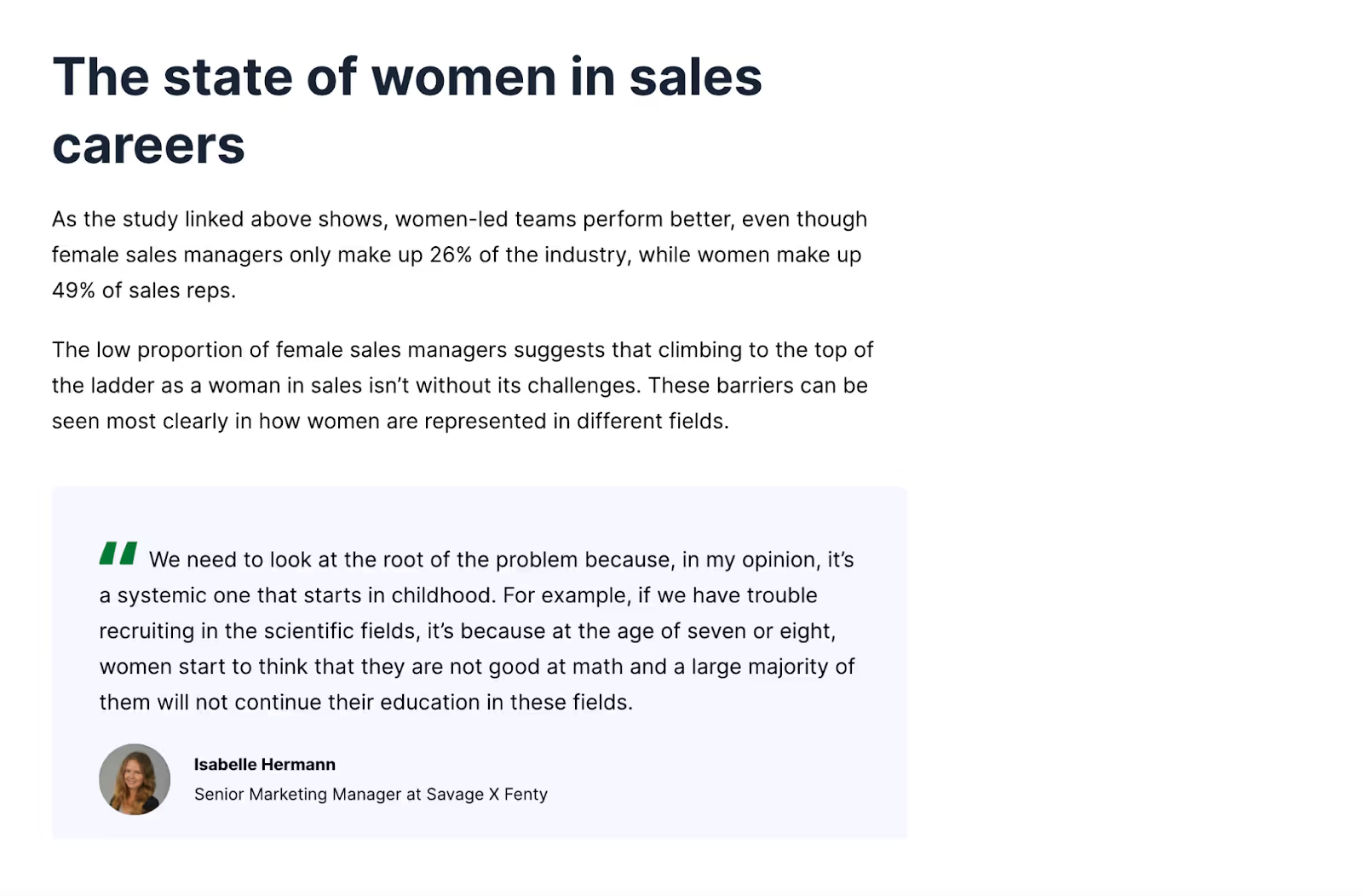
Find an evergreen angle, or uncover a newsworthy trend that’s top-of-mind in the industry zeitgeist. You can do this by:
- Following influencers who regularly share industry updates
- Using tools like SparkToro or BuzzSumo to identify emerging trends
Focus on rising trends that are most relevant to your brand, product, and audience.
Furthermore, prioritize those where you have experiences, stories, and expertise to further hypothesize around the data. This is how you position yourself from a “resource hub” to a true thought leader.
2. Collect and source statistically significant data
The most challenging part of this process is sourcing a statistically significant dataset.
We’ve found the most effective methods of collecting data are:
- Analyzing owned product data. For example, an email marketing platform organizing open rate benchmarks across industry segments.
- Scraping publicly available data. For example, scraping the backlink profiles of data-driven content from Ahrefs.
- Industry and persona surveys. For example, collecting 500 to 1,000 responses from content marketers for a “State of Content Marketing” survey.
- Collaborating with other brands. For example, offering an audience intelligence brand to analyze their owned data to produce a benchmark report.
Collecting data is just the first step. Finding if there’s a story worth sharing requires careful and honest organization of the dataset you’ve collected.
Finding a data analyst to help you is key. The best analysts also understand that the way data is framed will inform the narrative. Get them involved from the very beginning of your project to ensure good data hygiene and accuracy.
3. Package up key findings for link creators
While data is the foundation of great data-driven content, presentation is key. Accompany your data with beautiful visual assets that content creators and journalists can easily embed in their content.
For example, Pipedrive repurposed the most interesting findings from their State of Sales report into a blog post, complete with easy-to-share infographics:
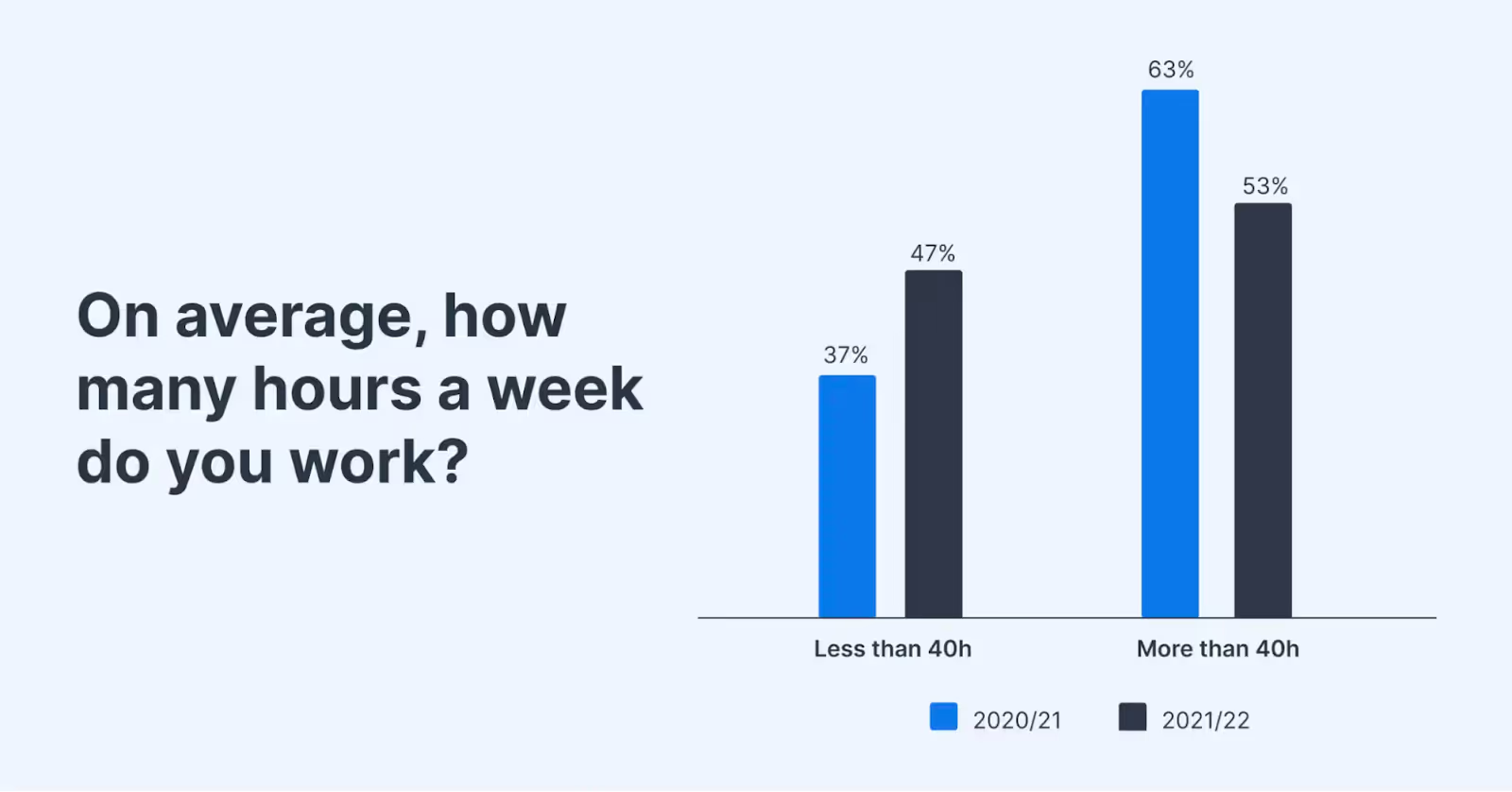
This makes earned content more engaging for readers while extending the reach of your owned content. As more people organically discover your story, the more natural links you’re likely to generate.
Add your opinion to build thought leadership around your findings. Include this in your outreach as commentary to empower journalists to tell the full story.
2. Elicit emotional responses with video content and documentaries
While there will always be a place for information, stories allow you to build a stronger connection with your audience and, importantly, the buyers considering investing in your solution.
The term “B2B” can be misleading. We’re really marketing to the people within an organization. Using media to share your customers’ struggles and successes not only establishes deeper connections, but help improve content marketing and SEO performance in the process.
For example, Mailchimp Presents is a solid example of using documentary-style video content to share customer stories. Creating their own Netflix-style platform, each series focuses on various topics in the realm of entrepreneurship, business, and the future of technology:
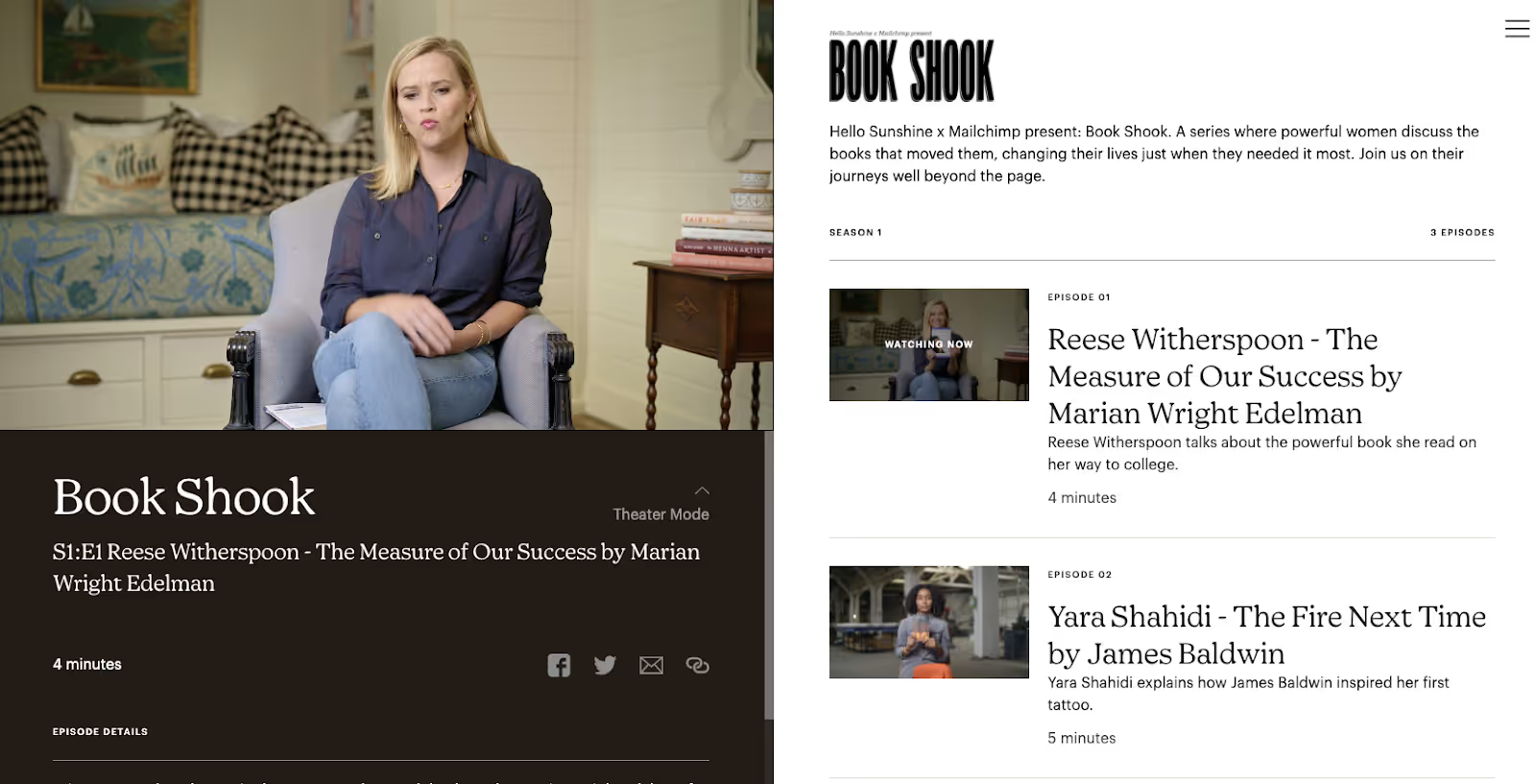
Their series “Book Shook,” as illustrated above, partners with influential and successful women like Reese Witherspoon and Jameela Jamil to share the books that have influenced them:
Mailchimp’s collection of video content is a tremendous source of backlinks, garnering media coverage every time they launch a new series. Each series launch is met with bursts of coverage followed by sustained backlinks:
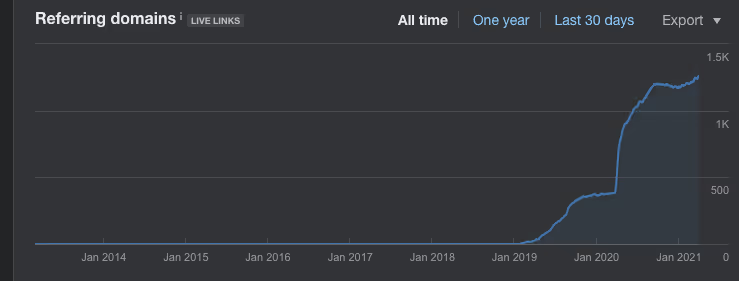
How to create video content at scale
The best marketers make sure their brand gets out of the way of a good story. They make sure their customers or partners are the star, elevating the struggles and successes that their audiences truly care about.
Black Fish covered the corruption of Sea World, but the story was really about Tilikum.
The first step is to find your muse. What story do you want to tell, and who does it belong to? This can include experts within your organization, but don’t forget to look outside and ask yourself: who else would our audience be interested in learning from?
Next, decide on a format. Will it be an episodic series, a one-off video for YouTube, or a podcast?
Understand which formats and platforms your audience is already familiar with and cater to those tastes. Kristen LaFrance does a terrific job of this with Shopify’s Resilient Retail:
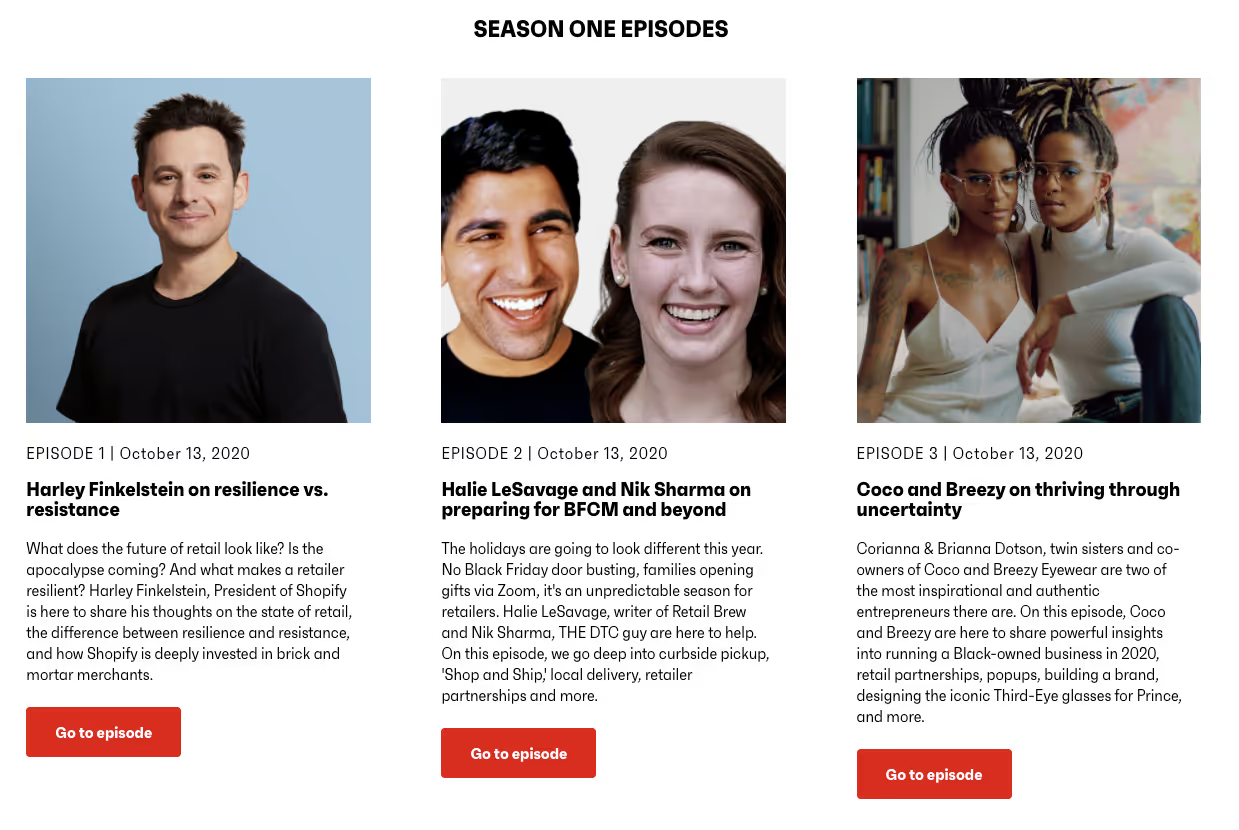
Don’t forget about the repurposing power of your content. Each video can be repurposed into podcasts, short-form video for social, and long-form blog content. Recycle it over and over again for maximum visibility.
Video content production can seem daunting, but it’s not nearly as complex or expensive as it used to be. Check out our complete guide to video content production to learn more about scaling your video marketing.
By starting small, you can replicate Mailchimp’s approach to building a media brand centered around high-end production values.
Collaborate with other creators to enrich your stories while helping them access a wider audience to capture as much attention as possible. This improves the quality of your content, broadens the stories you can share, and gives you access to a wider audience in the process.
3. Generate buzz and excitement with standalone resources and tools
Launching standalone products, tools, and microsites can generate vast amounts of buzz and attention. A great example of this is Mention’s Influencer Marketing Stack:
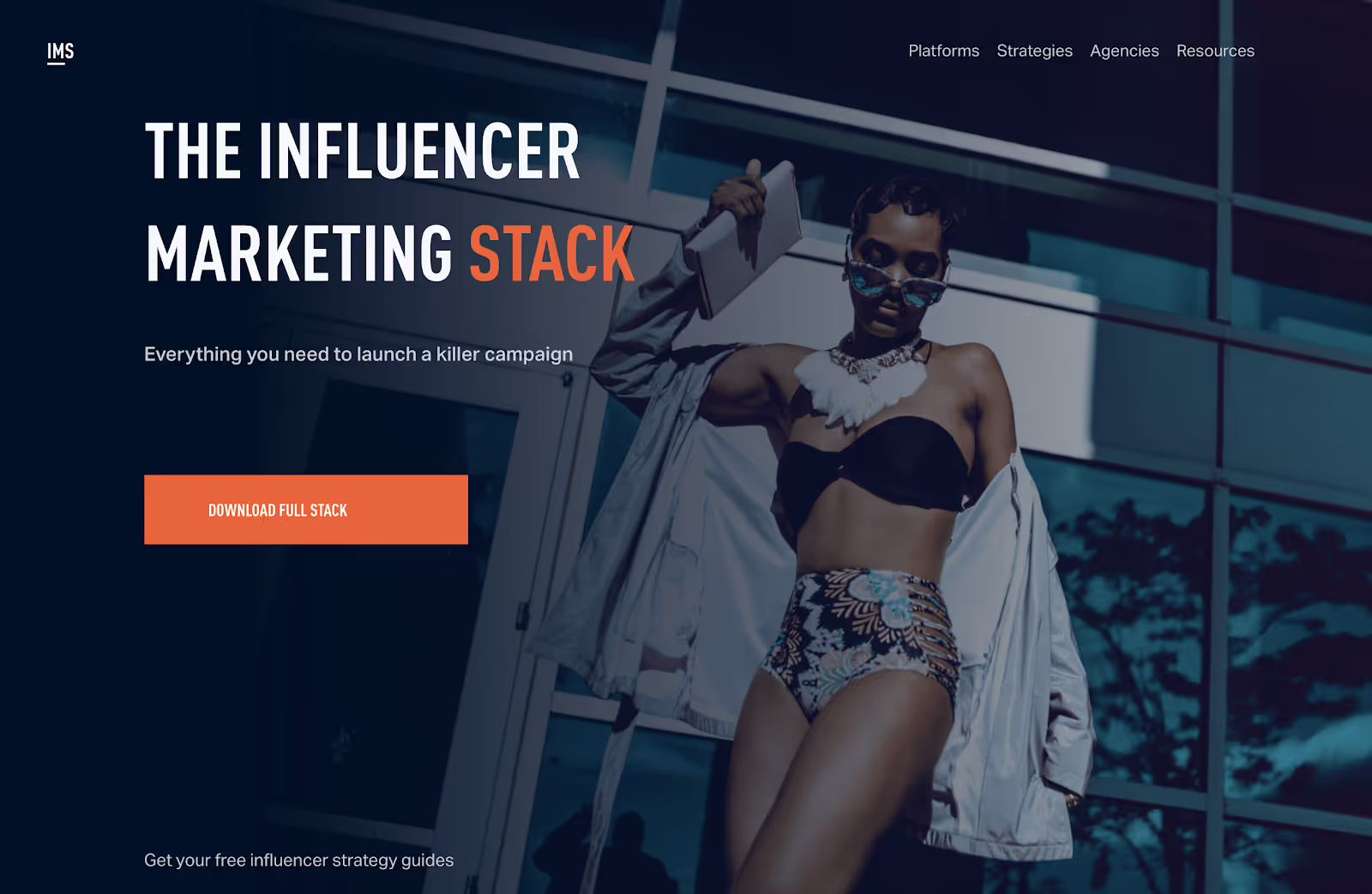
This standalone resource has generated over 1,900 upvotes on Product Hunt and over 847 backlinks from publications like Inc., The Next Web, and Content Marketing Institute.
Here’s what Mention did that helped make this resource a success:
- They exceed value expectations: The microsite provides tools, a directory of agency vendors, and how-to information that marketers can learn from.
- They partnered with top brand: Collaborating with the likes of HubSpot, Later, and BuzzStream extended their reach while increasing the authority of the resource.
- They followed a deliberate launch plan: Mention didn’t achieve success by accident. They coordinated with partners and advocates to make as big an impact as possible on launch day.
Not only do microsites and standalone resources serve your audience, they also provide link creators with a source they can refer to in their own articles and stories.
How to rapidly create and launch resources and tools
Even when building products for digital PR, you must start by discovering what the market is hungry for—or at least curious about—and validating it. Just like you would any other product.
Talk with link creators you already know for their opinion on your project. Share its purpose and how you plan on delivering value to your audience. Ask them for their opinion and validate its coverage potential.
Customer research is critical for finding new angles and validating what you’re building. We’re not building a startup here, so a burning problem isn’t required. However, your resource or tool should provide utility and garner some level of excitement.
If you’re building an app or software, enlist the help of in-house engineers or an agency like Grizzle. Alternatively, use no-code tools like Bubble and Webflow to build an MVP without technical know-how.
The same goes for microsites. Building standalone experiences is easier than ever, thanks to no-code development tools and website builders.
Create something worth linking to
If your link building KPIs look a little flat, consider evaluating what you’re creating and how you’re reaching out to link creators.
Most journalists, bloggers, and influencers are always looking out for new stories to cover. However, if you’re not seeing the results you expect, it’s likely they’ve seen what you’re offering a thousand times.
Reverse engineer where their attention is going. Think beyond skyscraper content. To acquire links, offer something truly interesting. Do away with superficial outreach and see your response rates soar.


In this article, you’ll uncover a compelling argument for taking more creative risks, the importance of expanding your frame of reference, and learn specific methods to build a competitive moat around your content and brand.
Why creativity is more important than ever in an AI-generated world
The late futurist Jacques Fresco once said:
"Creativity takes known elements and puts them together in different ways.”
Jacques’ work was famous for its creativity. He consistently challenged the status quo in city design, resource management, and social engineering. This reimagination of how to use modern technology was born out of frustration at the lack of industrial innovation.
Today, your audience feels that same frustration due to how common bad content has become.
Blog articles have rapidly lost their zest and originality. As marketers compete for the same keywords, they rely on identical frameworks as their competitors.
But buyers can see that most SEO-driven articles are unreliable and copy each other, which undermines their trust in Google as a source of information.
What’s worse, tools built on top of OpenAI and ChatGPT are exacerbating the problem. While this will ultimately make our jobs as marketers and creators easier, in the present reality they’re being misused to create terrible experiences.
Consumers are already calling out media brands who churn out low-quality content. Just take this comment from a recent Unilad post:
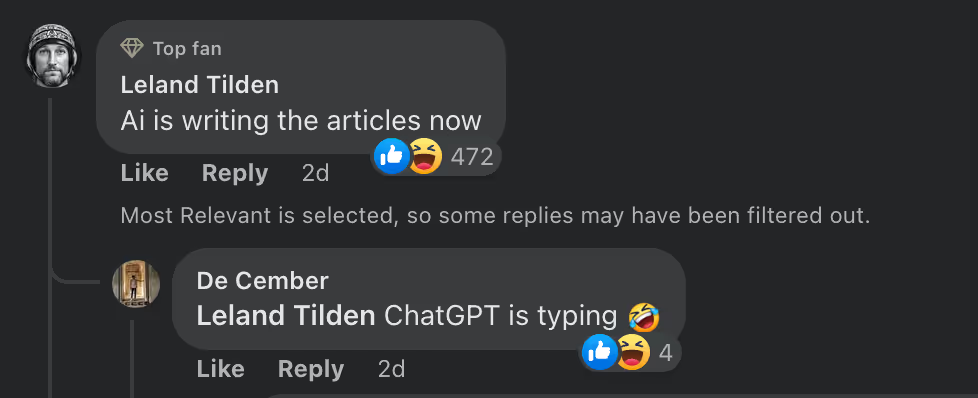
How do we alleviate doubt and delight readers? How do we offer an experience that surprises them and builds trust?
Injecting creativity and doing what robots can’t is the only way.
Use creativity and benevolence to build a content moat
Creativity elevates your content and builds trust with skeptical readers.
As Jacques Fresco said, this requires putting “known elements” together in unique ways.
But we still need to generate business results. Content that generates the lion’s share of attention does so for a reason: it fulfills search intent.
The problem is, everyone ends up copying each other. Trust is eroded as your customers bounce from one article to another.
Creative applications to SEO-driven content helps your content stand out. It keeps the reader on the page, sending engagement signals to Google. The longer a user sticks around, the more likely they are to take action.
Let’s say you’re writing an article on relationship selling. Typical advice for this topic includes “giving value” and “solving objections.”
However, based on your experience, you know it’s important to build intimacy by counter-intuitively challenging prospects and introduce them to their peers.
This perspective offers a unique approach to relationship selling into your article. It builds trust with your readers and creates a stack of value.
Why go through so much trouble for a single piece of content? Because it’s the only way you’ll break through your audience’s “B.S. shield” created by copycat and low-effort AI content.
In their “How People Read Online” report, Nielsen Norman Group found that there are two components to building trust in content:
- Credibility: The user believes you have the ability to provide the information they’re looking for.
- Benevolence: The user believes you have good intentions for providing that information.
One participant of the study shared their experience reading an article from Cleveland Clinic about the health benefits of kombucha. However, despite reading the entire thing, they decided to find a second opinion:
“[The Cleveland Clinic article] was very pro-kombucha. Which is why I was like, I’m going to look somewhere else.”
They ended up reading a Healthline article that shared both the positive and negative effects of kombucha. Healthline offered a complete and impartial perspective. In turn, the reader learned to trust Healthline on the topic over Cleveland Clinic.
Benevolence is an often overlooked element of establishing trust, which is impossible to do if you’re only emulating other articles in Google or relying solely on what AI tools give you.
Broaden your inputs to uncover new creative ideas
Creativity isn’t an ephemeral characteristic. Remember, creativity is simply the act of “putting known elements together in different ways.”
New creative endeavors, therefore, require us to do two things:
- Collect new inputs (such as content, conversations, and data from new places)
- Expand your frame of reference (by investing in new experiences or experimenting)
As a B2B content marketer, a practical way to broaden your inputs might involve researching what other industries are doing to promote their products.
For example, if you’re charged with growing enterprise software, you might find unique content formats in the ecommerce world.
But there’s so much more to it than this. To drive these principles home, let’s explore three specific methods for collecting new inputs to elevate your content.
1. Pay attention to how journalists tell stories
A good hook will communicate why readers should care about your message and earn their attention to continue reading.
Take this example of an introduction found in a blog post on digital transformation:
Digital transformation is a global business phenomenon, capturing the attention of enterprises in every industry and spurring major investment.
Learn why digital transformation matters now, what successful initiatives look like, and how to avoid common pitfalls.
It’s unlikely this introduction makes you feel emotionally invested to continue, even if you’re eager to learn about digital transformation.
Let’s compare this with an introduction from The Atlantic, taken from an article titled “Coffee really does make you happier:”
“I remember the night I fell in love.
“The year was 1977, and I was 12 years old. A neighbor kid’s parents had bought an espresso machine—an exotic gadget in those days, even in Seattle. There was just one Starbucks in the world back then, and as luck had it, we lived within walking distance. The neighbor kid and I bought a pound of coffee and had about eight espressos each. Feeling fully alive and inspired to get closer to the universe, I climbed onto the roof of his house. In the process, I cut a gash in my stomach on his gutter. Bleeding profusely, I marveled at how intense the stars were.”
Not only is an emotional connection made, the story is relevant. The headlike makes a promise before the click, and the introduction sets the reader up to go on a journey that’s likely to have a satisfying payoff.
Using relevant stories will hook readers in and keep them engaged throughout your entire article. When relevant, they can quickly communicate what’s possible with your advice and help your audience relate to your experiences (or those shared by third-party contributors, subject matter experts, etc.)
If you get abstract with this approach, make sure to get to the point quickly. For example, when I shared the story about Jacques Fresco, you may have wondered how it was relevant.
While it hopefully piqued your interest, I didn’t expect to keep your attention for long. So, I made the story succinct and quickly tied it back to the underlying point I wanted to make.
You can use this journalism-inspired technique to create a pattern interrupt. Done right, stories can offer a welcome respite in industries known for dry or technical language.
Here are some methods for finding a worthy subject for your journalism-inspired stories:
- Historical figures and industry legends: Share the lessons learned by those who paved a new way of doing things. Lay the foundations for your argument by blending timeless stories with current issues.
- Underdogs: Avoid leaning on unrelatable lessons from brands like Apple and Coca Cola. There are plenty of small businesses and startups that have achieved a more relatable definition of success. Few can emulate the actions of a billion-dollar brand, but most can apply the principles that helped a business generate its first $100,000.
- Behemoth backstories: If you must use a Fortune 500 brand to make a point, go back to its roots. Marketing blogs love talking about Apple’s branding, but nobody talks about Steve Jobs’ time as a video game designer and his Buddhist pilgrimage to India.
- Individual contributors: Celebrate how practitioners achieved a specific goal. For example, by breaking down the nuances of Apple’s product photography to provide relatable takeaways.
Finally, don’t neglect your own experiences. You have a tremendous amount of wisdom to share.
2. Find an investigative angle with complementary or conflicting data
Many content marketers and writers have a habit of using stats to back up ideas they’ve already committed to.
But it only works if that data is statistically significant, presented honestly, and adds value to the reader.
The best writers use data to share additional perspectives while offering the most suitable conclusion for the reader.
Take this piece on mushroom intelligence from Psyche:
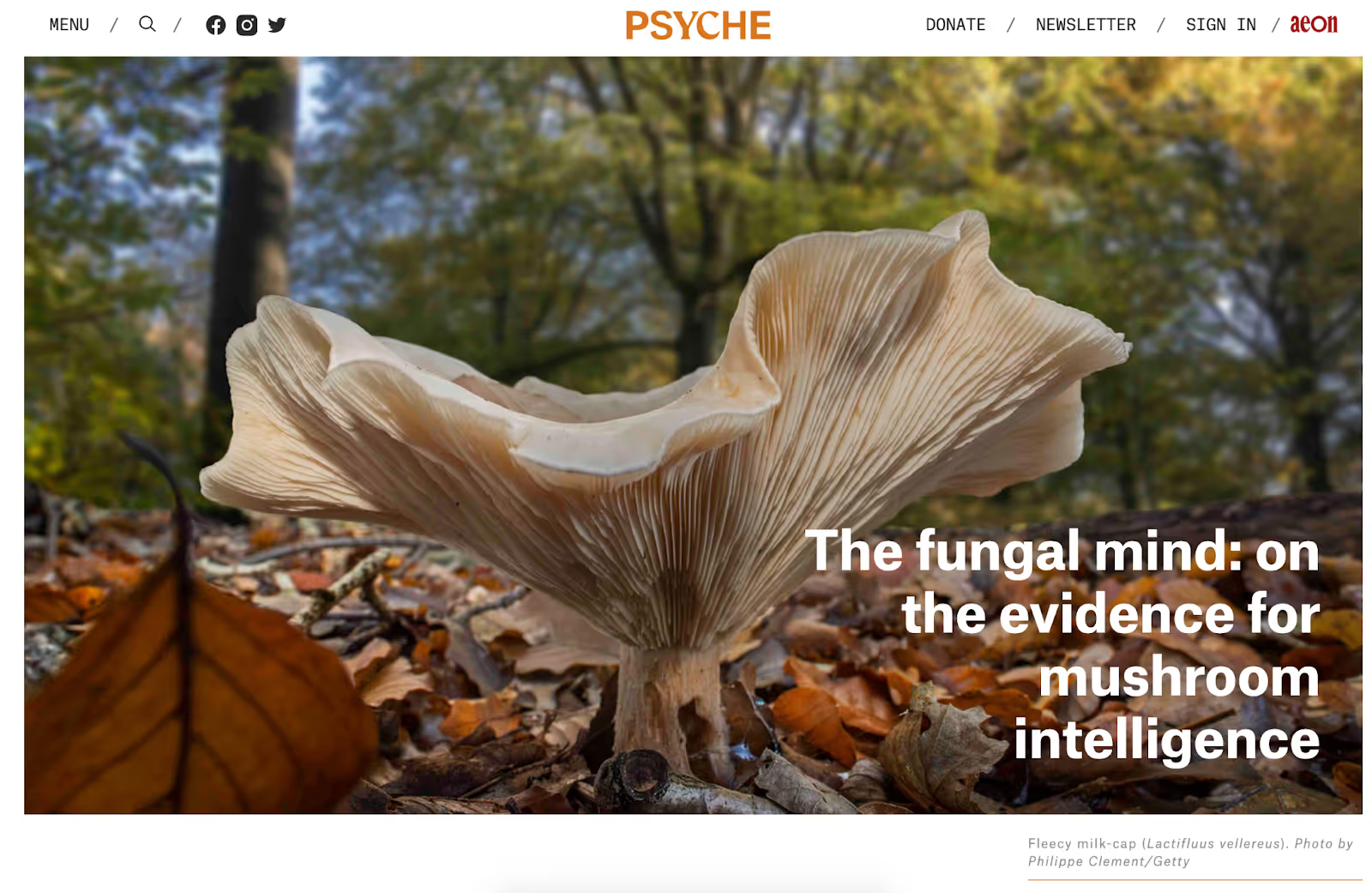
The entire article is a science-backed exploration into the behavior profile of mushrooms.
Here’s how the writer talks about an experiment involving beechwood:
When researchers followed the transfer of nutrients in the lab, further remarkable discoveries were in store. In a tray of soil, hyphae were observed to make contact with a block of beechwood. [...] The fungus in these experiments showed spatial recognition, memory and intelligence. It’s a conscious organism.
They then use data taken from several studies to to interpret how different mushrooms behave:
The behavioural complexity of fungi increases when they interact with living trees and shrubs rather than dead wood. Some of these relationships are destructive while others are mutually supportive. Pathogenic fungi can be very cunning in how they feed on plants and evade their defences.
The author provides an in-depth analysis of fungi, generating over 10,000 shares on social media— a tremendous amount of engagement for a story about mushrooms.
Taking an investigative approach to data-driven content can provide unique angles for your content.
For example, our article on the backlink profile of Buffer and other SaaS brands took a very different direction to the one we originally intended.
The investigative journey that fueled this article looked liked this:
- Use seed data: We started our investigation with this Semrush study, which found that “only 22% of respondents are creating original studies and data-driven content” and “24% say they rely on external publications (digital PR) or guest blogging” for distribution.
- Check your assumptions: Many SEO studies have found that links do matter when growing search traffic. If this is true, why is nobody creating data-driven content, which has been proven to generate links?
- Ask a better question: Do how-to articles, definitive guides, and other SEO-driven content formats still generate links? From our experience, link building outreach that relies on these formats is ineffective.
- Apply your first investigative layer: To answer these questions, we identified data-driven content from 10 well-known SaaS brands and collected backlink data from Ahrefs.
- Add a second investigative layer: We found that these data-driven articles generated an average of 847 backlinks. However, this still didn’t answer whether or not they get more backlinks than editorial and SEO-driven content.
- Add a third investigative layer: We dug deeper into Buffer’s most linked-to pieces of content to find an anecdotal answer.
- Identify the conclusion: Not only does Buffer’s “State of Social” report stand out in terms of backlinks, but we found it was 293% faster to generate the first 100 links to this report than their most linked-to blog article.
Imagine if we stopped at the Semrush study. This article would have looked like every other piece on data-driven content.
Curiosity is the only thing you need to uncover engaging narratives, and access to the data that fuels them is often democratic.
Allow yourself to be proven wrong. If you find two sources that contradict each other, dig deeper into both.
Are there differences in sample size or representation of survey respondents? Use these methodologies to your advantage. Share your findings to tell a story that helps your customers solve their problems.
We talk all about how to use stats honestly and with integrity in this episode of the Demandist podcast.
3. Establish an expert committee to poke holes in the status quo
Subject matter experts (SMEs) can inject your content with credibility.
If the content on page one of Google looks similar, they’re likely exacerbating the same falsehoods.
SME insights can help you break the cycle of false information by calling out what conventional advice gets wrong.
This can build trust with your audience—especially if you debunk an unspoken yet well-known falsehood.
Going back to our article on relationship selling, we found that most blog posts oppose the idea of being likable.
However, our internal SMEs with decades of experience selling to the c-suite inherently disagree. And they can prove it.
Not only will this angle make your content stand out, it will undermine the falsehoods your competitors amplify, giving your audience more reason to trust you.
Jakub Rudnik, Head of Content at Scribe, uses this approach to make his content more original:
As a trained journalist, I look for opportunities to bring in experts wherever possible. Who is the best-case source? What other sources can offer different perspectives? This may not be completely original, but so few content marketers are willing to take these steps.
Get SMEs invested in your content by making it worth their time:
- Batch conversations into topical themes: Schedule one call a month to discuss a single theme or series of articles.
- Communicate asynchronously: Allows SMEs to share their expertise in their own time with Slack voice messages.
- Fuel their personal brand: Many SMEs aim to elevate their message to build awareness. Offer to repurpose your blog content into a LinkedIn post or Twitter thread for SMEs to share with their audience. Better yet, get it featured in a guest post.
SME insights will also help you build E-E-A-T. Featuring the voice of known experts sends a signal to Google that your content is credible, establishing you as an authority in your topic cluster of choice.
Inputs shape your outputs
Creativity is suppressed if we drink from the same altar. Outputs become homogenous and we end up creating the same thing as everyone else.
To inject your content marketing with creativity, collect new inputs and broaden your horizon with new content formats.
Build a moat by doing what nobody else is willing to build. Watch as it provokes thought, influences the conversation, and builds trust with even the most skeptical audience.


In this article, we’ve compiled “link acquisition velocity” data from Buffer’s backlink profile and 10 of the top SaaS blogs to answer this question.
You’ll learn where data-driven content fits in the content ecosystem, how to get started, and methods to accelerate your organic growth with digital PR experimentation.
The discrepancy between blog content creation and link acquisition
92% of the 1,500+ marketers interviewed in a study conducted by Semrush say they invest in blog content. Further, 89% said they rely on organic search for distribution—making SEO the most popular distribution channel.
However, only 24% said they rely on external publications or guest blogging (what we call digital PR) and 22% said they create original studies and data-driven content:
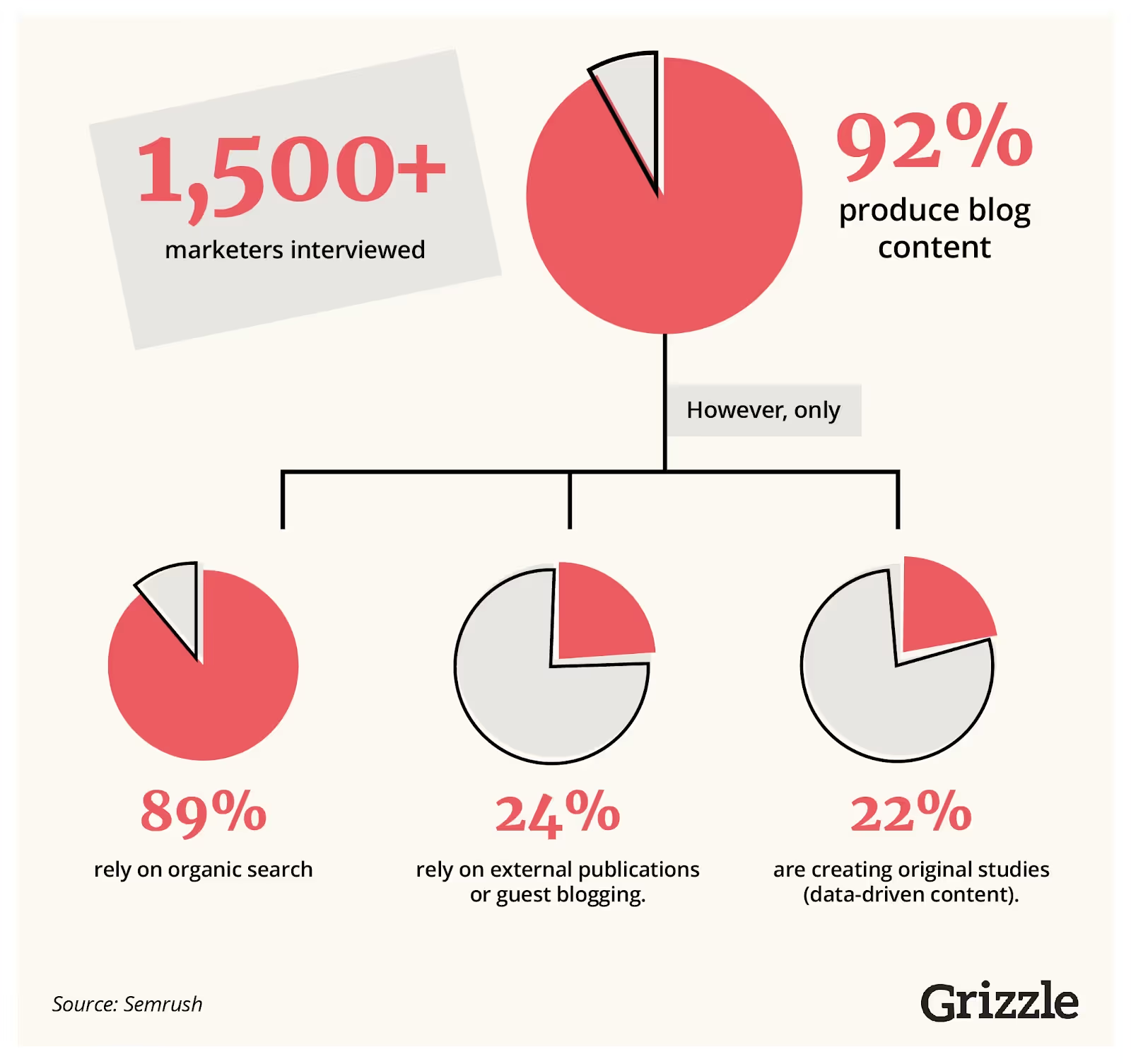
If data-driven content generates more links than editorial content, this means that over 75% of marketers are leaving opportunity on the table.
But is this truly the case?
How Buffer generated 100 links in 14 days
Buffer is well-known for its social media marketing content.
On top of in-depth editorial content, they also produce data-driven studies like the "State of Social" report:
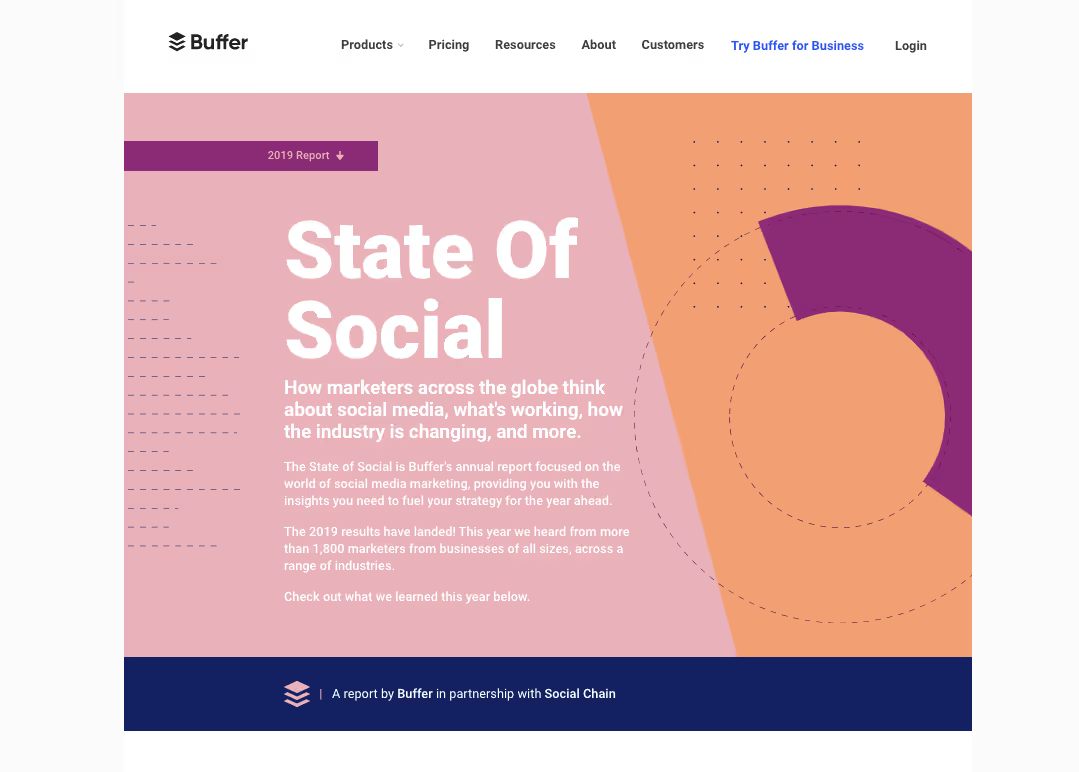
Here, Buffer surveyed 1,800 marketers about their social media strategy, presenting their findings wrapped in a bespoke UI.
At time of writing, there are over 1,280 referring domains (RDs) pointing to this single piece of content.
Let’s compare this to the top 10 Buffer blog articles that rank for position 1 on Google (ordered by search volume):
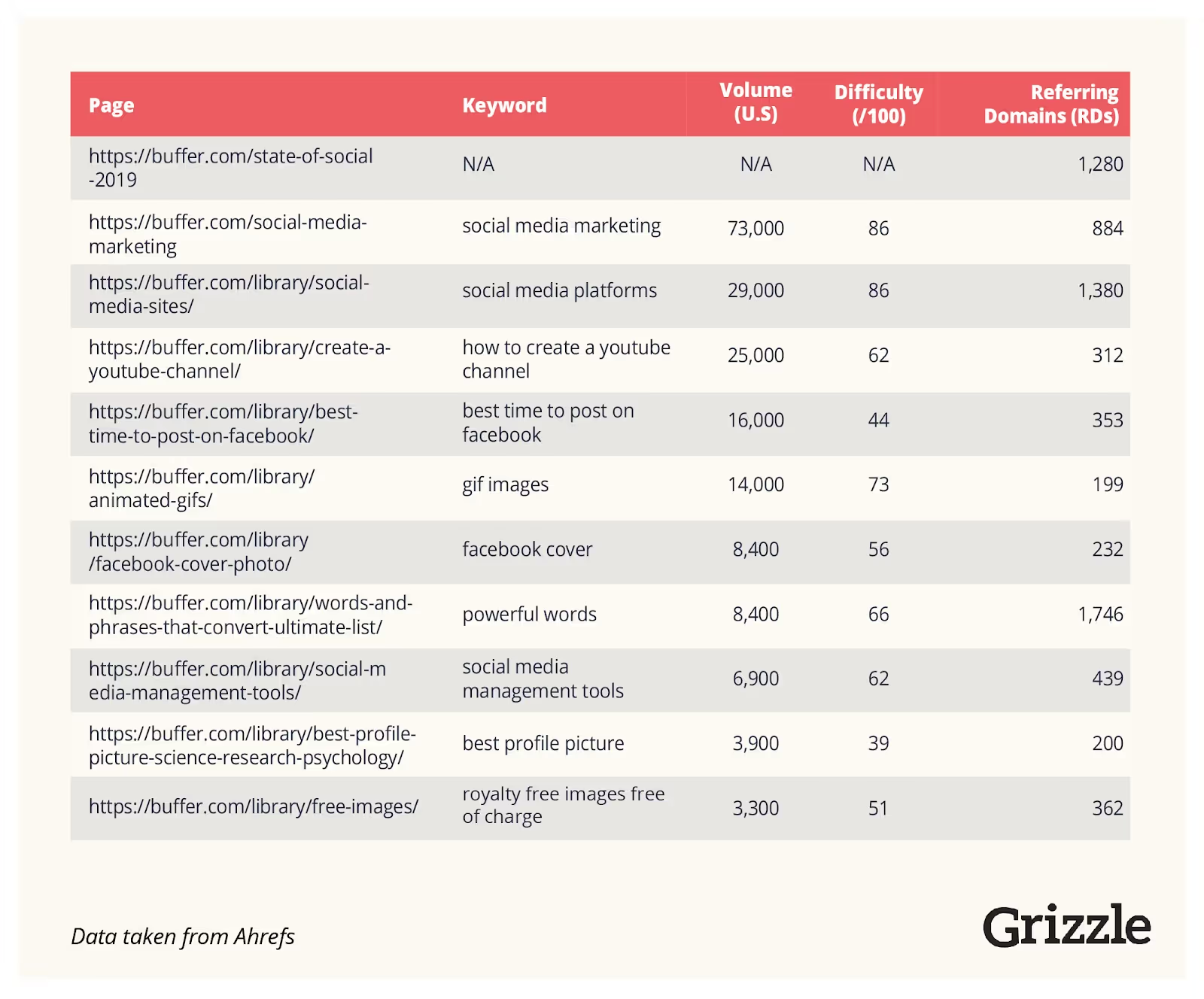
From this data we observe:
- The average number of backlinks from unique referring domains (RD) across their top 10 articles is 373.45.
- “Social Media Sites” is a clear outlier, generating more than 1,300 RDs.
To gauge the impact Buffer’s content has on their link building efforts, we’ll use a proprietary metric called link acquisition velocity (LAV).
LAV is a measurement of how quickly it takes for a piece of content to generate a specific number of backlinks. Let’s say your goal is to generate 50 links, and it takes 32 days to reach that goal. That piece of content would therefore have a LAV of 1.56:
LAV = No. Links Generated / No. Days Taken to Acquire Them
Focusing on LAV allows you to experiment and iterate, which is critical for SaaS brands with long-term distribution and digital PR programs. If you find a specific content format has a higher LAV than others, you can deploy more resources with a higher level of confidence that they’ll perform.
When experimenting, it’s a more reliable metric than total links as it gives a greater sense of demand for a specific type of content in the market.
Going back to Buffer’s link profile, let’s compare LAV between their “State of Social” report and “Social Media Sites” article:
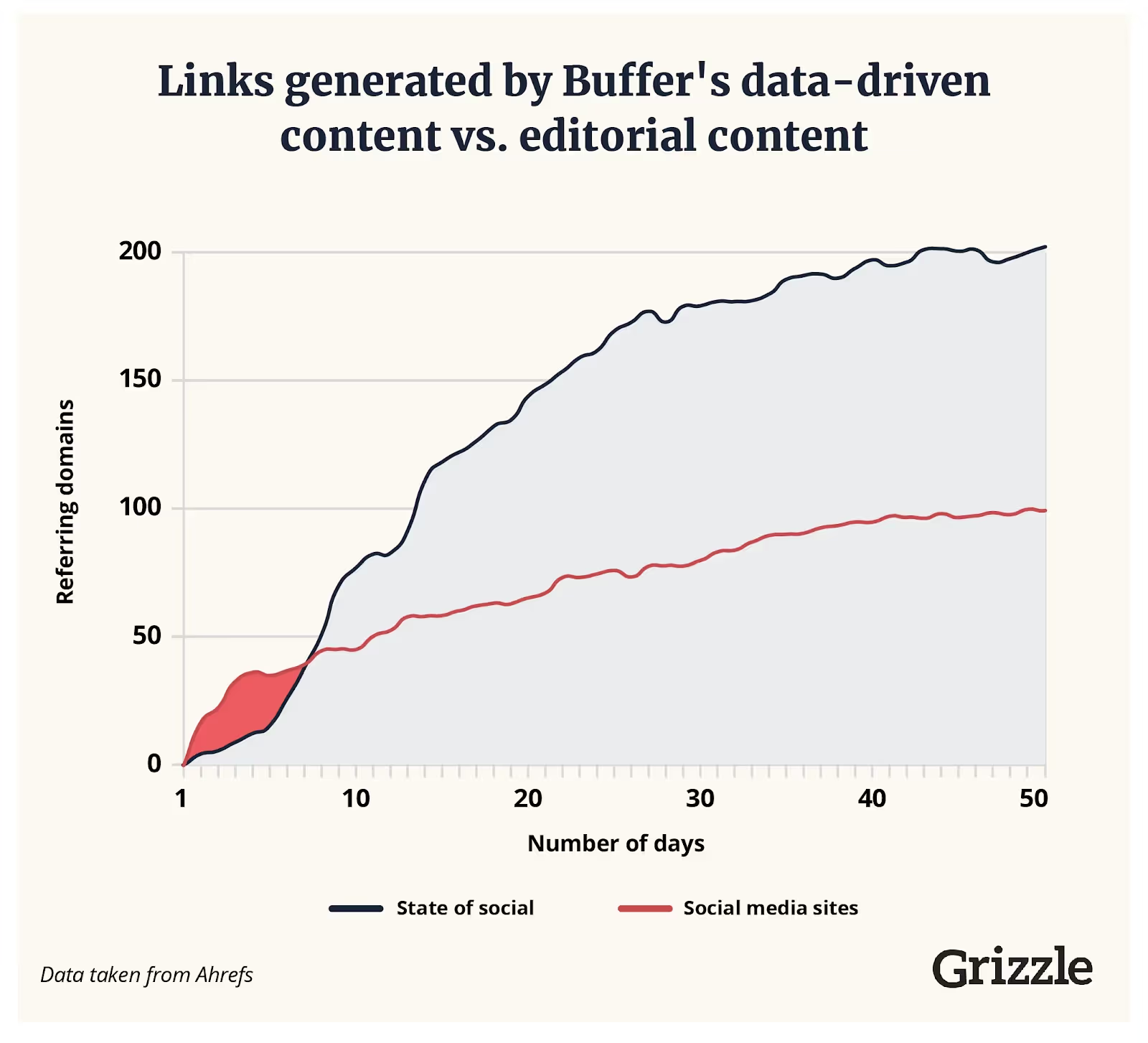
According to this data, LAV was 293% greater for “State of Social” than “Social Media Sites.”
Furthermore, “State of Social” generated 243% more links than “Social Media Sites.”
Before drawing any conclusions, we must factor in how Buffer has brand equity and a large existing customer base on their side. They already have the attention of other bloggers and journalists they can launch to in order to gain traction.
Where do other SaaS brands stand?
Data-driven content is one of the most linkable assets a B2B brand can produce.
But Buffer might be an outlier. Where do other SaaS brands stand when it comes to data-driven content and digital PR?
We’ve compiled a table of data-driven reports produced by 10 SaaS brands (including Buffer) and the number of RDs and backlinks they’ve each generated:
The number of RDs vary, even for well-known brands. However, considering the first result in Google has an average of 3.8x more backlinks than pages ranking at positions two to three, even a dozen or so links can make a huge impact.
The best way to generate backlinks is by producing content that link creators are hungry for. Clearly, for B2B and SaaS companies, these formats include proprietary data, studies, analysis, and expert commentary.
A key issue is that data-driven content doesn’t necessarily generate search traffic as a standalone asset. Not many people are searching for “state of social reports.”
So, to improve the performance of content across your entire topic cluster, use intelligent internal linking practices.
For example, Ninja Outreach increased search traffic by 40% just by fixing the internal linking between blog articles:
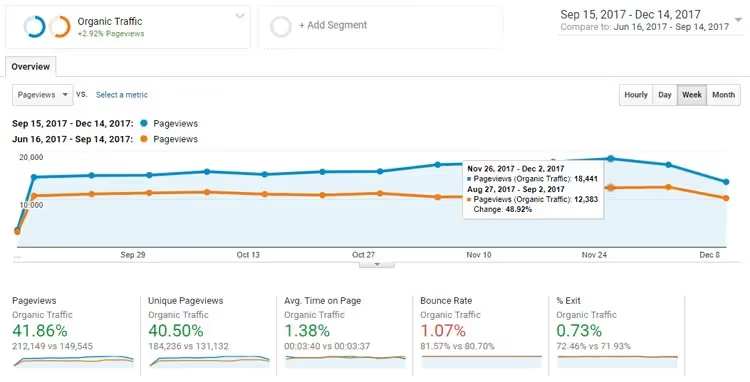
To further back this up, Google has explicitly said that internal links are important;
“Google must constantly search for new pages and add them to its list of known pages. Some pages are known because Google has already crawled them before. Other pages are discovered when Google follows a link from a known page to a new page.”
Building a digital PR strategy at the intersection of expertise, data, and growth
Based on this research, we can conclude the following:
- Links are critical for organic growth
- It’s far easier to generate links to data-driven content than editorial content
- Internal linking impacts organic traffic across our entire content portfolio
- Editorial content generates large amounts of search traffic for high-volume keywords (when done right)
Embedding data-driven content into a hub and spoke strategy is the best way to generate links and accelerate organic growth across the board.
A hub and spoke model that integrates data-driven content looks something like this:

Here, data-driven content acts as an "entry ramp" for backlinks to enter our content portfolio.
Let’s say your goal is to generate links from publications with a high domain rating (DR). Doing this increases the page rating (PR) of your data-driven content, which is then passed down to your content hub and blog articles, further boosting your topical authority.
Your data-driven content ideation should fit in the sweet spot between:
- What journalists and editors are hungry for;
- What the market is talking about;
- Your growth and demand generation priorities.
For example, if you’re looking to build topical authority in the “talent acquisition” space, consider running a study on “top hiring challenges among HR managers.” Avoid adjacent topics like performance management until you’re ready to enter that arena.
The same goes for promotion. Outreach and relationship building must be baked into your content distribution roadmap, allowing you to establish content-channel fit.
[[component]]
Reduce uncertainty with digital PR experimentation
Many SaaS marketers invest huge amounts of resources into data-driven content.
This can make a big impact, as link creators love to cite original sources in their own content. While no marketing endeavor is guaranteed to get results, the time and money involved in data-driven content creation may seem disproportionate to the potential ROI.
Therefore, a better approach is to run several low-effort experiments across a quarter or two.
This involves planning, producing, and distributing data-driven content, quickly, using the following process:
- Analysis & Ideation: Identify trending topics in the market and source data from owned or publicly-available sources. Create a unique narrative around your findings. Recruit subject matter experts across your organization to give commentary that link creators can use to build out their stories.
- Data-Driven/Creative Content Production: Package up your data and commentary in a way that link creators can deploy quickly and easily. This includes blog posts, visual content, and access to raw datasets (as long as it complies with data protection laws).
- Personalized Outreach: Get your content in front of the people it’s most relevant to. This is how you build long-term relationships and stand out in an inbox full of generic pitches.
Furthermore, give yourself multiple chances to win by coming up with several angles. For example, if a study on the “best cities for marketing careers” falls flat with marketing blogs, try recruitment or HR publications instead.
Build upon content formats with a high LAV by investing in more ambitious projects.
Diversify your content portfolio
Data-driven and creative content has been proven to generate links. If your goal is to accelerate organic growth, focus on the formats with a high link acquisition velocity (LAV).
Build out your topic clusters, produce content that link creators need, and utilize internal linking to create a content portfolio that ranks for even the most competitive keywords.


In this in-depth guide, you’ll learn the process we use to help brands like Pipedrive and Tide improve content quality, boost search visibility, and drive more user sign-ups.
Content maintenance: Detecting decay and improving conversions
Content maintenance is the process of monitoring your content and improving it based on leading metrics. This could mean adding new sections, editing and expanding on existing content, making technical tweaks like adding internal links, or testing new calls-to-action.
Why is this an important part of any organic growth program? Over time, a blog post will hit a peak of traffic. It will then typically lose traffic (slowly or dramatically) as it becomes outdated or competitors enter the fray with more up-to-date information.
This is especially true in fast-moving industries like social media or finance. Here, we see that a particular article quickly ranked for a highly competitive keyword in the social media space:
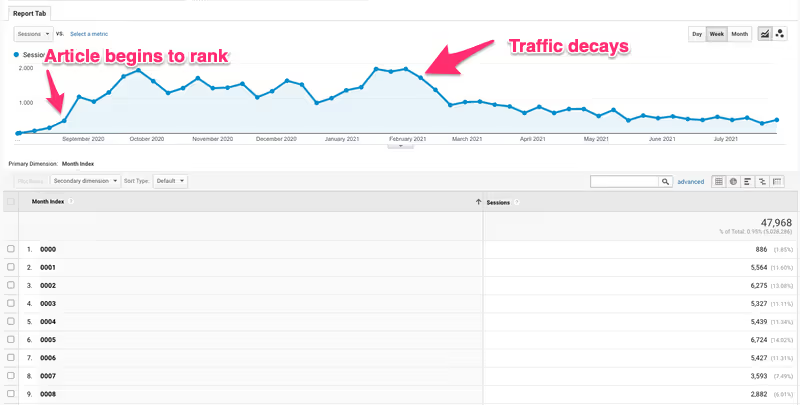
Due to the nature of the industry, other players create better content or update their existing guides to be more relevant. Slowly but surely, the article above was knocked from the top spot in Google.
Now imagine how this happens across an entire blog featuring hundreds of articles. Decay can add up to the tune of losing hundreds of thousands of unique monthly visitors.
So, how do we fix this problem?
Are you buying a car or investing in real estate?
Your blog acts as a portfolio of content and other digital assets. Much like brick-and-mortar investments become dilapidated through neglect, so does traffic and conversions that SEO-driven content generates.
Similarly, treat that same piece of content with care and respect, and you’ll see its value soar.
Content optimization systems don’t just protect you from traffic decay. They help you identify issues before they happen and take proactive steps to fix them. Similarly, they help you identify new and lucrative SEO opportunities.
For example, we helped a martech brand develop an aggressive SEO-driven content strategy to rank for highly competitive keywords in the paid media space.
Our goal was to solve their audience’s specific pain-points to demonstrate they’re the best solution for them while generating relevant search traffic.
One particular project was a “wiki” style guide, providing advanced information that provided readers with huge amounts of value.
We quickly captured the #1 spot in Google for our primary keyword, but over time ranked for the parent term. This presented an opportunity to increase traffic without creating a new piece of content.
We ran the article through our content optimization and refresh process and, in just 30 days, we increased search traffic to this single article by 301%:

The two processes that made this possible are:
- Content audits to measure the right metrics in a proactive way
- A content refresh and optimization process that puts data and audience needs first
Most marketers run quarterly or annual content audits. By the time problems or opportunities are identified, the competition already has a leg up. The longer you leave it, the harder it is to fix issues and capture new opportunities.
Instead, consider auditing your content weekly or monthly depending on the size of your content portfolio (i.e. the number of blog articles, landing pages etc. you have).
Similarly, a content refresh is more than simply adding the right phrases and terms to make content more relevant. It must fill newly identified gaps and overdeliver on value in a way that nobody else can.
To overcome these challenges, we developed the following content optimization process:
- Collect the right data
- Use a content audit tool to wrangle data and identify issues and opportunities
- Prioritize content optimization projects based on a) severity of issues or b) how lucrative each opportunity is
- Optimize each stage of the content journey (from SERPs to introduction to call-to-action)
- Track and monitor changes to pivot where necessary
The rest of this guide will cover these steps in detail.
1. Identify issues and opportunities with a content audit
The first step is to identify, wrangle, and benchmark the right data to identify issues and new organic growth opportunities.
A content audit that measures the entire content journey is key, which looks something like this:
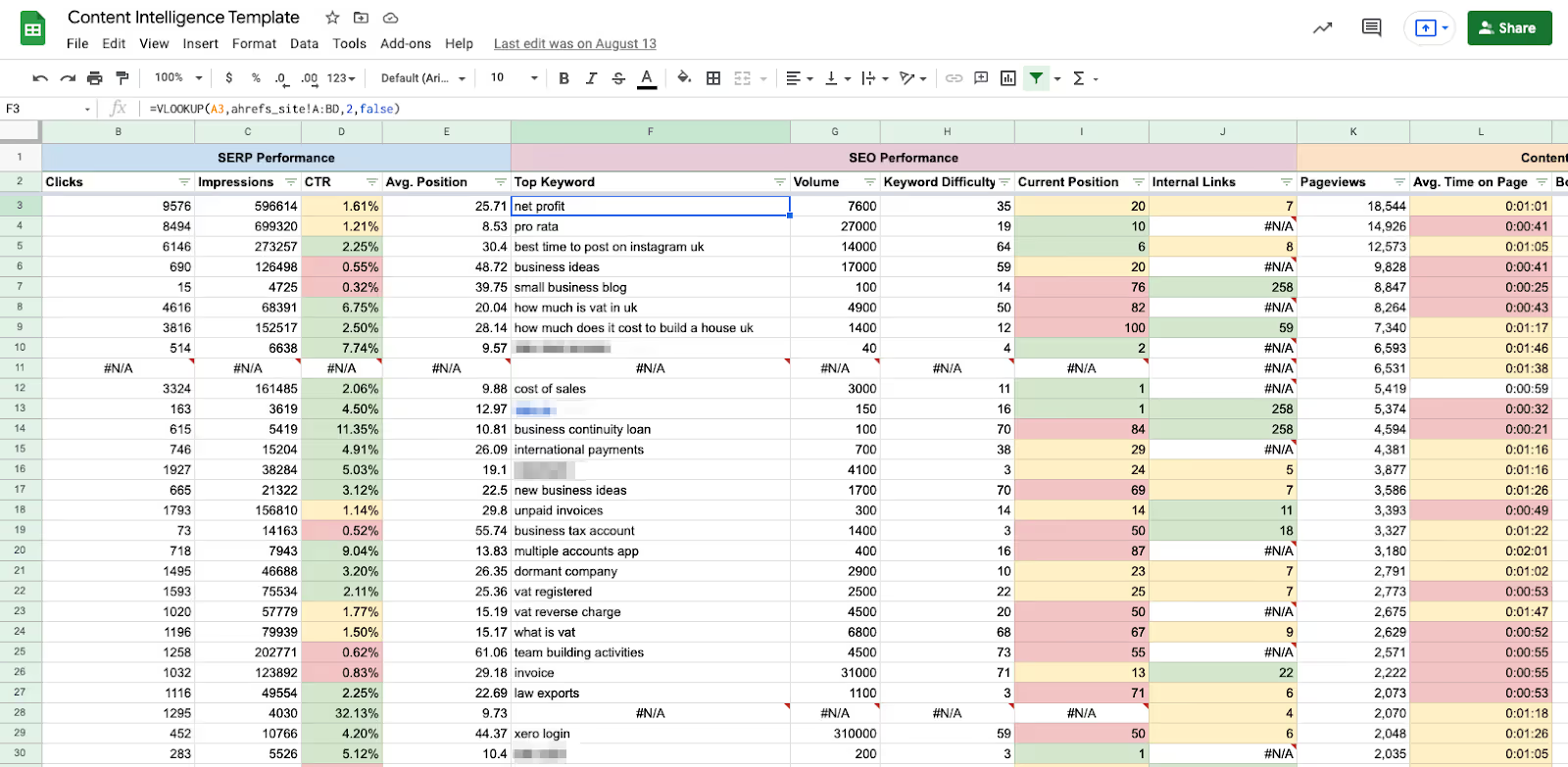
Here’s how to build a content audit tool step-by-step:
Collecting content performance data
Collecting content performance data only requires a handful of tools:
- Ahrefs/Semrush
- Google Analytics
- Google Search Console
- ScreamingFrog
- HotJar
Metrics are selected based on the reports needed to monitor each stage of the journey. For example, at Grizzle, we’d use data from a tool like Semrush to collect the following KPIs:
- Organic keywords that are being ranked across the entire site
- Specific keywords we’ve developed our content around
- Distribution and backlink performance
Similarly, you need engagement data, organic performance across each article, and conversions from Google Analytics.
Each of these data sources have their own sheet in the content audit, which looks like this:

Monitoring each stage of the content journey
Every interaction across that content journey can be measured. These interactions each play a part in the overall performance of your content.
Bring these metrics into a single view or sheet in this case to get a high-level overview of how content is performing across the entire journey. We call this the “Content Analysis” view, and is broken down by the following content journey stages:
SERP Performance
- Clicks
- Impressions
- CTR
- Avg. position
SEO Performance
- Top Keyword
- Volume
- Keyword Difficulty
- Current Position
- Internal Links
Content Performance
- Pageviews
- Avg. Time on Page
- Bounce Rate
- Conversions
- CR%
Distribution
- Organic Traffic
- Referring Domains
- URL Rating
- Dofollow
- Nofollow
Digging into SERP performance, you can see a “red amber green” (RAG) system under the CTR column:
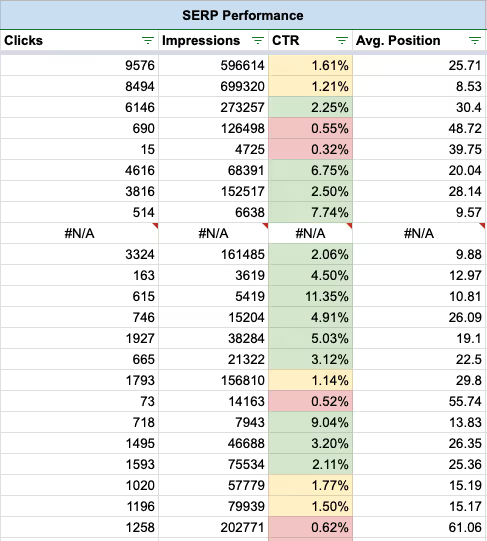
- Green means we’re hitting an adequate CTR from the SERPs. A healthy number of people are clicking through to our content when they search for something in Google.
- Yellow means things are “ok”, while red is a problem. As you can see, anything below a 1% CTR is cause for concern.
For SERP performance, CTR is our leading performance indicator. For SEO performance, there are two:

- Current position: Where content ranks for your “top keyword”?
- Internal links: How many internal links are pointing to this content from across the site
Note that “top keyword” is different to “primary target keyword:”
- Primary target keyword is what an article was originally written to rank for
- Top keyword is the keyword that the article ranks for with the highest search volume (no matter what position it’s in)
For example, in the report above, you can see that the top keyword for the first row is “net profit,” which has a search volume of 7,600. However, the primary keyword is “net profit margin”, which generates 2,600 searches a month.
Our content ranks for both, but the “top keyword” is not one we deliberately aimed to capture. We can use this insight to optimize content for broader keywords, increase search visibility, and capture more organic traffic.
This content audit may look overwhelming. For us, it started as a series of IF statements, VLOOKUPs, and conditional formatting. Start here and build out more sophisticated reporting as your systems evolve.
Once you’re monitoring opportunities and issues, it’s time to start fixing them.
2. Increase CTR and SERP performance
Why do people click on one search result over another?
Usually, it’s because the metadata aligns with what they’re searching for and communicates the benefits of the content.
This means your best bet of increasing CTR is optimizing page titles and meta descriptions.
Let’s start with page titles. When you search for a keyword, you’re often met with a series of results that look awfully similar:
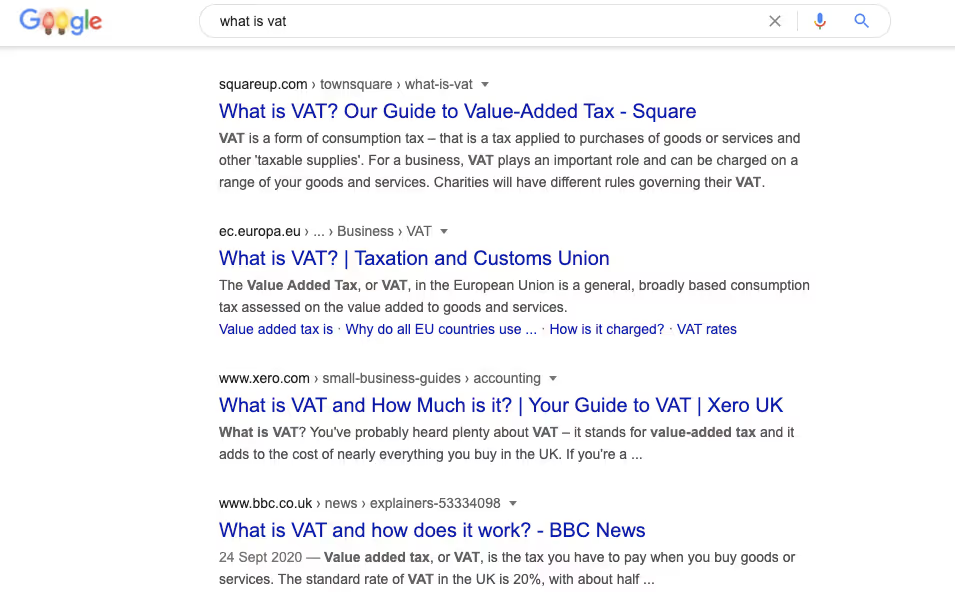
Luckily, Google has done a lot of the heavy lifting for us. These are the results that it deems most relevant based on user behavior. In other words, when a user clicks a result, it sends a signal to Google that their attention was captured when searching for a specific query.
The more people do that on a particular result, the more Google deems that page the most relevant result, and thus, it ranks higher.
While this is an important signal, most marketers use the SERPs as their single source of truth when researching elements of their content. They’ll simply emulate whatever they see on page one of Google and make a few subtle tweaks.
When writing page titles, a better approach is to emulate what Google is serving while using the language of your audience. This will not only let your content stand out, but show users that you understand their needs.
There are a handful of ways to do this:
- Speak to your customers and ask them questions related to the topic
- Ask questions in relevant communities
- Use audience intelligence and social listening tools
For example, following on from the “what is VAT” search in our screenshot above, we find the following relevant posts in Quora:
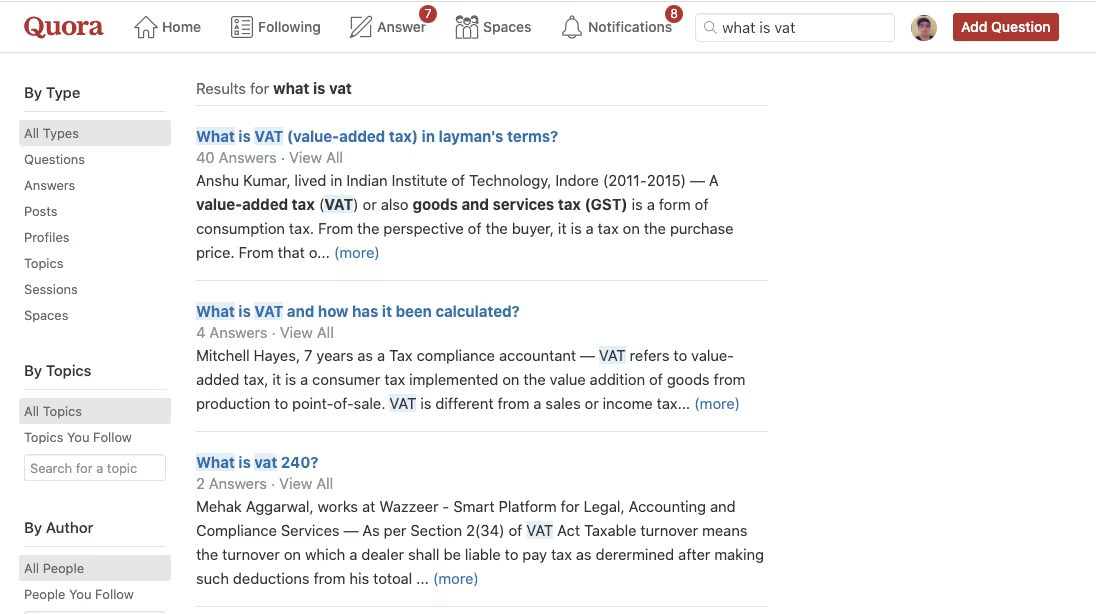
The most popular post asks for a definition in layman’s terms. Further research shows that our audience wants an easy-to-understand definition of what VAT is.
We can then take the language of this audience and use it in our page title:
“What is VAT? A Layman’s Guide to Value-Added Tax”
The same approach can be applied to the meta description:
“In this complete guide to VAT, you’ll learn how to calculate value-added tax and what it means for your business (current rate: 20%).”
Based on our topical research, we determined that the following elements are important to our audience and should be included in the article:
- A complete guide to VAT with everything they need to know
- How to calculate it
- Why it matters to their business in the first place
- What the current VAT rate is
We made sure our page title and meta description communicated these elements, first making sure that our content delivers on those promises.
Some of the pages on the SERPs do this, but few (if any) do all of them. This page title and description successfully ticks three boxes:
- We’re working to fulfill existing search intent
- We’re differentiating our content among a sea of “sameness”
- We’re talking the language of our audience
3. Improve internal linking across your content
Proper internal linking can have a huge impact on search engine rankings. For example, Ninja Outreach managed to increase organic traffic by 40% through a robust internal linking project:
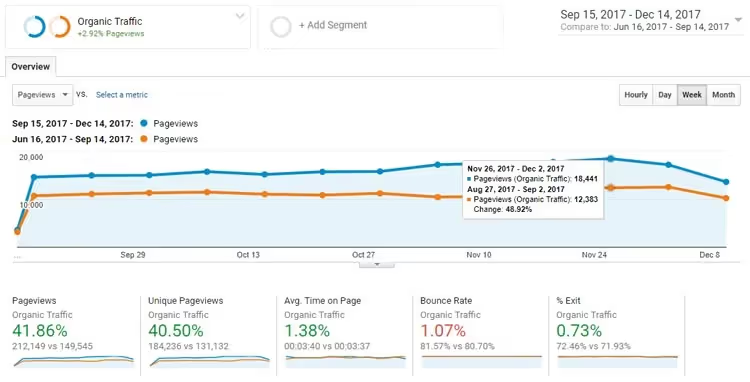
To find internal linking opportunities, simply group together pages of the same topic cluster and order them by page authority (PA) or URL rating (UR). Then, add internal links from relevant pages to the content you’re looking to optimize.
Alternatively, you can use the “Top pages” or “Best by links” reports in Ahrefs:
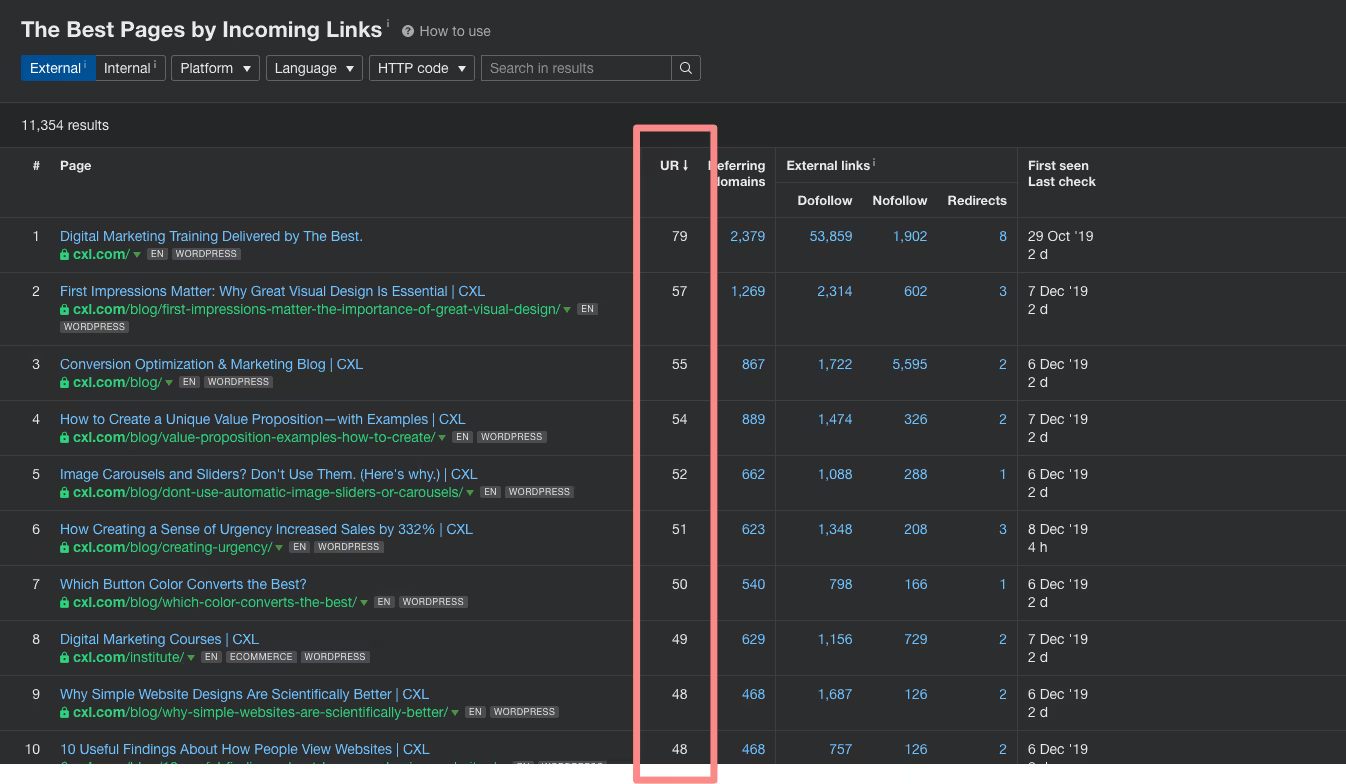
4. Refresh your content for higher search rankings
Content refreshing is the most powerful optimization tool at our disposal. Done right, you can see an increase in search rankings and conversions just by improving the quality, relevancy, and depth of your content.
There are over a dozen techniques we use to optimize and refresh content. However, the levers that make the biggest impact are:
- Using data-driven tools like Clearscope to improve relevancy and inject important themes
- Improving quality, information gain, and offering a unique angle
Clearscope is a foundational tool for making sure content is relevant. It collects data from IBM Watson and Google Graph Map to determine which themes Google deems most important for a primary target keyword.
Research by Backlinko found that “content with a high ‘Content Grade’ (via Clearscope), significantly outperformed content that didn’t cover a topic in-depth:”

But you can’t simply stuff new terms in your content and expect to see improvements. Instead, use these terms as a litmus for what you should include or expand on in your content. Give readers everything they need to understand and act on the advice you’re providing them.
Take the following subsection for an article on “self assessment statements” in UK:
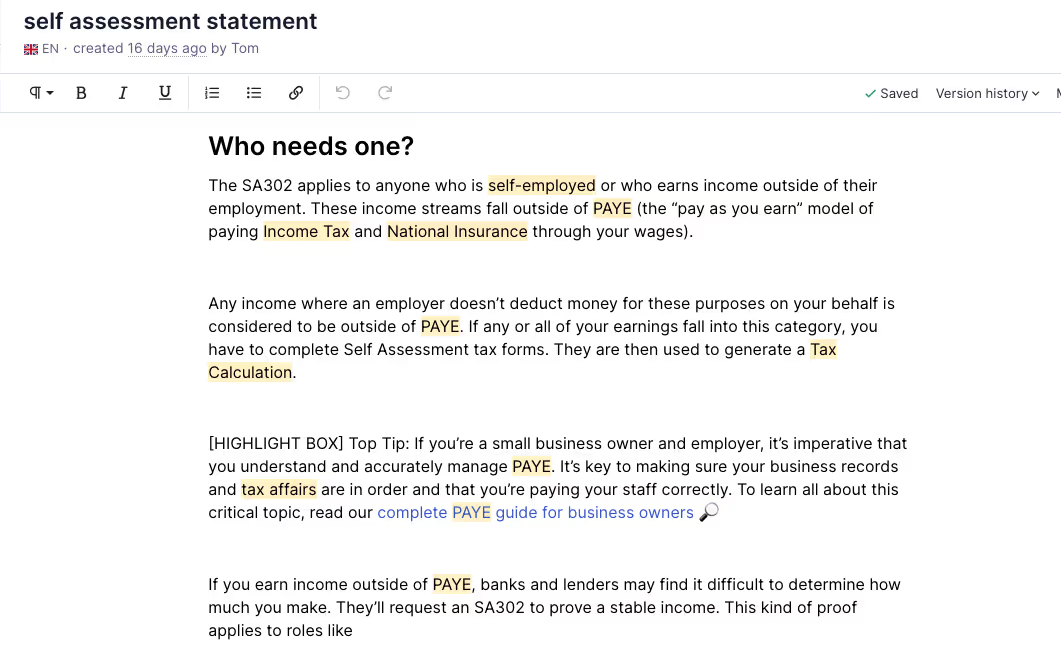
The highlighted text is what Clearscope deems “important” from an SEO perspective. The following appear in the subsection:
- Self-employed
- PAYE
- Income tax
- National insurance
- PAY
- Tax calculation
- Tax affairs
These terms aren’t “stuffed” into the content carelessly. They add context and value, building a detailed narrative and answering the question; “who needs a self assessment statement?”
When using data-driven tools, ask yourself why a term should be added. Does it need its own subsection to allow for a large enough canvas that explores the topic in as much depth as possible?
Don’t forget to expand on threads. These threads include the topics, ideas, and themes that are presented in the content that needs additional depth.
Close the loops started in your threads by including:
- Examples
- Detailed explanations
- Stats and data
- Actionable takeaways
These elements give your readers everything they need to take action. It also makes sure your content is comprehensive, which strengthens your moat and makes it harder for competitors to outperform you.
5. Boost content engagement by keeping your readers hooked
Low avg. time on page, bounce rates, and even low scroll depth (measured using scroll maps) happen when content fails to:
- Quickly hook the reader in
- Keep them engaged and excited throughout the content
- Deliver on enough value to instill a feeling of empowerment
Most people don’t have low attention spans, they have low consideration spans. You only have a few seconds to capture that attention by proving you have what a reader (or searcher) is looking for. Introductions that pique interest or make a bold promise are key. As are value-driven subheadings.
For example, in CXL’s article on app store optimization (ASO), the first section gives a high-level overview of what ASO is and why it’s important:
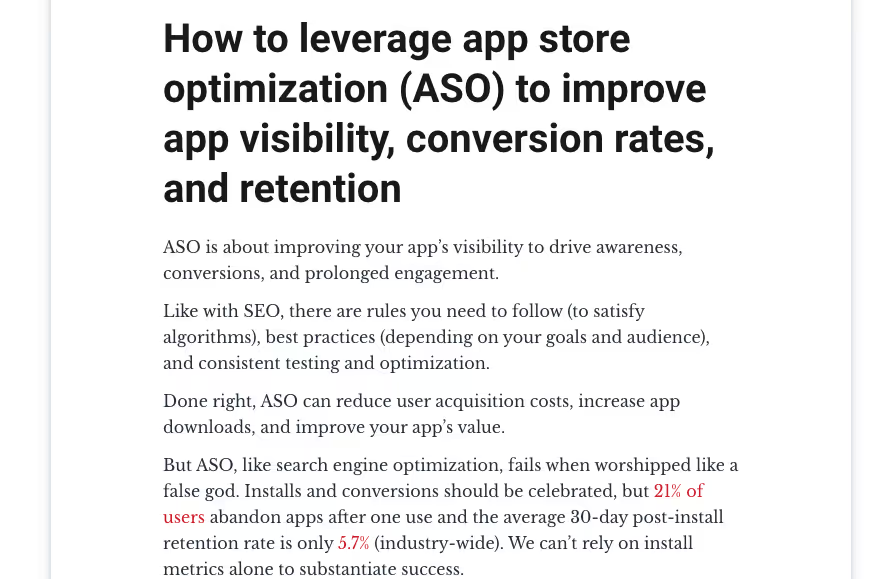
We could have just written “What is ASO?” Instead, the subheading communicates the specific outcomes that CXL’s audience of seasoned marketers are yearning for.
Once you have their attention, you must keep them hooked. This means communicating in a clear manner while overdelivering on the value you’ve promised.
Filler and fluff is your worst enemy. Every unnecessary word creates friction that prevents your reader from gliding through your content.
For example, here’s a subsection taken from another article from CXL on storytelling:

Let’s break this subsection down paragraph by paragraph:
Focus on shared interests and values. Speak to passions, relatable experiences, common problems, gaps in the market—whatever makes your audience feel connected to the message at a high level.
The first sentence of this subsection provides value in no more than six words. It continues by offering how to build intrigue (passions, experiences) and communicates why it’s important (it makes your audience feel connected).
Wealthsimple does this expertly in their digital magazine. Take this story about avoiding financial troubles under the pretense “It’ll Work Itself Out”:
We're then introduced to an example and supporting imagery of this principle in action. This makes our content easier to digest.
“It Actually Won’t” is a clever one-two punch. Immediately, the reader understands:
* This is a story about debt woes (a relatable problem, given that consumer debt in America reached a record high in 2020)
* Ignoring them will make it worse (debt denial and financial strain can lead to high levels of depressive symptoms)
80% of Wealthsimple’s clients are under 45. Because the familiar story is told by a peer and not a faceless brand, it works to build authority.
Here, a perspective of the example is shared, along with two clever components and an analysis on why they’re effective. We're not leaving the reader to connect the dots themselves, we're doing it for them.
Many readers see themselves in this story. Living paycheck to paycheck, even with a good job, saddled by debt, and paralyzed by calls from debt collectors.
This paragraph brings it back to the topic at hand. At the beginning of the subsection we talk about the importance of shared interests, values, and experiences. The way Wealthsimple does this is by sharing customer stories, which delivers a takeaway from the example.
The story pulls the reader in and incites a desire to learn more. What does this company have to offer me? Have they solved the author’s problems?
The section is then concluded while acting as a “bridge” to the next. We’re left wondering, “what’s next?” The answer is in the next section.
In just 190 words, this section provides the following "aha!" moments:
- The "ingredients" we need to build intrigue (values, experiences, etc.)
- Why those ingredients are important (to make the audience feel connected)
- An example of a brand that does this well (illustrating the lesson)
- A breakdown of why the example works so well (debt and financial strain is the shared experience of their audience)
- An additional outcome of this story (Wealthsimple builds authority)
- How this looks from the eyes of Wealthsimples's audience (they see themselves, trying to overcome debt)
- What I can do with this information (build intrigue to pull readers in and entice them to learn more)
As well as an easy reading experience, you must continuously teach users something new. Provide “aha!” moments as often as possible; either by presenting a new idea or reinforcing those ideas with examples, takeaways, and instructions on executing them.
At Grizzle, we call this “Aha! Velocity.” It’s the speed at which new information is shared or the rate at which readers connect the dots between existing ideas.
Increase your “Aha! Velocity,” make your content easy to read, and you’ll have high-performing content that people will read from start to finish.
6. Optimize conversions by testing new CTAs and offers
There’s no point in creating content that people love if it doesn’t contribute to your acquisition, retention, or demand generation efforts.
Low conversion rates from content usually occurs due to a misalignment between the offer and where in the journey your readers are at.
For example, if a user wants to learn the basics of “digital transformation,” it’s unlikely they’ll be interested in a service that does it for them (yet).
Instead, offer them templates, cheat sheets, and resources to make a case with their bosses. Build and nurture an audience and convert them into customers or users when the time is right.
For example, Pipedrive heavily invests in top-of-funnel content as part of an aggressive SEO strategy:
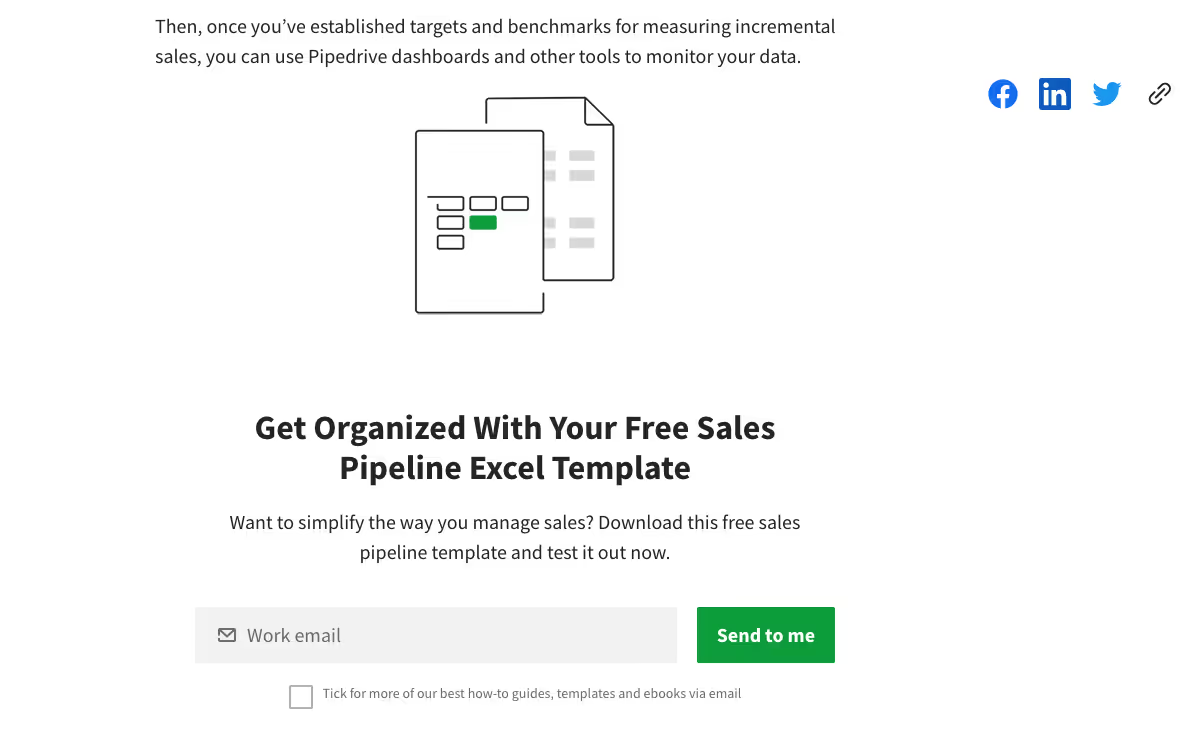
Here, they offer a relevant resource to help readers solve a job-to-be-done (JTBD) presented in the article. Pipedrive could have offered a free trial of their CRM, but understand the value in audience building and serving readers first.
On the flip side, someone looking for an alternative to HubSpot is probably ready to test out a new CRM.
Content should generate ROI. But not at the expense of audience building and brand equity.
Start a relationship with your users. Use your email marketing, social media, and retargeting capabilities to strengthen those connections by nurturing and educating them over time.
Strengthen your content portfolio
For those who have never optimized or refreshed their content, the first step is to conduct an in-depth content audit like the one presented in this guide.
Measure each stage of the content journey to identify issues that need fixing. Improve your CTR, refresh your content to make it more relevant, and you’ll begin to see your organic traffic soar.
[[component]]


In this article, we’ll share the content optimization methodology we used to help an enterprise software company get the following results by optimizing their existing content:
- 269.98% increase in organic traffic
- 202.41% increase in overall traffic
- 110% increase in user-sign ups
Let’s dive in.
🤫 We’ve included anonymized client data throughout this article. While we love a good breakdown, client confidentiality must come first.
What is content optimization?
Content optimization is the process of auditing and updating your existing library of blog posts, articles and case studies to increase organic traffic, engagement and conversions.
When conducting content optimization for the first time, it’s important to take a site-wide approach. Treat it as a project to maximize and capitalize on your existing content assets over a shorter period of time.
This article will show you the methodology to do this, along with advice on how to build an ongoing process as part of your broader content strategy.
Identifying optimization opportunities
It all starts with a content audit. By taking stock of your existing library of content, you can identify and prioritize the opportunities available to you.
Typically, we look for content optimization opportunities that sit within two lanes:
- Content that can be optimized to increase rankings in Google
- Conversion rate optimization (CRO) opportunities from content that generates sufficient traffic
For the former, the biggest opportunities are those ranking on page two or three for critical keywords. At Grizzle, we use data from Google Search Console, Ahrefs and various other sources to identify these:
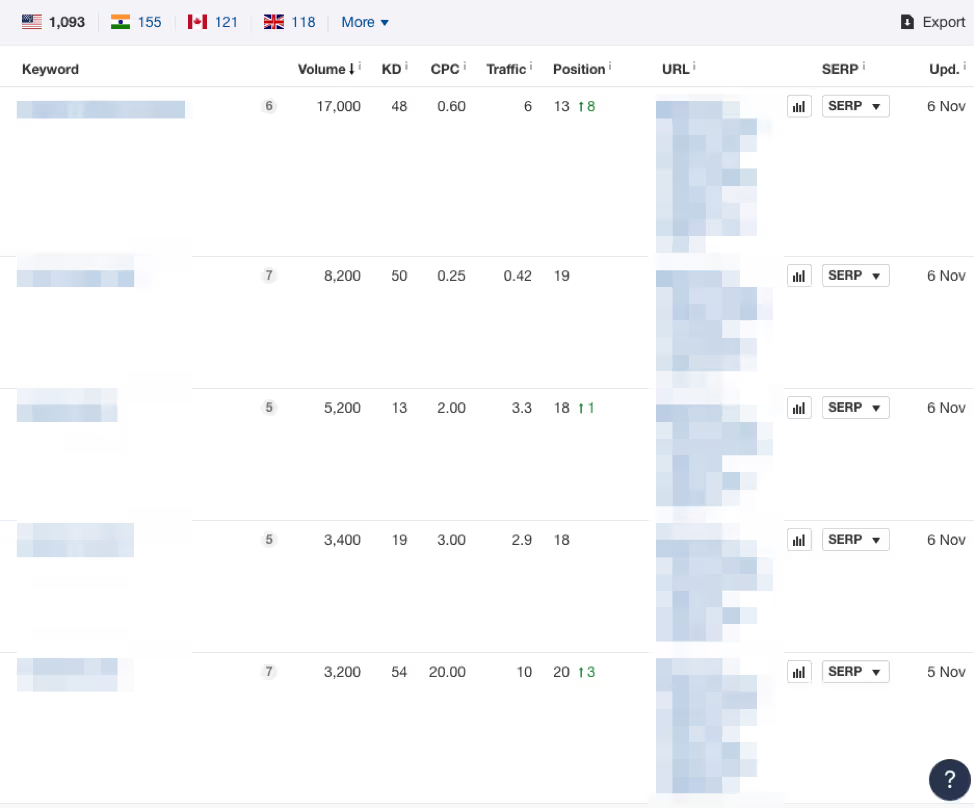
Using a scoring system, analyze each opportunity based on volume and keyword difficulty (KD) to evaluate how quickly you can improve results.
Each piece of content then goes through an evaluation process. This starts with the content asset itself, identifying areas that are outdated, gaps that need addressing and ways content can be improved for depth and originality.
Compare each article against your content competitors. Analyze top-performing articles, what they have in common and their weaknesses. We usually score content competitors against three categories:
- Content Competition: How comprehensive is the content? Does it include proprietary assets we don’t have access to? What can we add that they can’t?
- Backlink Competition: How many domains are linking to them? How fierce is the competition?
- Content Opportunities: What do we need in order to create the best piece of content on this topic and overcome the competition?
Clearscope is another tool we use at this stage, which provides data that drives what information to include in our updated content.
Re-distributing content is a critical part of the optimization process. However, backlink acquisition is not always necessary. If our content provides a better experience (and is more comprehensive in nature), then it’s possible to beat the competition simply by making our content stronger.
In fact, this is exactly what we did for another client that was stuck at the bottom of page 1 for a competitive broad term in the marketing space. After updating the content and optimizing it for this specific keyword, we ended up increasing organic traffic by 287%:

In another example, this article we created for Sales Hacker outranks the likes of HubSpot for a keyword that’s hard to rank for. Even though it has far fewer backlinks than other results, we still outrank them:
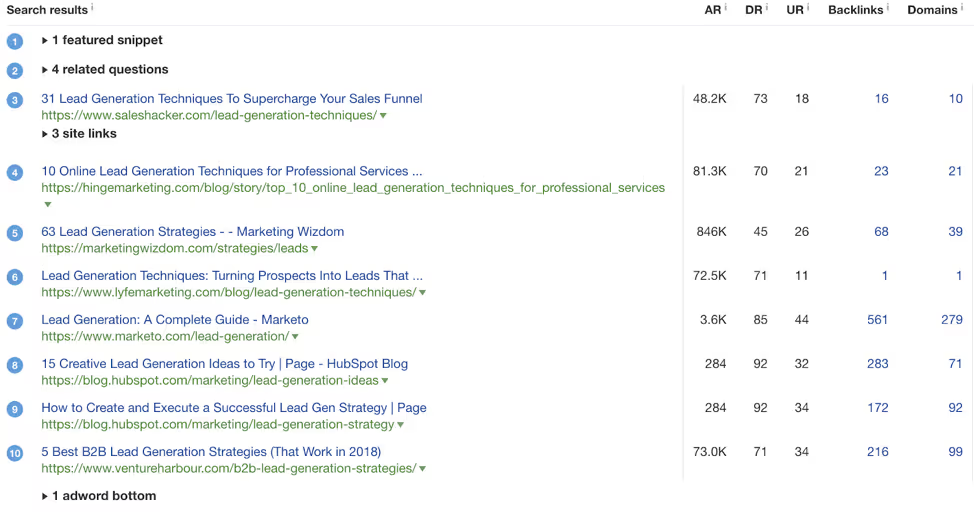
Finally, decide whether your content simply needs something extra (two or three paragraphs here and there) or a complete overhaul. If all it needs is some additional value, we’ll usually edit the content and fill any necessary gaps. However, outdated or shallow content often needs producing from scratch.
Planning and producing optimized content
With your optimization opportunities revealed, create a content brief to define your goals and create a detailed outline.
This brief should include competitor information (detailed above), SEO data and influencer marketing requirements. Thorough planning will improve the likelihood of success. To do this, you must aim for a delicate balance between giving Google what it wants, writing for people and making the content as original as possible. Luckily, you can have your cake and eat it too.
Use the data uncovered in the previous step to direct your content outline, ensuring it covers all bases while providing an original and value-driven narrative.
At Grizzle, we do this by collaborating with subject matter experts and content creators. They lend their insights, expertise and stories to provide a fresh perspective. This journalistic approach to content creation builds credibility, and helps distribute content through existing audiences.
While there are dozens of ways you can make your content original and valuable, some of our favourites include:
- Taking a fresh approach: Don’t follow the SERPs. Instead, look at what people care about right now, and tailor your content to those immediate needs.
- Adding depth: Provide additional advice and takeaways on granular ideas. Expand upon threads wherever possible.
- Collect proprietary data: Tap into your audience and use owned data to conduct research or uncover trends.
- Experience & design: One thing I still love about Brian Dean’s content is his use of design (like in this example). Can you create a bespoke experience for critical and strategic content pieces?
- Contributions & citations: Involve other thought leaders and experts in the content creation process. Not only does this enhance your content, but it provides access to a new audience.
You can also tap into visual content and video to enhance your content experience. For example, in the first section of this article, you saw an animation we created describing the optimization process. You can also create something as simple as an animated gif, like we’ve done for this article on bottom of funnel content:
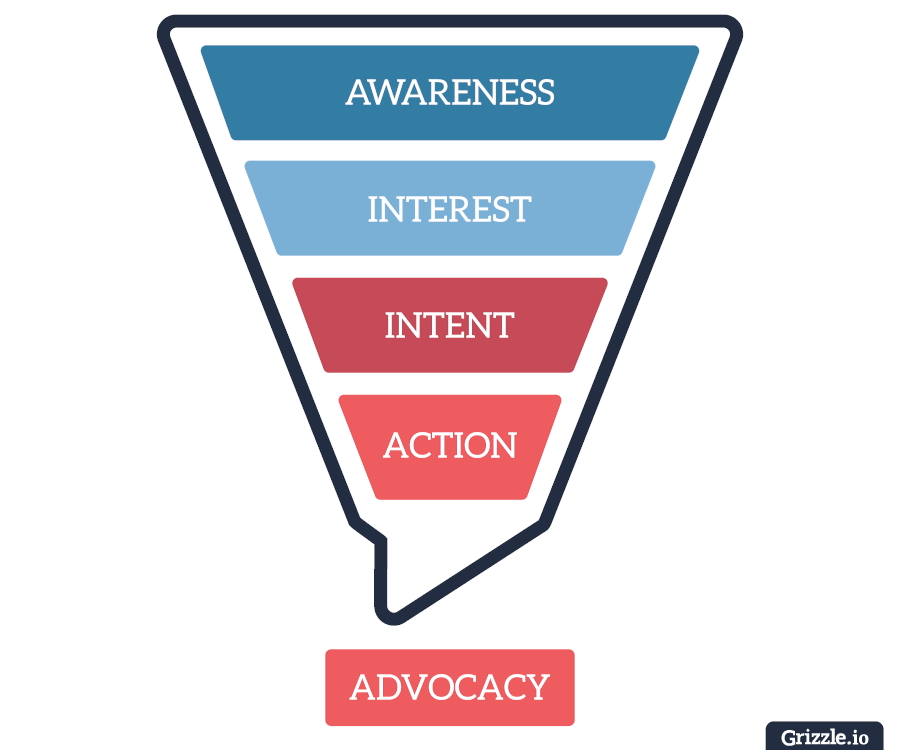
Most importantly, ensure that your existing content aligns with your current content strategy. For example, if you’re currently attracting new audience segments, moving upmarket or pivoting your distribution strategy, some articles and blog posts may no longer be relevant.
During the auditing process, focus on and prioritize the content that aligns with your current priorities.
Grouping together and merging similar themes
On top of optimizing individual blog posts, keep an eye out for content with overlapping topics. As part of the auditing process, group together content that covers similar themes.
For example, you may have recently created an article that provides in-depth and up-to-date advice on writing great ad copy. During your audit, you find the following complimentary articles:
- “How to Write Ad Headlines”: The term “ad headlines” generates 250 searches a month, and warrants its own article. Instead of merging this with your latest piece, update it and include an internal link.
- “X Principles of Great Ad Copy”: Upon inspection, this article might be several years old and extremely thin. Therefore, take relevant elements for your updated content and create a 301 redirect.
- “How to Write Ad Copy To Generate Leads”: While this may first seem like an overlapping topic, you may find it’s a common customer challenge. Make sure you exclude content that serves a specific purpose (conversions, sales enablement etc.) from the merging process.
Look at each blog post through a discerning lens. Check your analytics data to see how it’s performing across the entire funnel. Check-in with other teams to uncover the content that makes up their own toolkit.
This will help you increase your traffic, demand and acquisition efforts while maintaining the integrity of your growth engine.
Optimizing content for conversions
The second optimization lane involves taking a conversion rate optimization (CRO) approach. These are identified by identifying content assets that are generating a high amount of traffic, but can be improved for conversions.
To find these right experiments to run, ask yourself the following questions:
- Does the offer match the information the audience is looking for?
- Are we offering something of true value?
- What calls-to-action (CTAs) are being used?
- What CTAs is most appropriate for this audience?
For example, most senior decision-makers are looking for strategic advice. Therefore, it’s unlikely they’ll be interested in downloading an eBook that offers advice on a tactical level.
Furthermore, different audiences are sensitive to certain CTAs. Exit-intent pop-ups may work, but some audiences have been conditioned to ignore them. Sometimes it creates enough friction for them to abandon content altogether.
In-line CTAs are an effective and non-intrusive way to drive action. In the example below, Pipedrive has a simple in-line CTA that offers additional content around the topic the reader is currently engaged with:
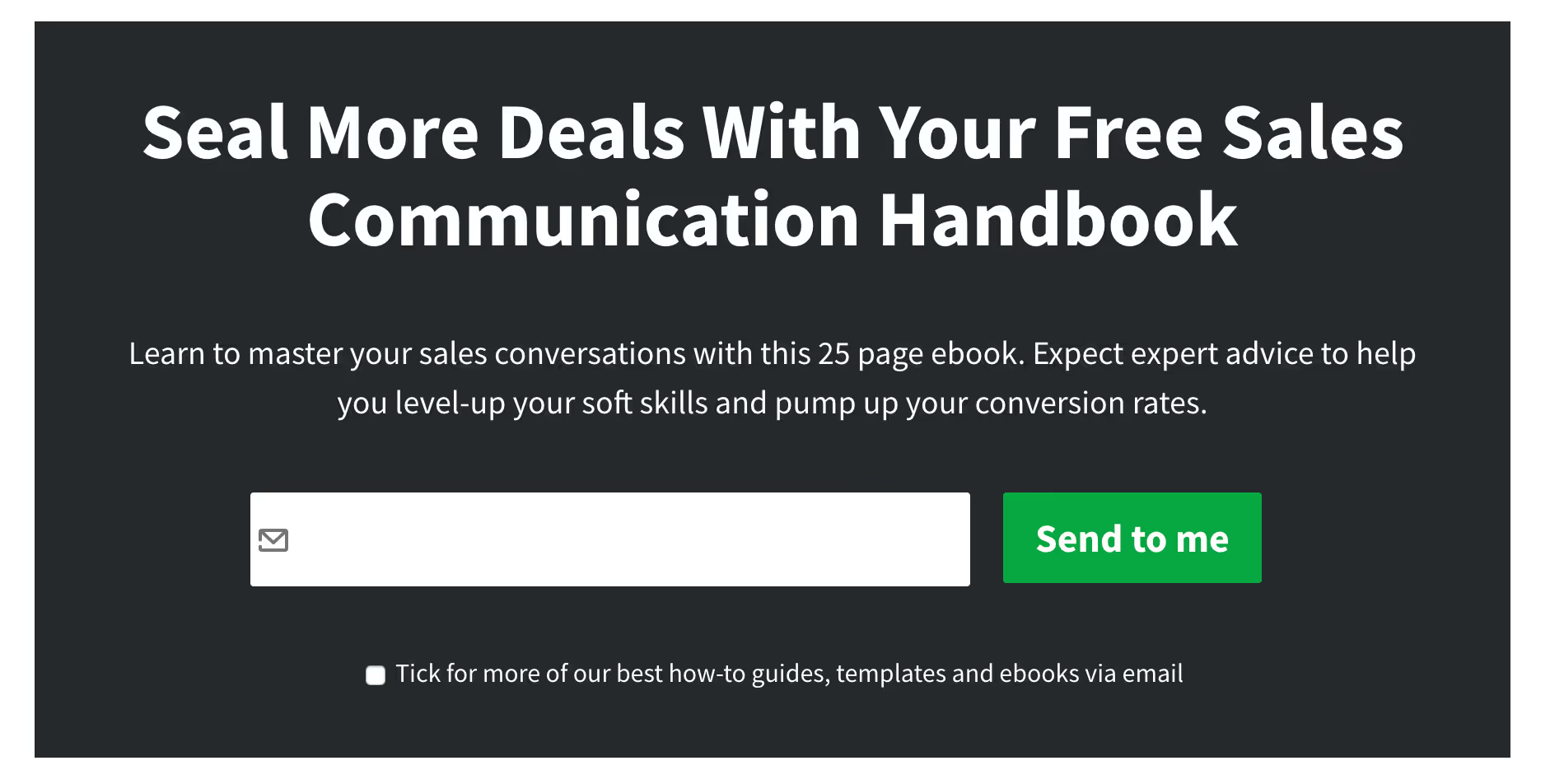
The offer itself is as important as the CTA. How does your lead magnet add additional value beyond the content users are actively engaged with?
The answer: craft lead magnets and offers that serve overarching themes.
For example, an ebook or training video about ad copy could be used on articles that talk about headlines, landing pages and Facebook ads.
Find the perfect balance between your offer, CTA and the placement. Take your audience into account, and consider crafting tailored offers or lead magnets for individual articles.
Re-distributing updated content for fresh eyes
With our content polished up and updated, it’s time to promote. Content distribution is key, but there’s no point in wasting time on ineffective channels just because they exist.
Start with people who shared and engaged with the original piece of content. BuzzSumo is useful for uncovering these individuals:
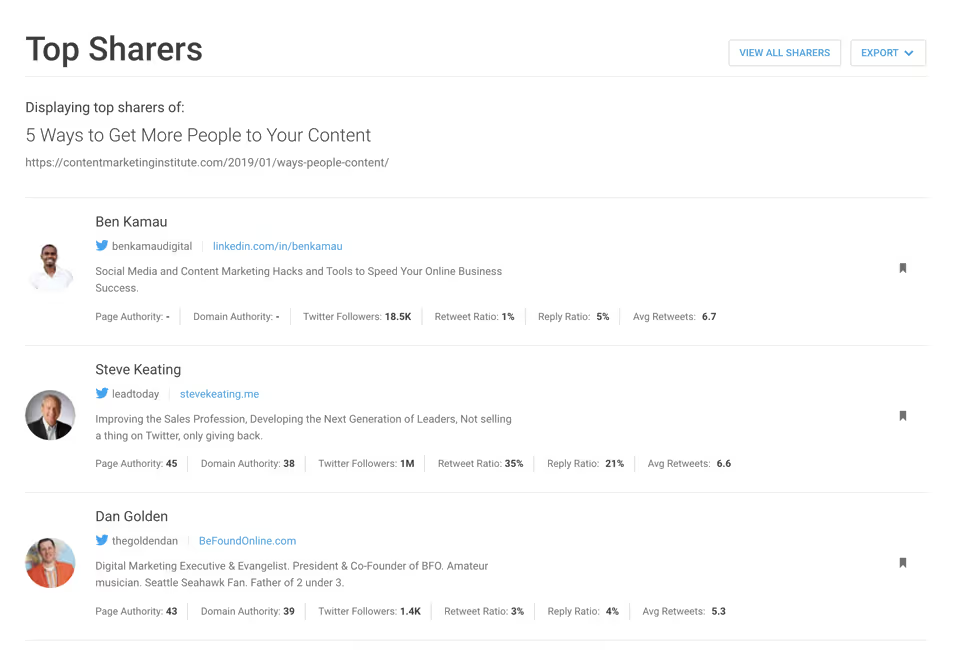
Strong relationships are foundational to content promotion. Being a trusted face on your primary channels will help your content be welcomed with open arms. This goes for all distribution approaches:
- Community engagement: Become a welcome face. Contribute to the conversation and become a trusted source of advice.
- Influencers: Get them involved with your content production. This not only provides you with a new audience to reach, but also makes your content more original.
- Link building: Build relationships with publications and creators. Find ways to add value, collaborate and build relationships. Avoid cold email at all costs.
Don’t forget about your owned assets. If your content has been given a new lease of life, relaunch it to your email subscribers and social media followers. Summarize new elements, and tell them what they’ll learn in this improved version.
An ongoing optimization process
The steps outlined so far will help with one-off auditing and optimization projects. However, it’s well worth building an ongoing content optimization process.
Why? Because it can future-proof your rankings and organic traffic. During Google’s May 2020 core update, Neil Patel (love him or hate him) analyzed 641 websites that updated content on a daily basis:
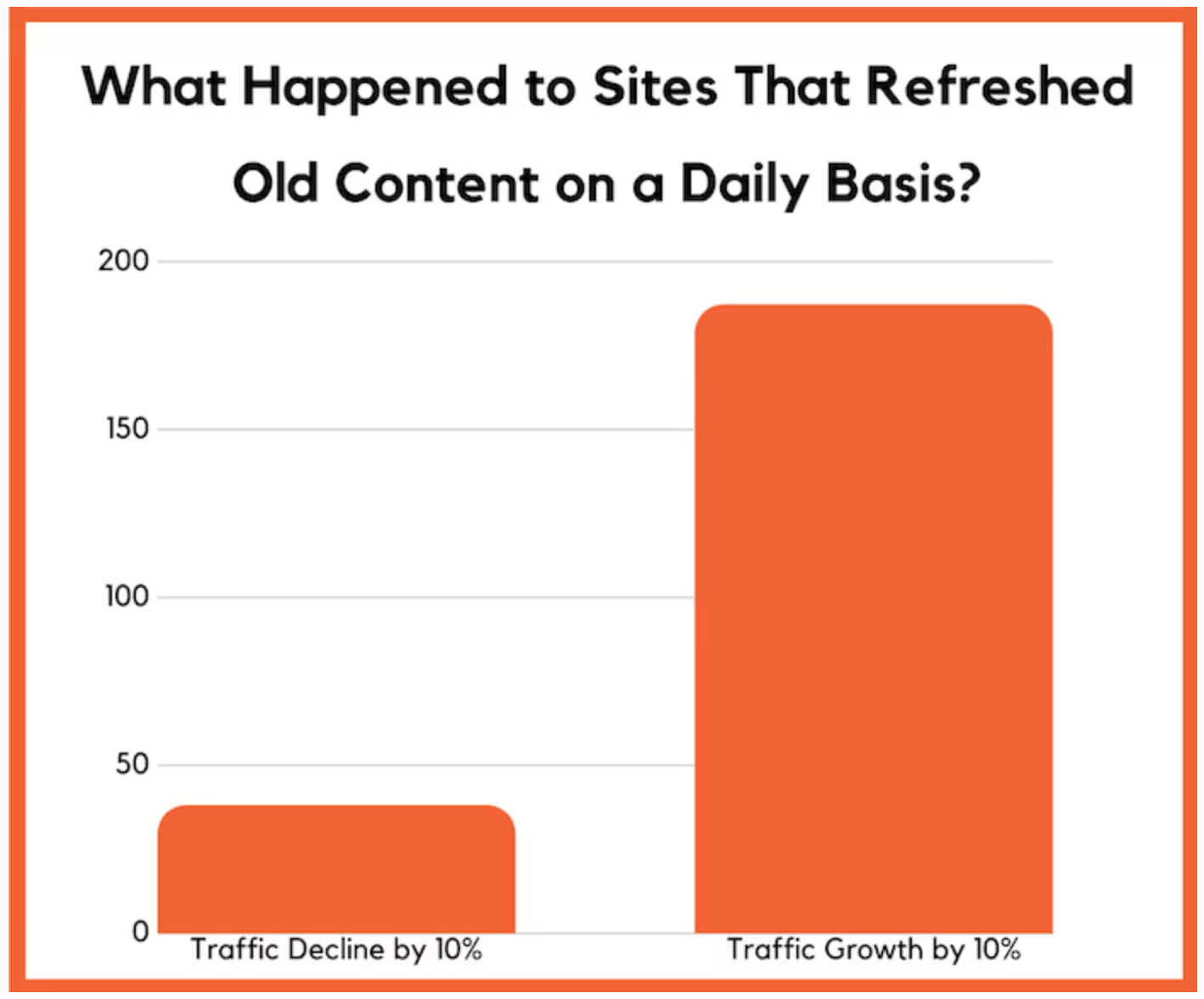
He found that only 38 of these sites (5.92%) saw traffic decline by 10%, which is extremely low for the volatility seen during the update.
However, 187 of those sites saw traffic increase by 10%.
Keeping content fresh and updated on a regular basis will not only increase your organic traffic and conversions, but can protect you against future algorithm updates.
Building an ongoing optimization process requires the following elements:
- Monitor market trends: What changes are happening in your industry that may affect the accuracy of your content? Social media marketing solutions, for example, will need to audit their content whenever a platform updates existing features or launches new ones.
- Monitor your rankings: When you start to see traffic dip, it’s time to act. Keeping your content updated (especially when targeting competitive terms) will help you increase and defend your position on the SERPs.
- Monitor conversions: CRO is a complex battle, so you’ve got to pick your battles wisely. Consider monitoring content against benchmarks and use fluctuations to inform your priorities. Alternatively, identify the 10% that contribute to strategic goals, and go all-in on those.
Building a reactive and pro-active process will help you improve results over time. Even a small 1% increase will compound over time. Start with the metrics that matter most, then build processes to act on them using technology and talent.
Conclusion
Your content optimization efforts must align with your existing strategy. It’s only worth optimizing content if it still has a place in your customer journey.
The philosophy behind content optimization is simple: Treat every piece of content like an asset. Re-invest in relevant content that will help you get better results.
A thorough content audit will show you what to keep, optimize and merge. Prioritize content that will make the biggest impact first, and you’ll quickly make a case for ongoing optimization with the boardroom.


What is bottom-of-funnel (BOFU) content?
Bottom-of-funnel (BOFU) content helps your audience research products and solutions. It’s designed to educate buyers that your product is the best option and overcome objections.
While BOFU is designed to convert, it must still add value to readers.
Common bottom-of-funnel content formats include:
- Comparison pages
- Product listicles
- Case studies
- Explainer videos
Content at this stage of the funnel:
- Eases prospects past their objections and builds enough trust to take action (e.g. book a demo or sign up for a trial)
- Gives solution-aware prospects the information they need for product research
Top-of-funnel (TOFU) and middle-of-funnel (MOFU) content have slightly different goals. They build awareness and capture users early in the customer journey.
BOFU content directly contributes to customer acquisition.
For example, here’s a BOFU article we created for Pipedrive. It teaches their audience how to create client reports—a common jobs-to-be-done (JTBD):
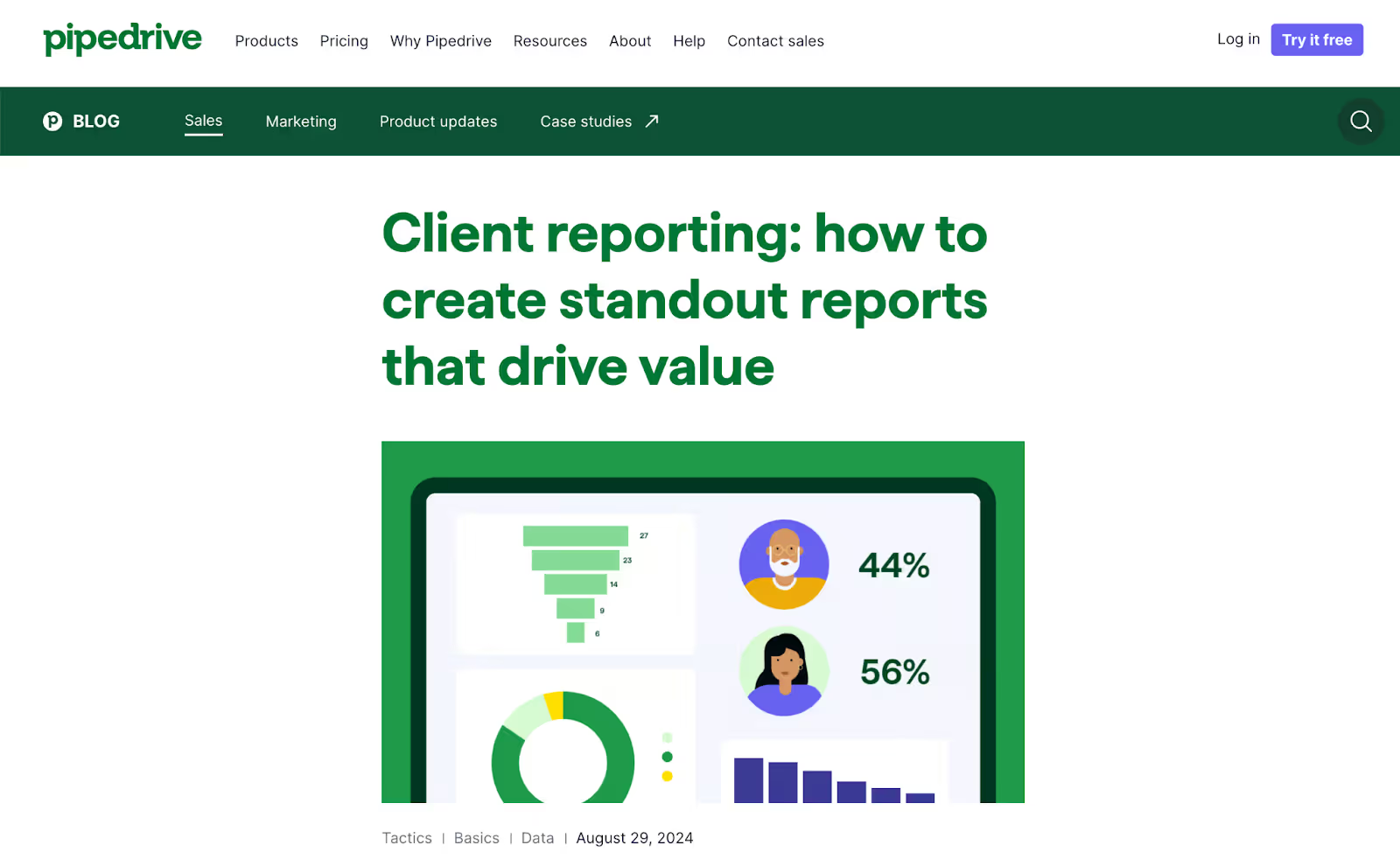
It offers practical advice and tips on what to include in client reports. More importantly, it walks readers through creating them using Pipedrive’s reporting features.
We call this product-led content, which adds value and teaches users how to solve relevant problems with your product:
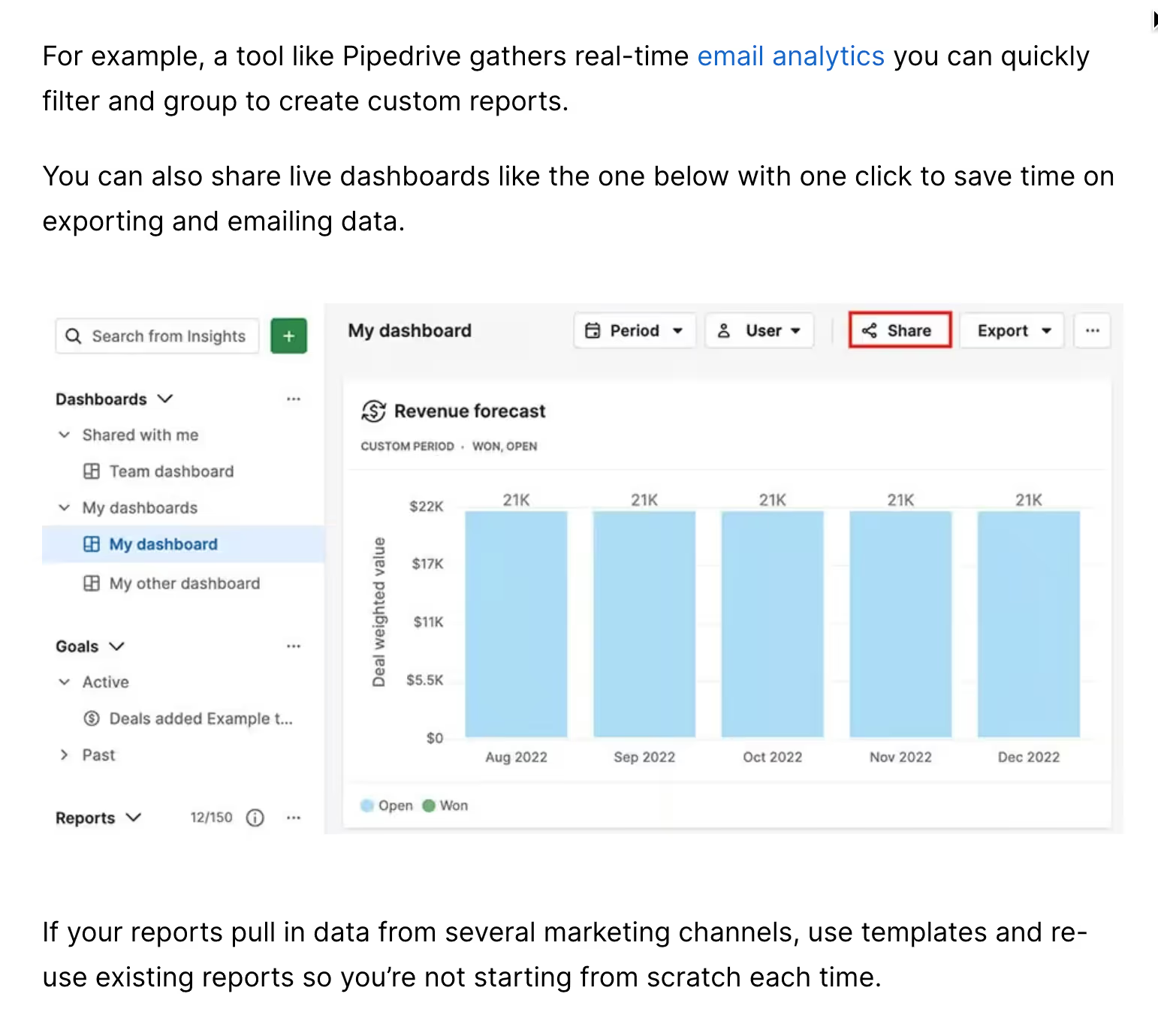
Further down the funnel, you can create product content to attract in-market buyers.
Like this article we wrote for HiringBranch listing the best candidate assessment tools:
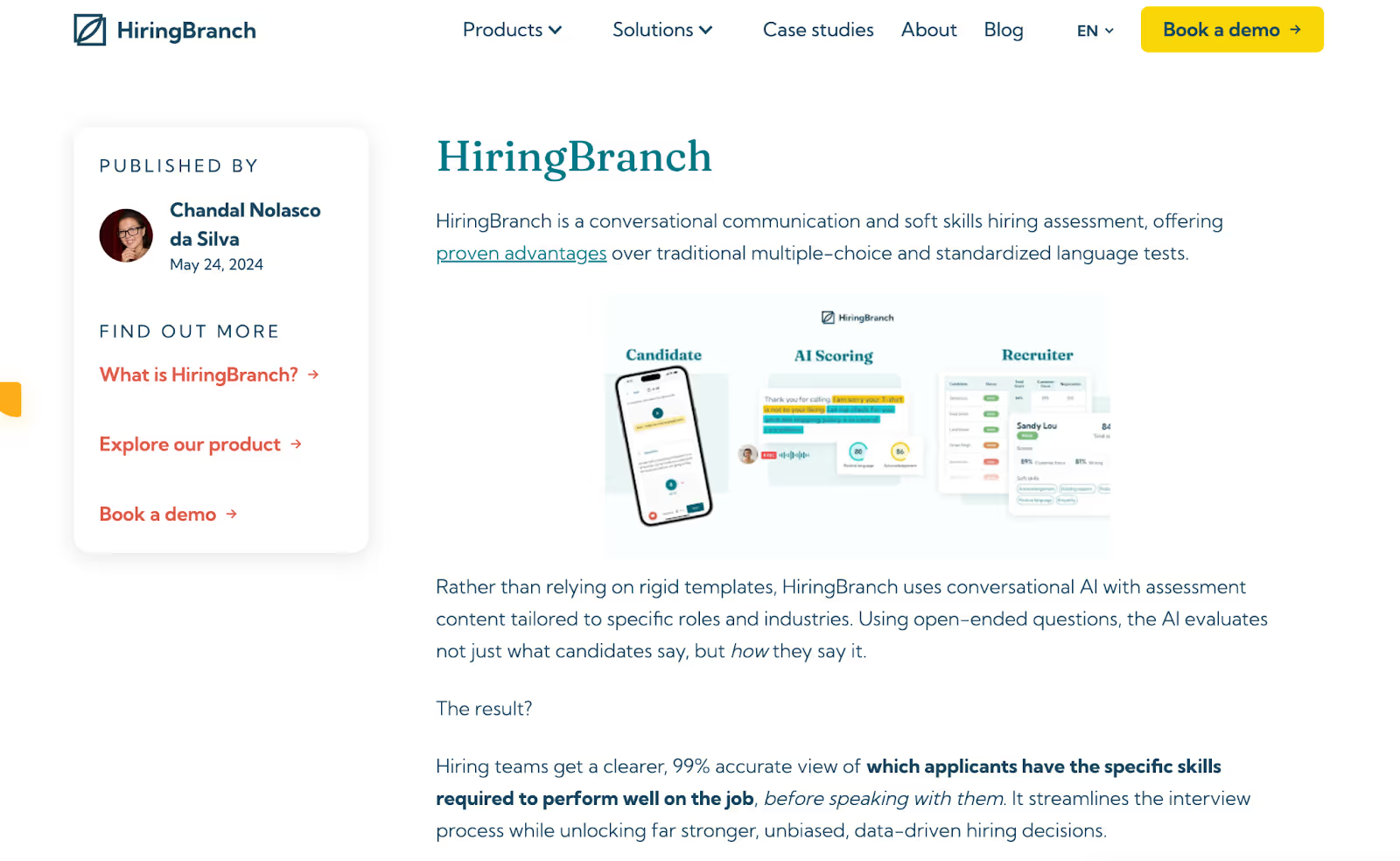
This piece of BOFU content:
- Gets HiringBranch’s product in front of searchers looking for their product
- Adds huge amounts of value for readers researching their options
- Includes a relevant CTA to sign up for a demo
Both top- and bottom-of-funnel content have their place in the marketing mix.
For B2B and SaaS startups getting started with content and SEO, it’s best to focus on the latter.
Why? Because revenue and growth are your core priorities. BOFU content gets you in front of the buyers who are looking for your product right now.
[[component]]
How to find bottom-of-funnel content topic ideas
To find the right BOFU content ideas, you need to understand why customers buy from you.
- Not just: “Our customers need an invoicing tool.”
- But more like: “Our customers want to send invoices and reminders on mobile devices. They don’t want to chase clients to get paid.”
“Mobile invoices and reminders” is the what. “Not having to chase clients” is the why.
Which is exactly what this Tide article covers:
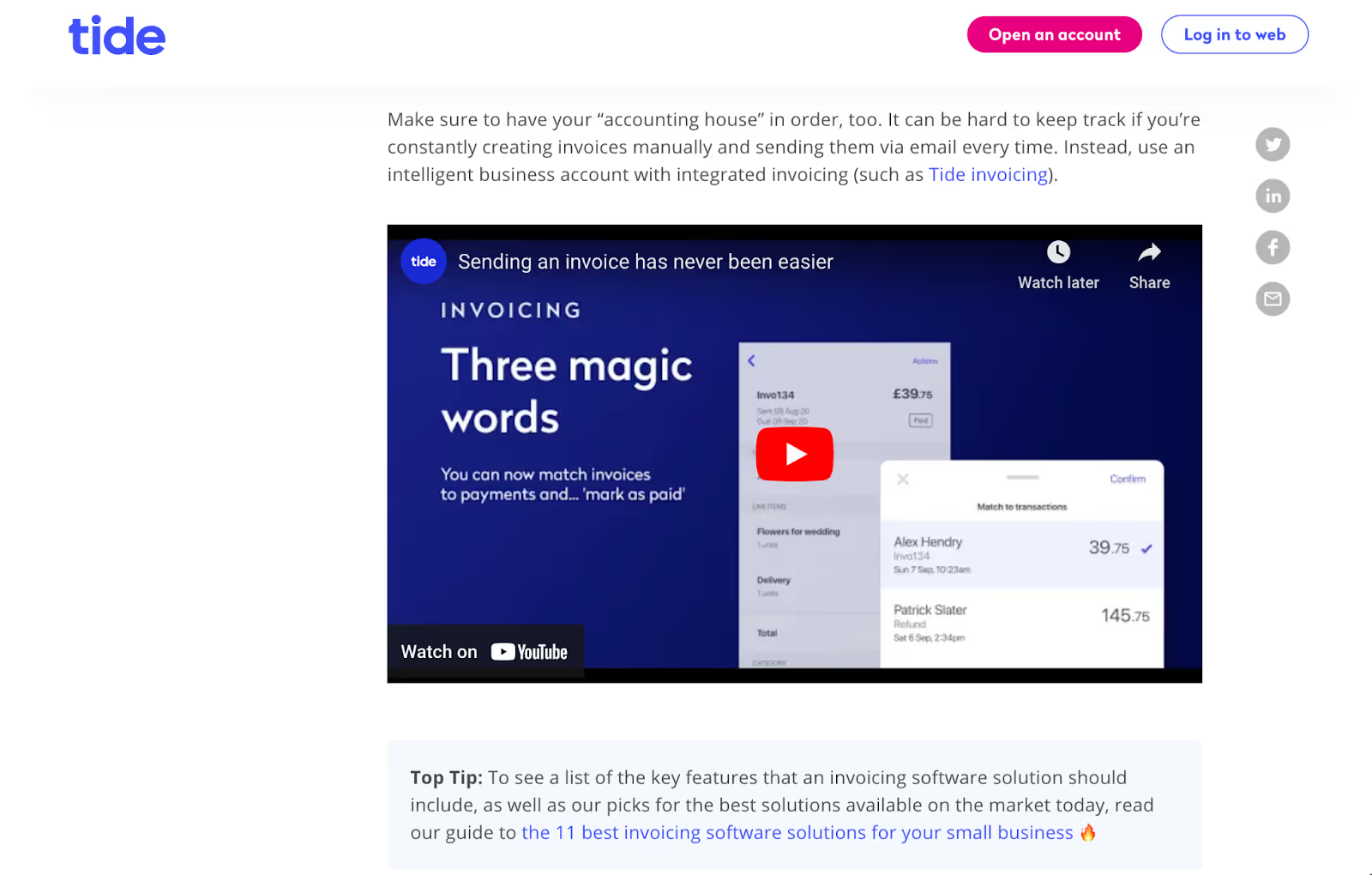
Here’s how to conduct BOFU content topic ideation:
Interview your customers
Customer interviews will uncover insights to improve your messaging and help you understand:
- Which problems you help customers solve
- Why they invested in your product
- What positive and negative experiences they’ve had
The key to effective customer interviews is to a) be direct and b) ask good follow-up questions.
This is where you’ll find their true motivations and insights you can act on.
Here are some examples of initial and follow-up questions. We've based these on hypothetical customer responses for an asynchronous meeting platform:
From these initial and follow-up questions, you might learn:
- Customers choose you over competitors because you keep meetings organized and on track.
- Teams are able to spend more time on deep work and implement a four-day workweek.
- Automated minutes would allow teams to clearly communicate and stay present during meetings.
- Customers send voice messages over video because they feel it’s easier to hit record. They don't have to worry about their appearance.
- Screen sharing isn’t a priority because Loom offers a best-in-breed solution. Customers would rather see an integration.
Take these insights and use them in your BOFU content. Be open to critical feedback. You’ll discover ways to improve your content and messaging.
How we'd use these insights to create content for clients:
Using the responses above, we could write a “Zoom comparison article.”
If we were writing it for them, it would emphasize that it helps customers save time and improve productivity as key differentiators.
We’d even share how one customer implemented a four-day workweek—all thanks to the number of hours saved.
This would position them not just as a meeting tool, but as a way to improve remote working cultures.
Customer interviews allow you to collect feedback from your customers. You can ask follow-up questions and understand their trust motivations, challenges, and goals.
You can also send email surveys—like Miro have done here:
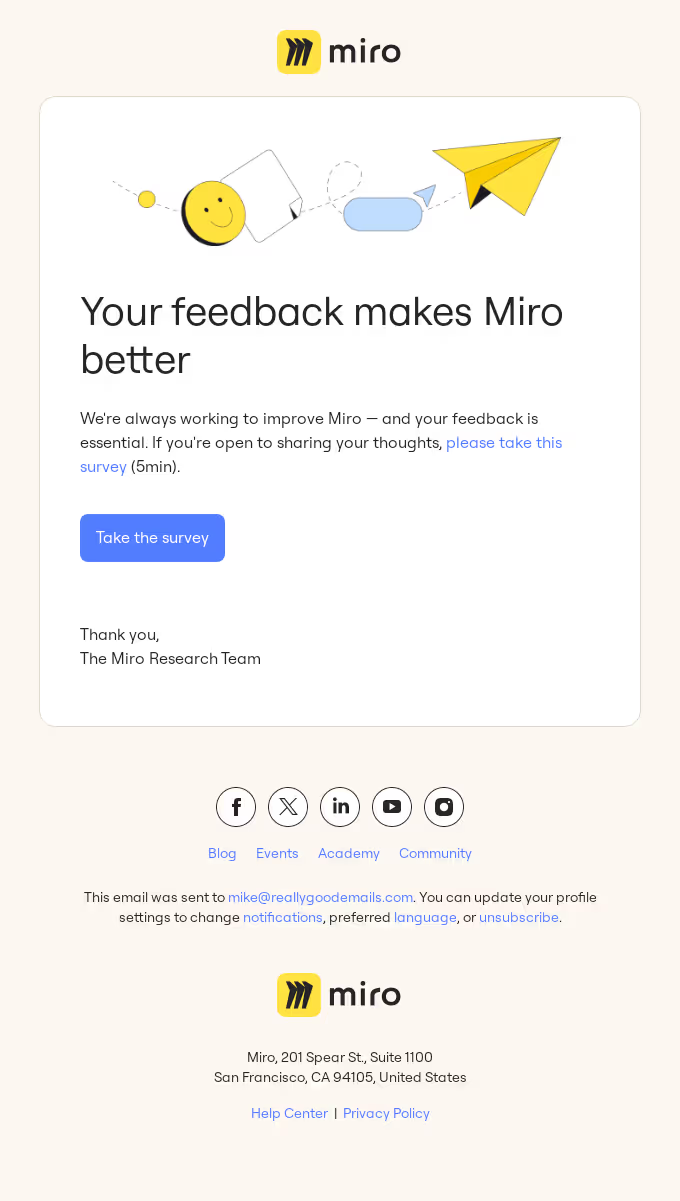
Collaborate with sales and customer success teams
Customer success and sales teams talk to your customers on a daily basis. They have their fingers on the pulse of common challenges and goals.
Use these insights to eliminate friction from the conversion and onboarding process.
Look to customer support tickets and forums, as many users go here first to find answers.
For example, this ClickUp article teaches readers how to manage large amounts of content:
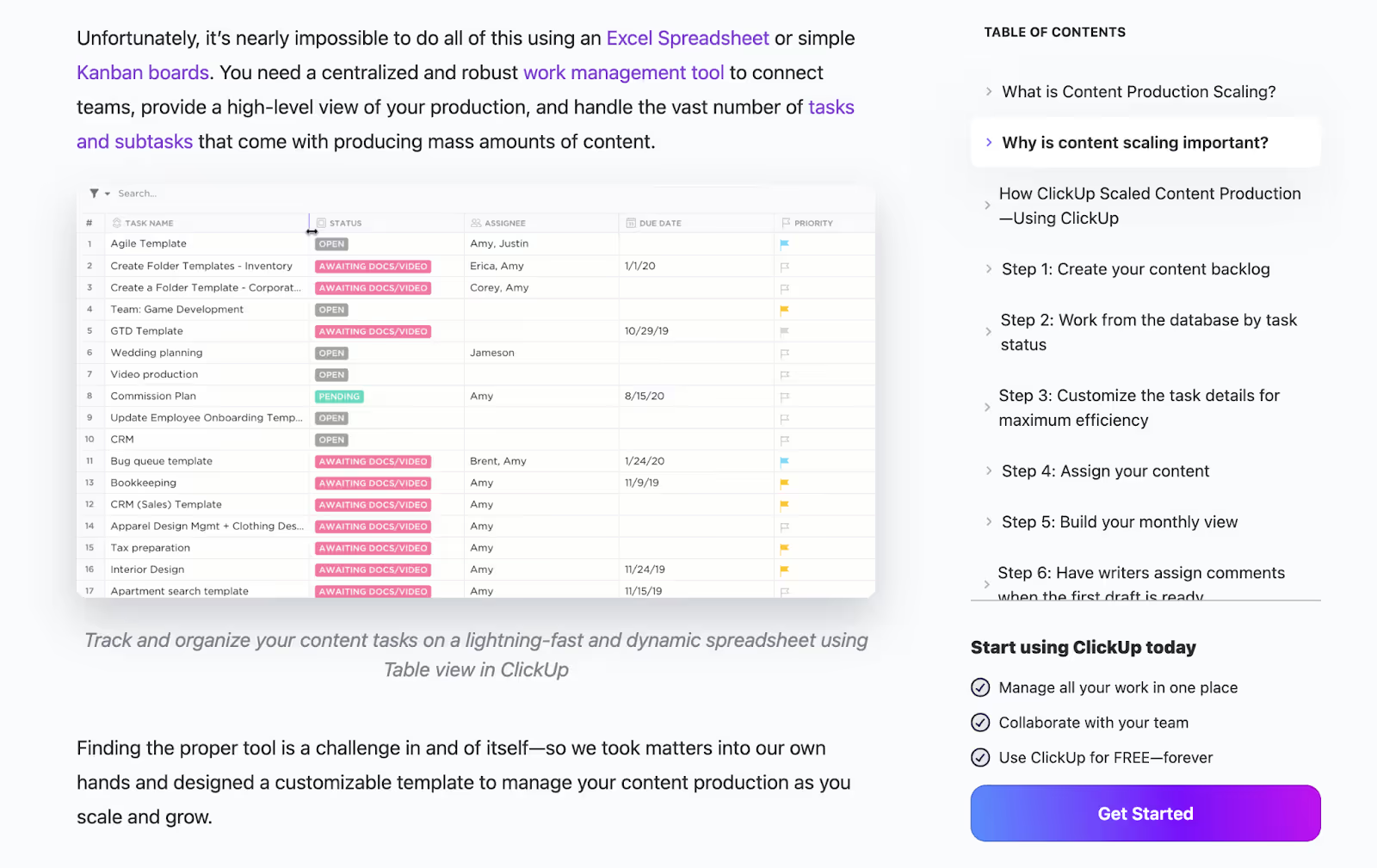
It shares a system for scaling content production—a common use case shared among ClickUp users.
Regularly meet with your sales and customer success teams. Uncover questions customers ask before and after investing in your product or solution.
Find out:
- Which product features have the most usage?
- How do prospects compare you to competitors?
- What features are customers rarely interested in?
Your BOFU content must answer these questions and overcome objections.
Here's how HockeyStack addresses user challenges in its Can You Dashboard It? series:
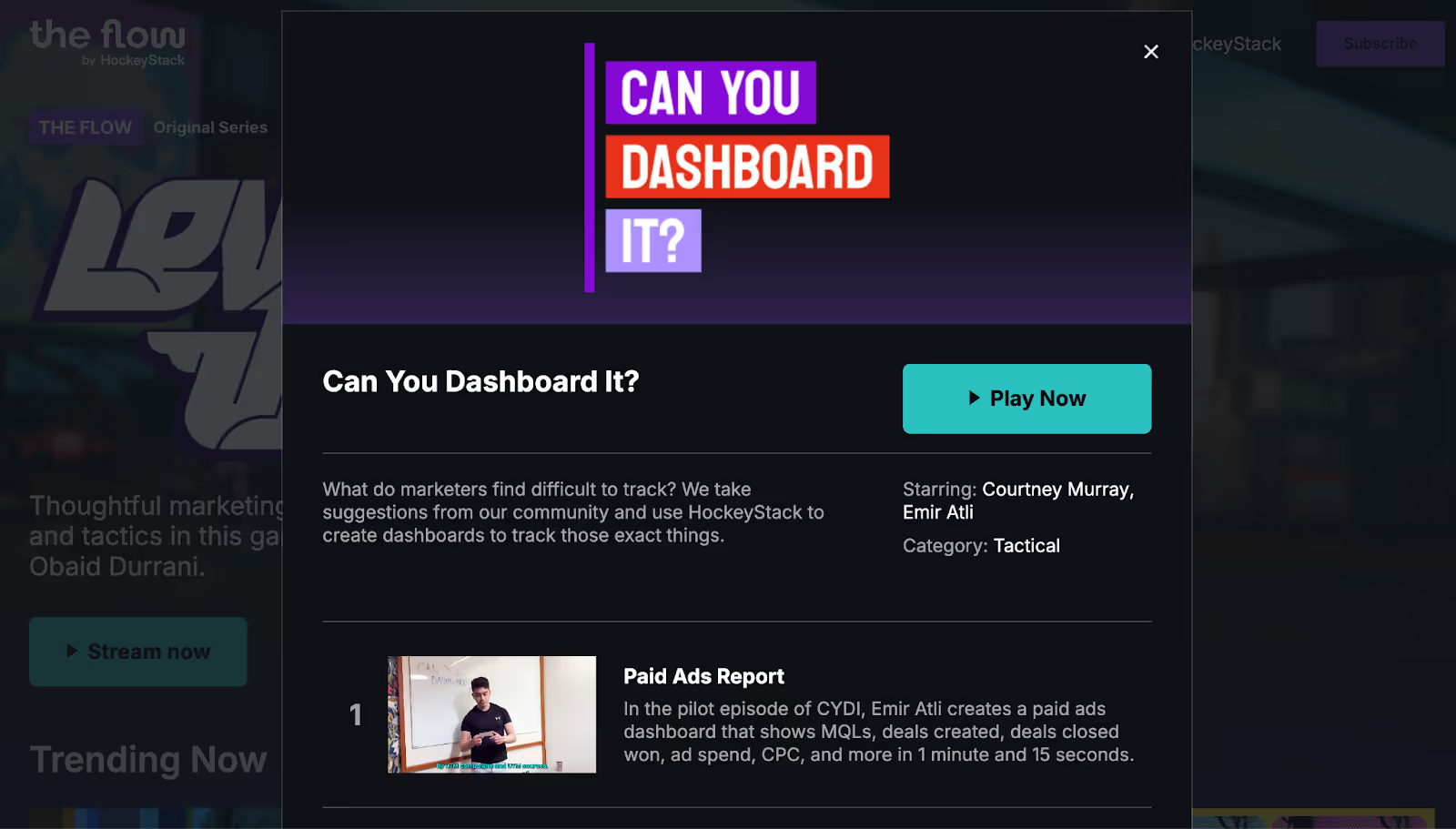
The team shares how to create ad tracking and sales dashboards.
It shows users how to measure impressions and sales activities using their product.
Essentially, the series teaches potential HockeyStack customers how to solve their biggest problems. It's an educational and entertaining series of product marketing materials.
Make it easy for customer-facing teams to share their observations and objections.
Create a dedicated Slack channel or spreadsheet to keep insights organized and accessible.
Run a competitive analysis
Analyze how your audience talks about your competitors. Use this insight to create strong positioning and differentiation.
Use reviews, communities, and support forums to find out what questions they're asking.
What are they saying in G2 and TrustPilot reviews? What objections and complaints do they have?
For example, here’s a response to a Reddit post asking HubSpot users about their biggest problems with the software:
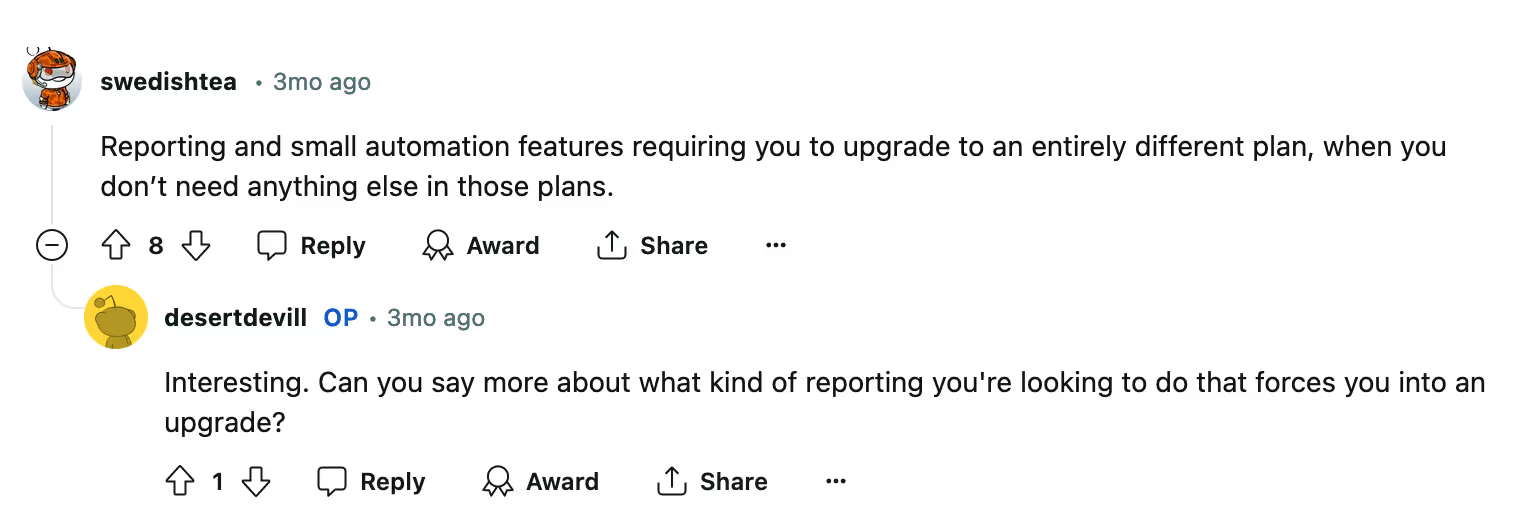
Pricing is a common issue in this thread, their customer base feels it as a whole.
A competing CRM could create a comparison page to show how it fills these gaps. Here’s one we created for Pipedrive:
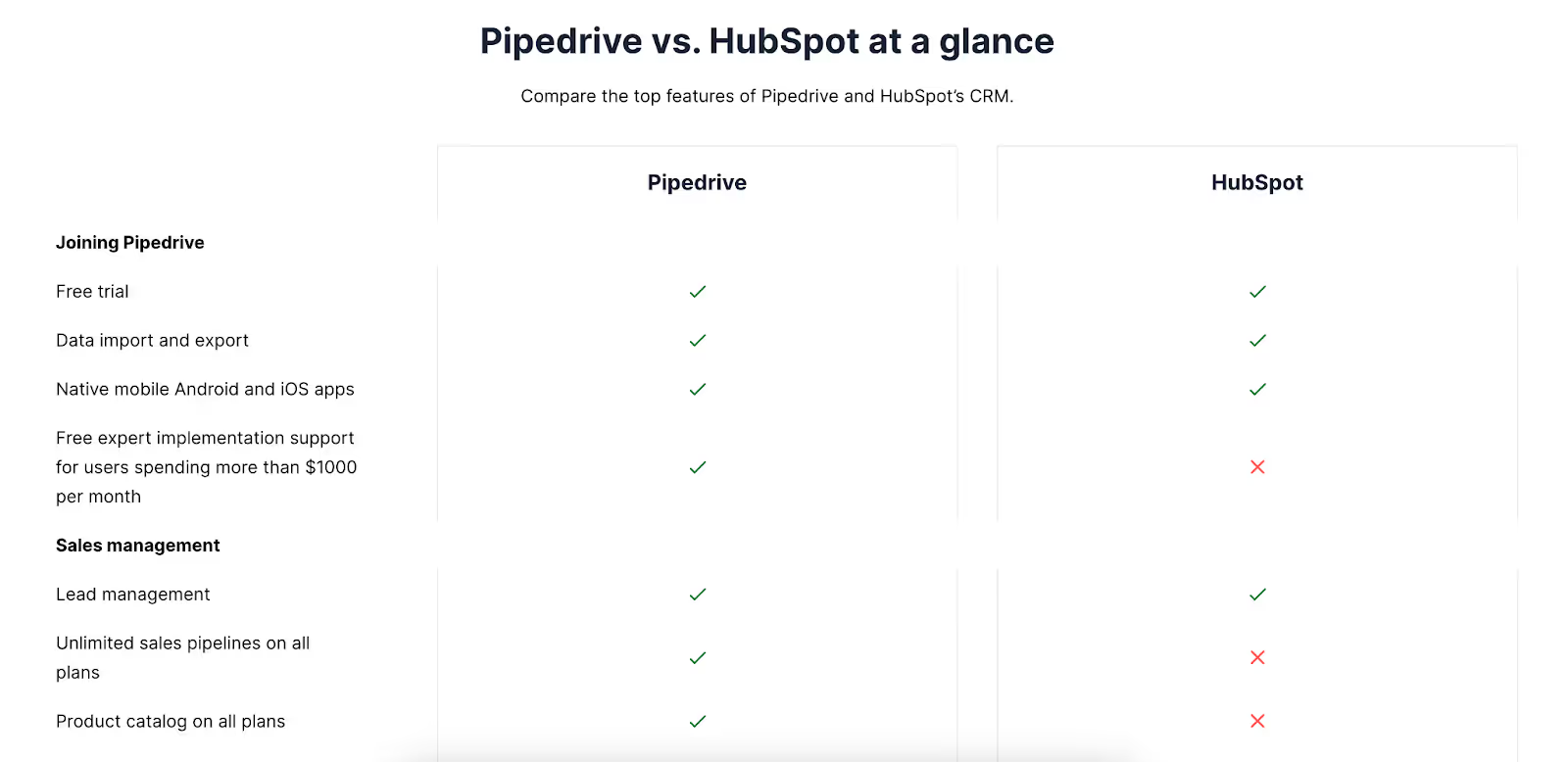
Your competitor analysis might uncover pain points you weren’t aware of. Use these to fill gaps in the market with your BOFU content.
For example, this Reddit post expresses confusion around Notion' digital asset management capabilities:
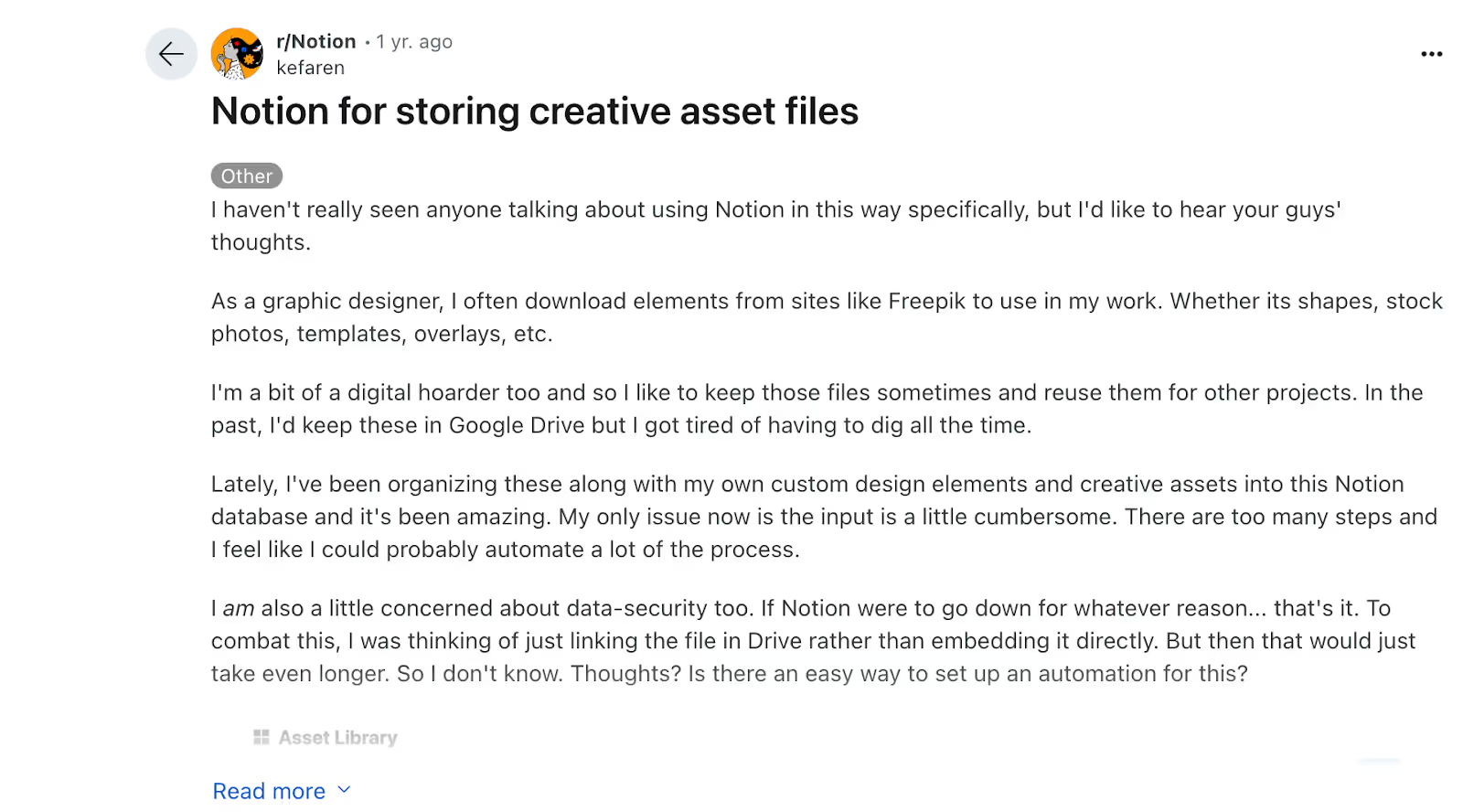
As an indirect Notion competitor, Airtable wrote an article that teaches an easier way to build one:
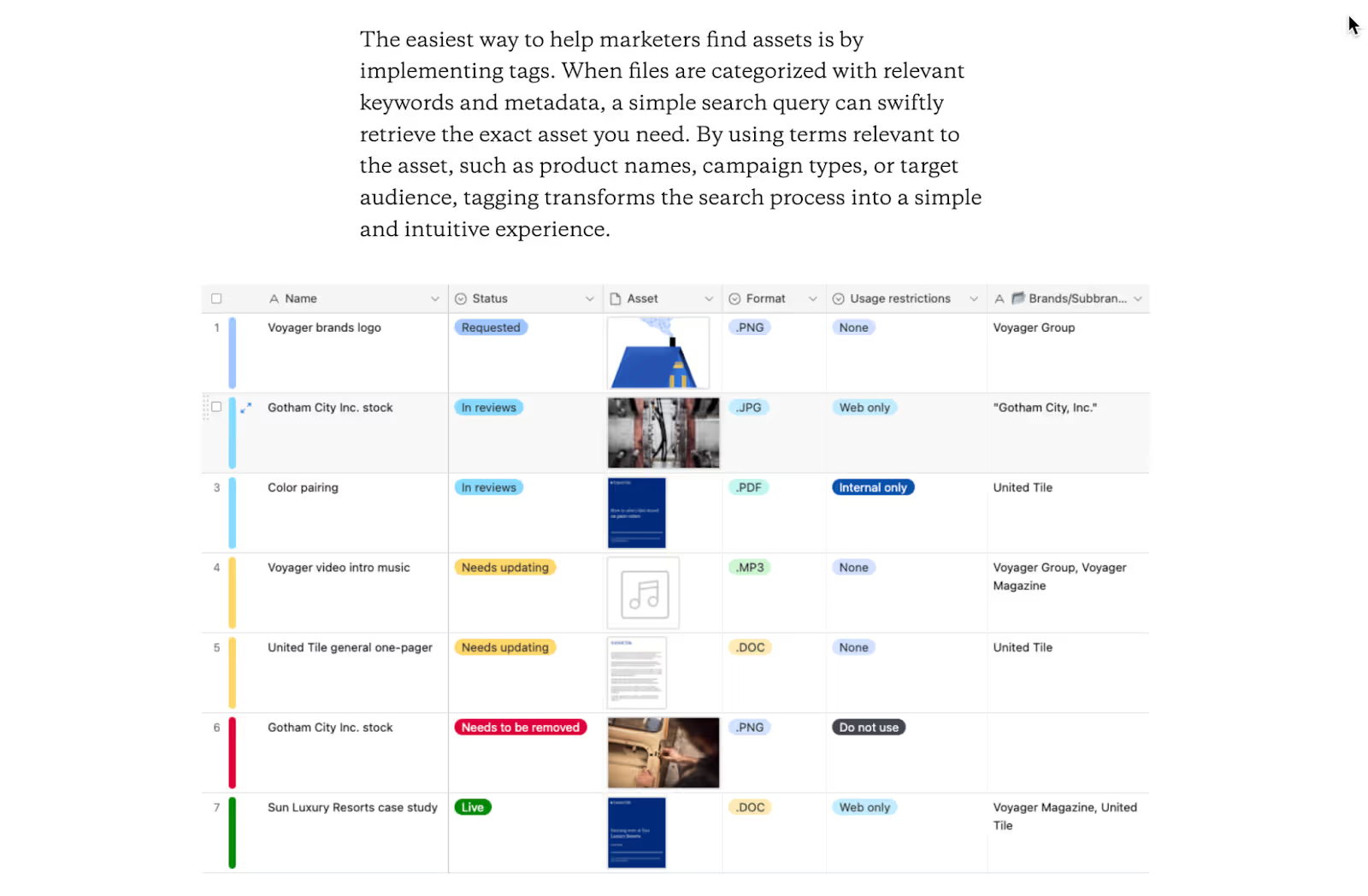
Conduct BOFU keyword research
Optimizing your BOFU content for SEO gets your message in front of potential customers.
BOFU keywords indicate a high intent to invest in a product or service. This includes queries including words like “vs” and “pricing” or “demo.”
Here are some BOFU keyword variations for a SaaS brand:
- best [product type] software
- [product name] free trial
- [product name] demo
- [product type] for [role]
- [product type] for [industry
- [brand name] pricing page
- [brand name] vs. [competitor]
- how to [do a thing] with [product name] (also known as JTBD content)
- [competitor name] alternative
For example:
- best project management software
- crm for real estate
- Notion vs. Airtable
- how to create a marketing report
These are search terms used by in-market buyers who are problem- and solution-aware. They might be close to making a buying decision, as indicated by the search engine results page (SERP)
Here are the results we get for the term “best project management software:”
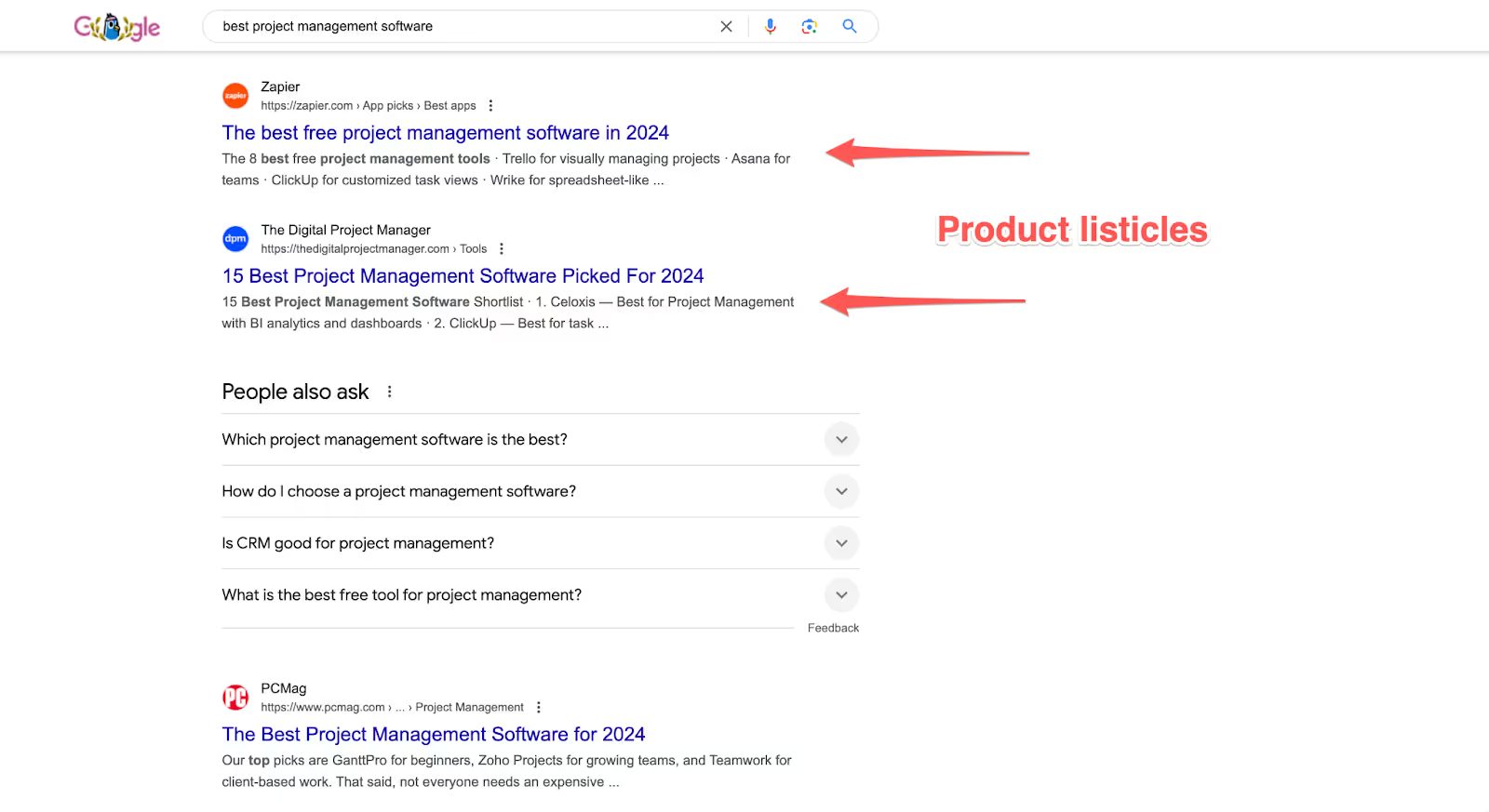
Product listicles indicate that searchers are learning about and evaluating their options.
We use the word “best” in the above keyword list loosely. “Best” could mean any combination of specific features and needs unique to your audience’s criteria.
If keyword research is new to you, HubSpot's guide is a solid starting point.
For now, here’s a workflow specific to finding BOFU keywords:
- Brainstorm relevant terms. Based on your customer interviews and research, identify terms your audience searches when they’re ready to take action.
- Validate demand with a keyword research tool. Put these terms into a keyword research tool like Semrush or Ahrefs to measure demand. Uncover other related keywords using “Terms Match” in Ahrefs or “Keyword Variations” in Semrush.
- Build your keyword clusters. Organize terms that fulfil the same search intent (i.e. have the same results in the SERPs). This helps you maximize results by getting a complete picture of the demand for a topic.
- Analyze search intent. Look at the SERPs for your keywords to commercial intent. For example, if the SERPs for a topic contain product listicles or landing pages, it’s likely that users are researching their options.
- Prioritize ruthlessly. Focus on opportunities based on product relevance, search volume, and brand competition. Prioritize keyword clusters that align with your offering and target audience.
- Test and iterate. Continuously measure performance by monitoring rankings, search visibility, engagement metrics (such as avg. time-on-page), and most importantly, conversions.
Your BOFU content must drive business results. Trials, demos, sales-qualified leads (SQLs), or revenue should be your north-star metrics.
When in doubt, follow the EPIS model: experiment, pivot, iterate, and scale.
7 bottom-of-funnel content types (with examples)
Your chosen BOFU content formats will depend on search intent, customer needs, and goals. Here are nine proven frameworks you can use.
1. Comparison pages (you vs. them)
Comparison pages pit you and your competitors against each other. It makes it easy for customers to compare the features of two solutions in a visual format.
For example, QuickBooks uses a simple table to compare features against Xero—one of their biggest competitors:
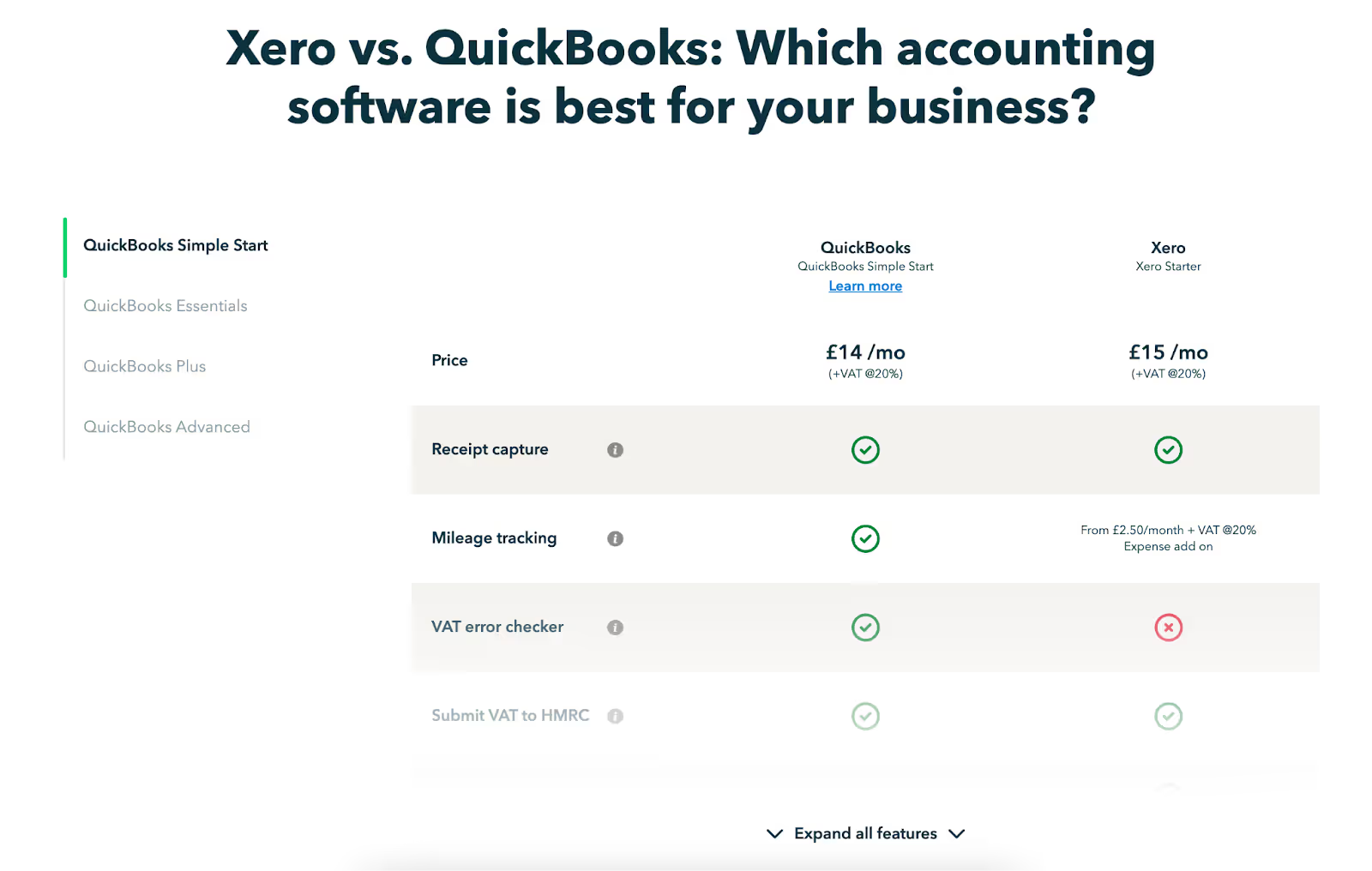
It allows users to quickly compare features when evaluating the two platforms.
And here, Shopify has created a page comparing them against WooCommerce. The four-column layout allows Shopify to lean into what makes them different:
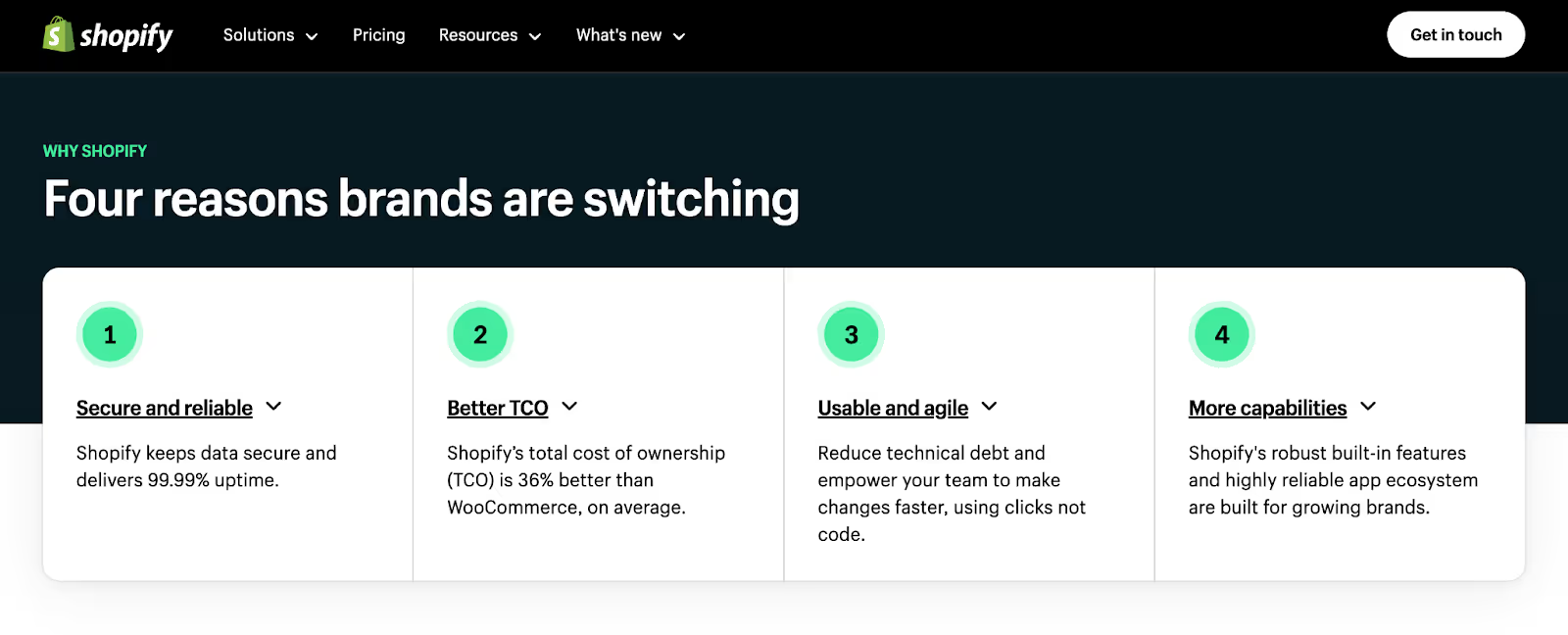
Tips for writing comparison pages:
- Lean into your product’s strengths, and don’t be afraid to talk about who your product isn’t for.
- Don’t misrepresent your competitors. This can erode trust and lead to cease-and-desist notices.
- Dedicate sections to the features and benefits that you offer and others don’t.
- Feature testimonials and case studies to build social proof. If you can find stories of customers who made the switch from a competitor, even better.
- Back up your claims with data. For example, average server uptime.
Be impartial and focus on attracting your best-fit customers. Demonstrate who you’re for and don’t be afraid to alienate people to attract your best-fit customers.
2. Product pages
Product and landing pages highlight the benefits of your solutions and features. They can also cater to specific audience segments, roles, and industries.
Take this product page we wrote for Pipedrive’s web forms feature (which generates over 400 visitors a month). It focuses on the features that customers care about the most:
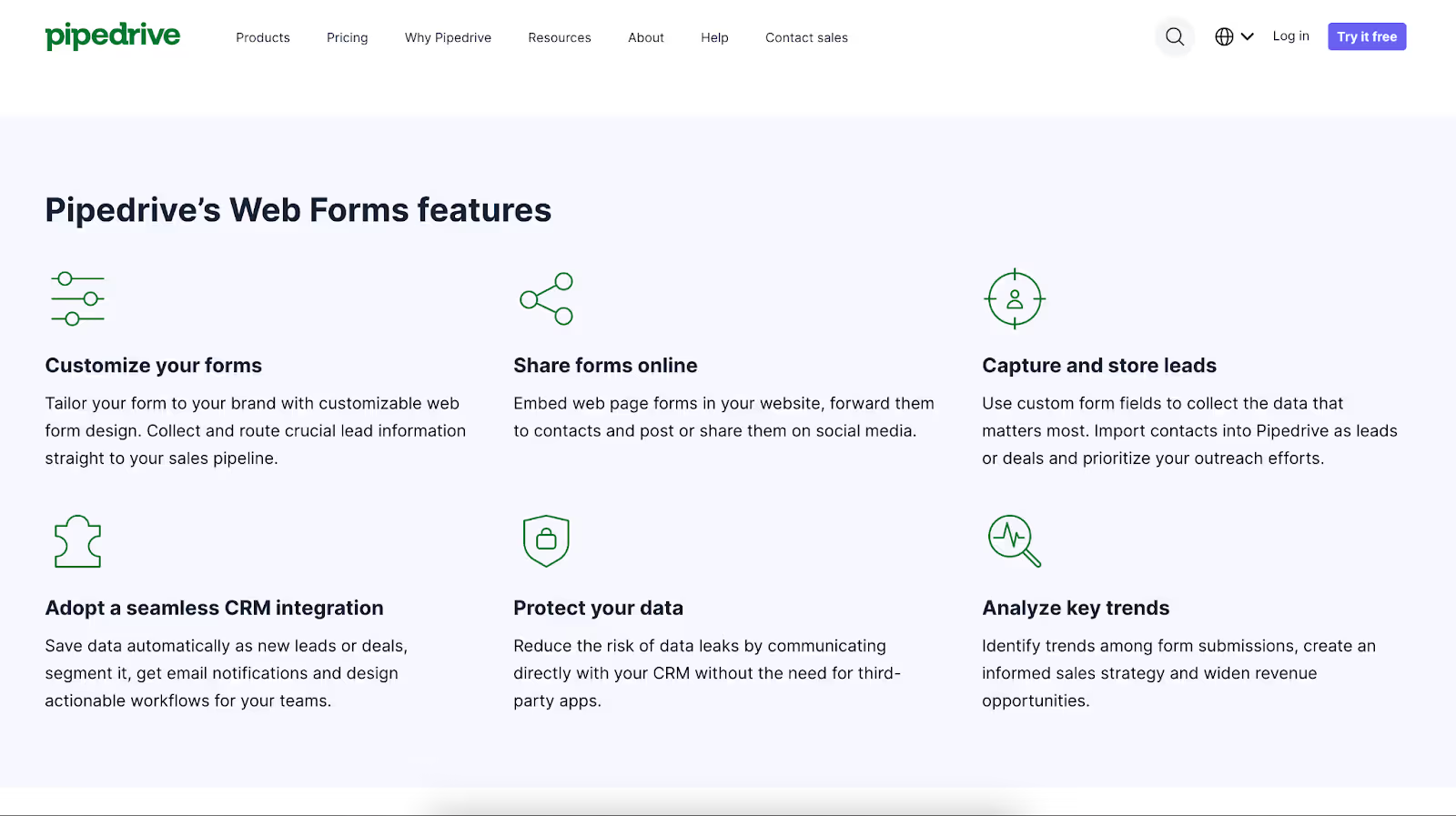
It also shares helpful information on what to look for in a web form tool:
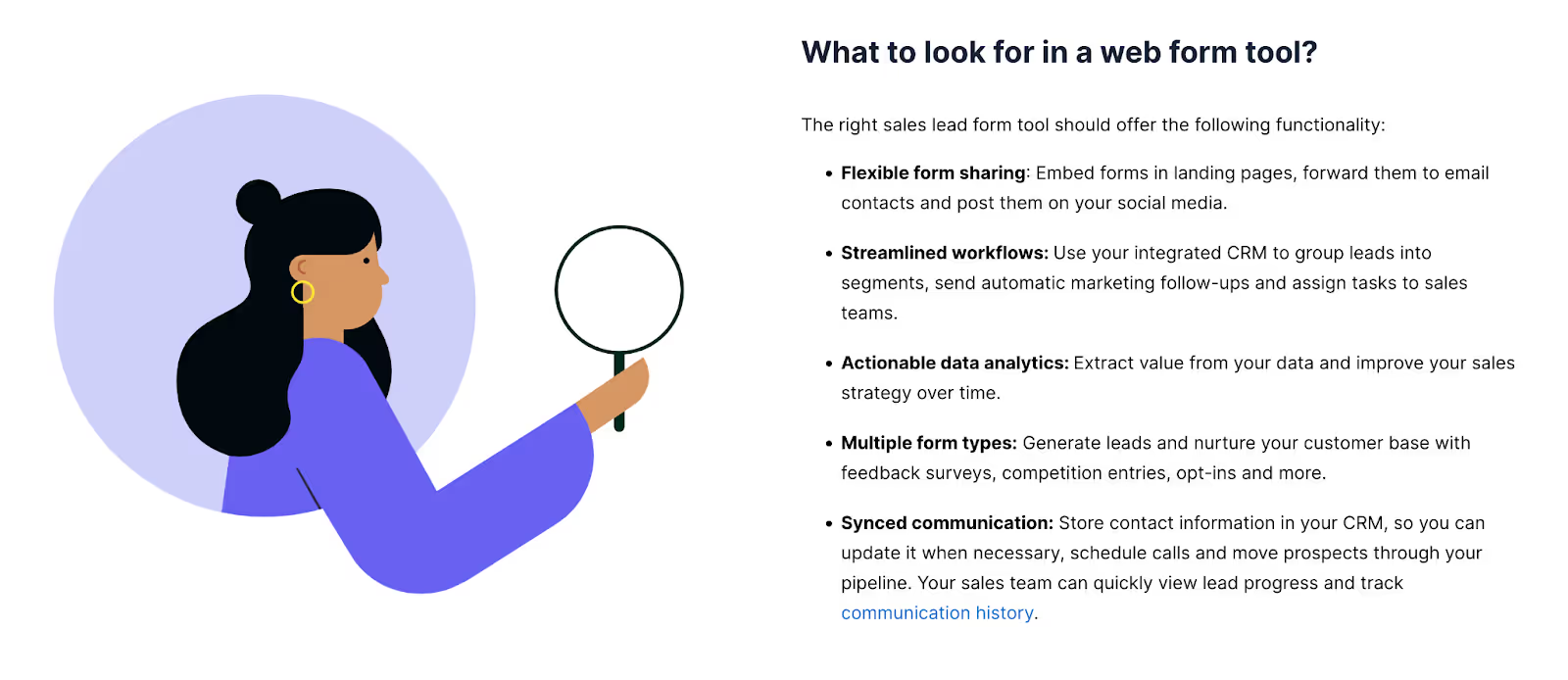
Tips for writing product pages:
- Dedicate full-width sections to the most important features and benefits.
- Edcate users by writing punchy copy using a framework like PAS or SCQA.
- Pair product features with benefits, outcomes, and your customers’ JTBD.
- Clearly state what your features help customers achieve.
- Use grid layouts (e.g. 3x3) to increase the perceived value of your product or features.
- Educate your readers on what the feature is and how to choose one.
- Reduce friction with step-by-step instructions on how to get started.
- Improve visibility by optimizing product pages for SEO.
Optimizing your product pages for search helps you capture new in-market buyers. To date, we’ve helped Pipedrive generate approx.
3. Alternative pages
Alternative pages offer lists of similar products to a particular brand.
For example, it's likely someone searching for “asana alternatives” is in the market for project management tools. They might also be an Asana customer looking to switch:
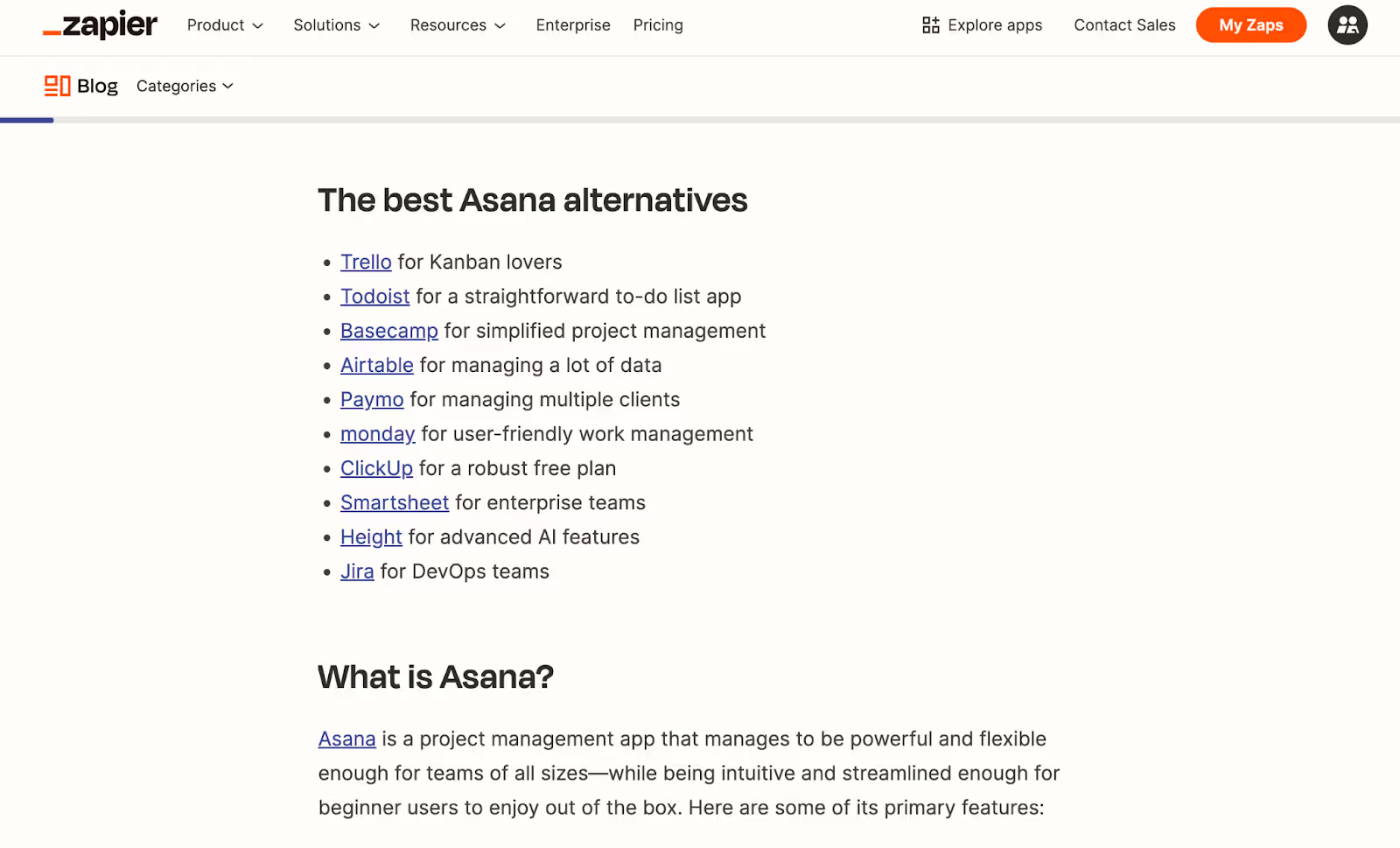
Tips for writing alternative pages:
- State what each tool is best for in subheadings and table of contents.
- Add a table at the top of the page to give readers a summary.
- Include additional content (definitions, how to find the best solution, etc.).
- Give your sections uniformity by including the same elements e.g. pros, cons, pricing, description, etc.
3. Best of
“Best of” pages offer lists of products and solutions in a specific category. The format is similar to alternatives pages, as they offer tools and solutions in a list format.
For example, this article from PandaDoc lists the top e-signature software platforms. It uses several of the principles shared with “alternative pages” above:
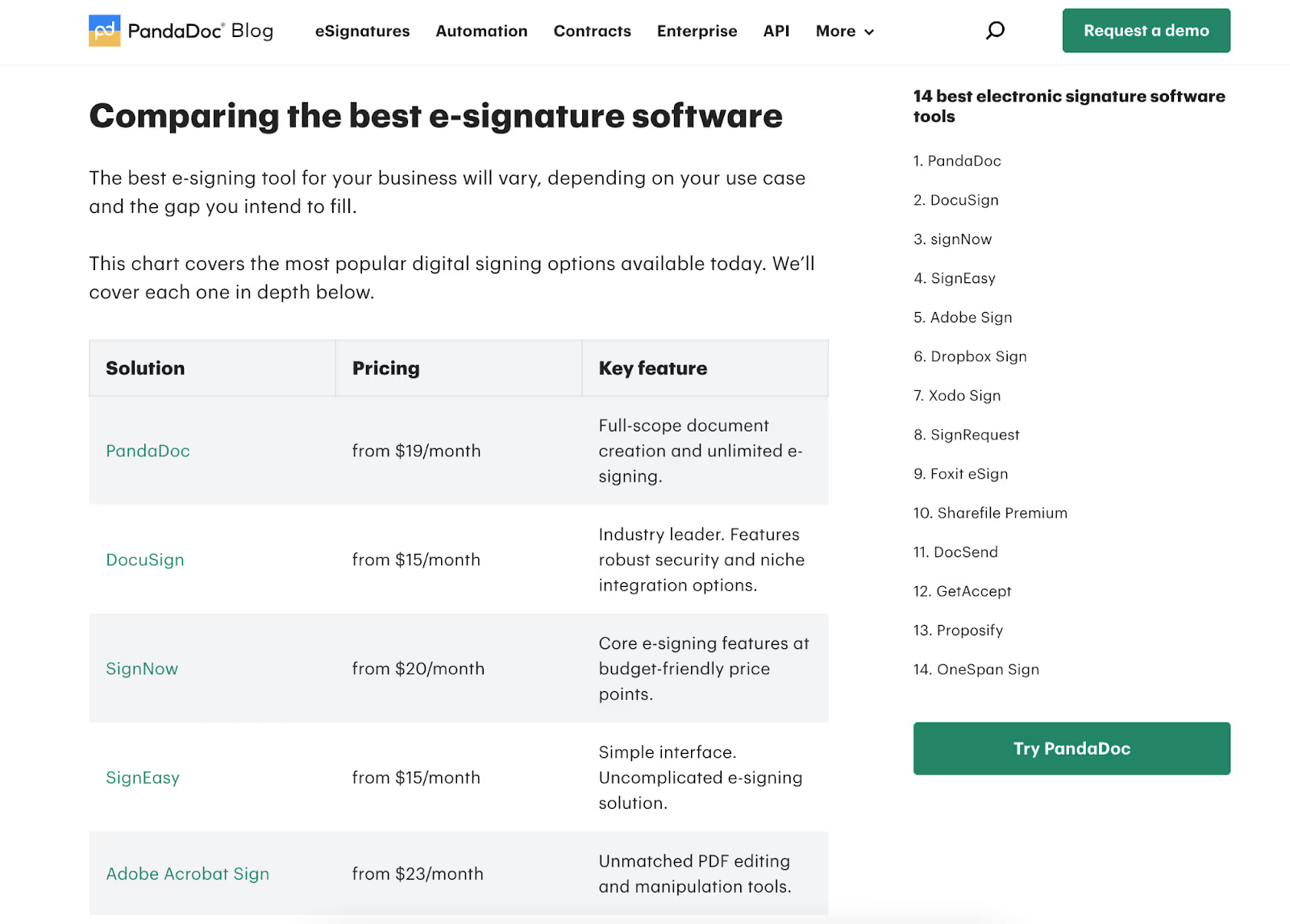
Tips for writing “best of” pages:
- Feature your product or brand at the top of the list for maximum exposure.
- Don’t be afraid to list your competitors. This will build more trust with users.
- Follow the same principles in the “alternative pages” tips above.
“Best of” pages are once of the best BOFU SEO content assets you can create.
Why? Because it gets your product in front of an audience who are at the early stages of the buying process. Use them to get into their consideration set.
4. Case studies
Case studies share the success stories of your customers. They build trust with your audience while allowing them to learn more from their peers.
At Grizzle, we follow a traditional case study framework:
- Challenge: Share the problem that your customer faced, and why they decided to invest in your brand.
- Solution: The specifics of how your product or solution solved their problems.
- Results: How you helped your customer achieve a specific outcome.
Like this content and SEO case study we produced with Tide:
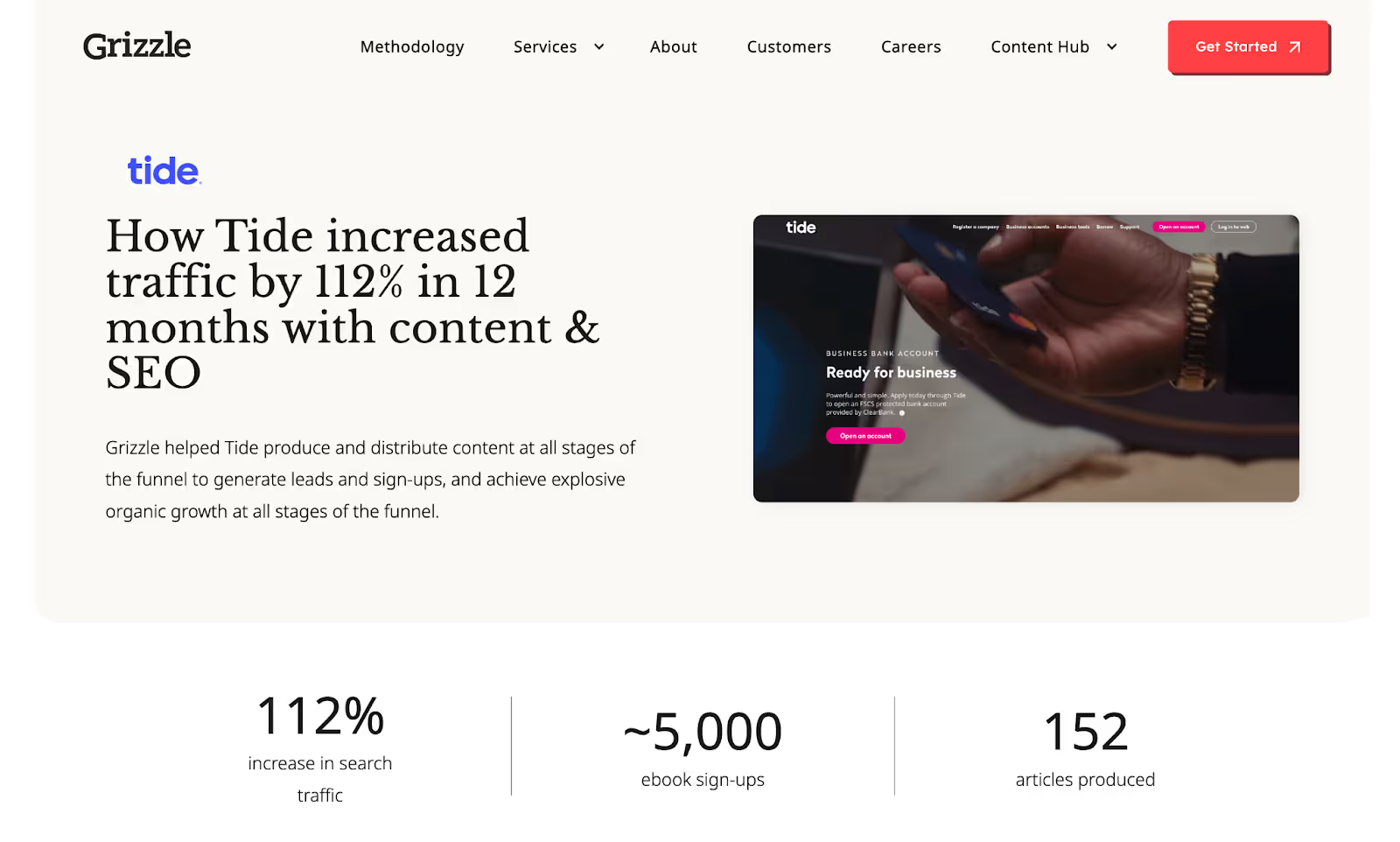
Tips for writing case studies:
- Feature a snapshot of results at the top of your case study.
- Include industry and business model to build social proof with similar companies.
- Add information that shares how you helped your customers.
- Include imagery and multimedia.
- Featured client quotes throughout the case study.
5. Ebooks
Ebooks are a long–form content format that offer huge amounts of value to readers. They're often used for lead generation in exchange for email and other information.
Despite their reputation, ebooks are still an effective form of content—when done right.
For example, this playbook from Madison Logic offers a system for creating an account-based marketing (ABM) motion:
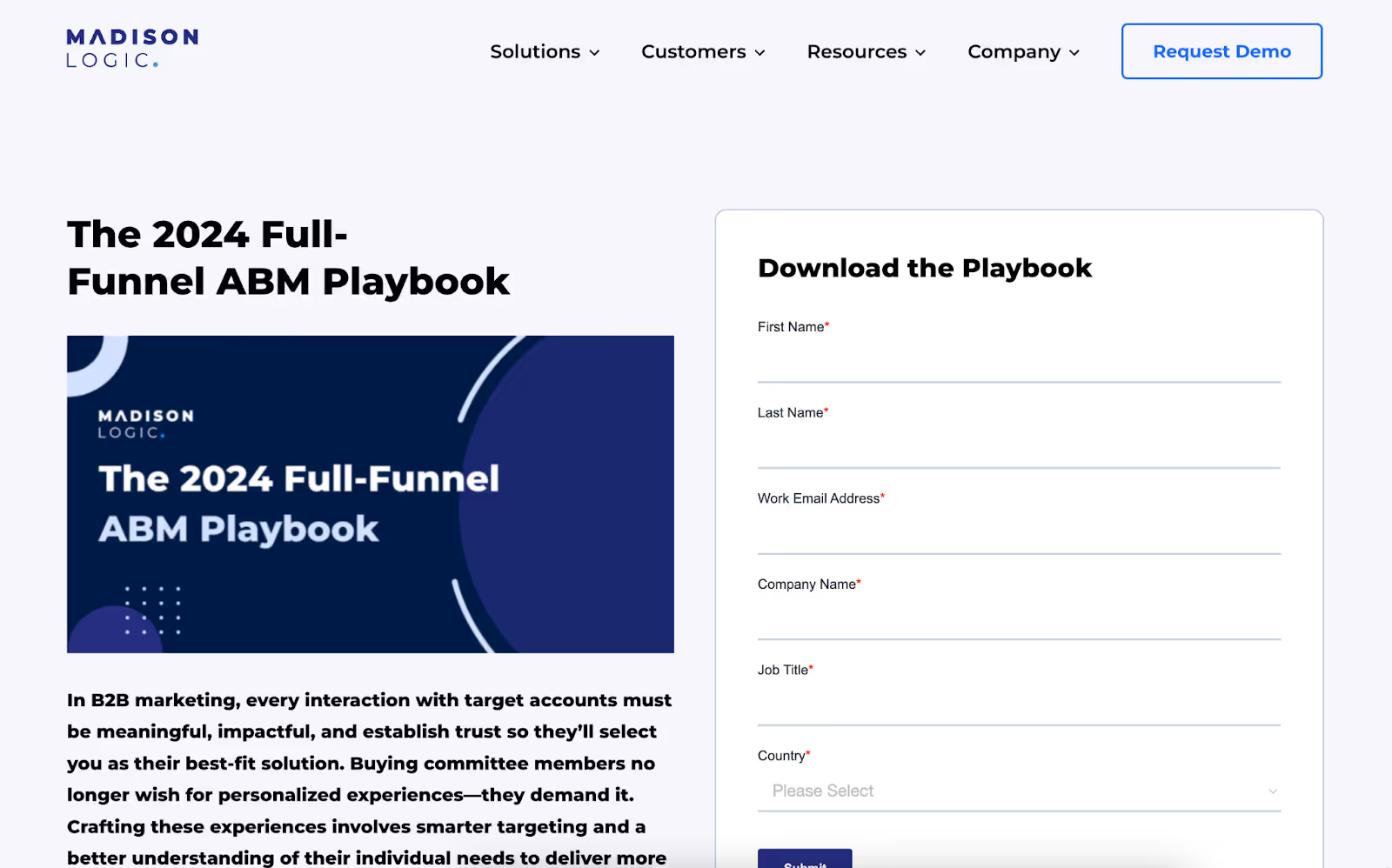
Readers have everything they need to get started with this marketing practice. From strategy and targeting to creating effective ABM content, it reveals the entire system.
Tips for creating ebooks:
- Don’t hold back on value. Give away plenty of guidance, examples, frameworks, and templates to make it worth your audience’s time.
- Make the reading experience delightful with good design.
- Pair your ebook with a high-converting landing page.
- Use email nurture workflows to further educate your audience.
6. Webinars
Webinars are online events where a host shares a presentation with an audience. They can be live, recorded, or evergreen.
Whichever format you choose, your webinars must be educational. And they must be relevant to your product or solution.
For example, this webinar series from Later offers social selling advice from other experts:

The series dives deep into a specific social selling practice, offering plenty of how-to advice.
Most importantly, many of the webinars teach attendees how to achieve their goals or solve problems using the Later platform. This makes them educational while mentioning features, increasing awareness of Later’s products.
Tips for running webinars:
- Partner with other experts and brands to reach a wider audience.
- Make your webinar a live event and let attendees interact with the host to increase engagement.
- Request questions from the audience before the live event.
- Record the webinar and allow users to access it later in return for their email address.
- Include a call-to-action at the end of your webinar to convert attendees into leads, demos, and users.
7. Explainer videos
Explainer videos are animated or live-action assets that communicate product features and benefits.
Here’s an explainer video we created for SmileBack’s CSAT feature:
It talks about a specific problem faced by SmileBack’s audience of MSPs before sharing the solution.
The video also shares step-by-step instructions on how to get started with the feature. This reduces friction for new users and shows viewers how easy it is to get started.
Tips for creating explainer videos:
- Get specific with the problems you solve. Kick the pain to hook users and keep them engaged.
- Invest in high-quality motion design, voice-over artists, and animation to establish credibility.
- Showcase product features and how they work with motion design.
- Use animation to tell a story and illustrate your points.
Generate more revenue with BOFU content
Bottom-of-funnel content drives customers to trust your business and make purchases.
It satisfies their search intent by positioning your solution as the perfect answer to their problems.
Talk to existing customers, spend time where they hang out, and study your competition.
Build a BOFU content strategy to address those challenges. Feature your product as the natural solution to your customer’s problems and JTBD.


When making SEO a priority, it can be easy to measure up against competitors. As a result, content loses originality. It fails to stand tall and shine in a sea of content playing by the same rules.
Great SEO-driven content should accomplish the following:
- Alleviate the challenges and deliver specific solutions to make your audience happy,
- Deliver value that answers every single question they have, and
- Make Google happy from a data-driven perspective
In this article, we’ll outline the content marketing & SEO methodology we use to help companies get results like this:
- Fintech company: 25% month-on-month increase in search traffic (~10,000 visitors to ~32,000 in 6 months)
- SaaS company: An extra 10,000 organic visitors a month
- Consulting company: 1,185% increase in search traffic in 12 months
🤫 We’ve included anonymized data throughout this article. Want to learn more about what goes on behind the scenes? Get in touch.
A content research methodology to optimize success
Research is what will make or break your content marketing efforts. It’s a delicate balancing act. In order to capture visibility in the SERPs, your content must:
- Target keywords relevant to your audience & brand
- Satisfy the Google monster, and
- Delight your audience, empower them and give them answers
As well as a data-driven approach, your research must also be qualitative. At the very least, your process should uncover the following:
- An understanding of current trends
- Analysis of content competitors and their high-performing articles
- Customer interviews to generate insights
- Need identification (challenges, pain-points, desires, etc.)
- Keyword research
- Funnel mapping (how the content serves the audience)
- Topic ideation
Content competitors are the brands or publications that are attracting the same audience as you. They may not sell competing products, but they are fighting for the attention of your customers.
It’s also one of our favorite places to start with data-driven research. With the right approach (and tools), you can identify upcoming market trends, common audience challenges and uncover keywords you may not have thought of.
But the most important part of content research is understanding your customers.
This means getting on the phone and conducting customer interviews. If there’s friction, start with your sales or customer support teams. They talk to your customers on a daily basis and hear the same questions, objections and pain points regularly.
The insight and data you collect through these approaches is your ideation fuel. Use it to prioritize topics, set content objectives and map them to the funnel.
Funnels, flywheels and spaghetti hoops – the trusty marketing funnel is under scrutiny in today’s marketing landscape. However, funnels are still a useful tool to help you give your audience the information they need, when they need it.
They control the customer journey. But you can still give them the stepping stones that help them navigate it. That’s what a marketing funnel should do.
Some topics may not have a large search demand, and that’s ok. Your content strategy should be fueled by satisfying market needs, not by search data alone.
A process for comprehensive & original content
Once you’ve prioritized your topics, it’s time to plan and produce your content. At Grizzle, we do this using a “Content Framework”, which covers the objective of the content, search data, target audience information and an outline.
In order to create content that ticks all the boxes, we use a planning methodology that defines the high-level strategy of an article as well as the nuances and details it should contain. A macro/micro approach.
Let’s say we’re creating an article on “transcendental meditation”, with the objective to rank for that keyword. As SEO is the main goal here, the macro-level planning would include an opportunity analysis. This should include the following:
- Content Competition: How comprehensive is the existing content? Does it include proprietary assets we don’t have access to? What are the gaps we can fill?
- Backlink Competition: How many referring domains does each piece of competing content have? Is the competition moderate or fierce?
- Content Opportunities: What do we need to do in order to overcome the competition, and create the most valuable piece of content available for our audience.
On a micro-level, consider sub-topics that would make the content original. For example, can you add unique stories, original insights or influencer quotes? There are dozens of ways to inject originality into your content.
Use this same philosophy throughout the content production process. Start by identifying “expansion threads” – areas of your content that can be expanded upon with more granular insights, advice and how-to information. “Value bombs”, as we sometimes like to call them.
To summarize: Macro/micro mapping means taking a high-level approach to what your content must look like in order to succeed, as well as the details that will ultimately make it original.
A data-driven editorial processes
I won’t wax lyrical about the need for polished, high-quality content here. You already know that a solid editorial process is key for a strong content strategy.
Instead, let’s focus on how we use data to help the process. Using data-driven tools and a general understanding of our audience, we’re more likely to create the best content possible.
Clearscope is invaluable for this process. It helps us identify common themes and weave a logical narrative. For example, here are some relevant terms for the keyword “smart casual:”
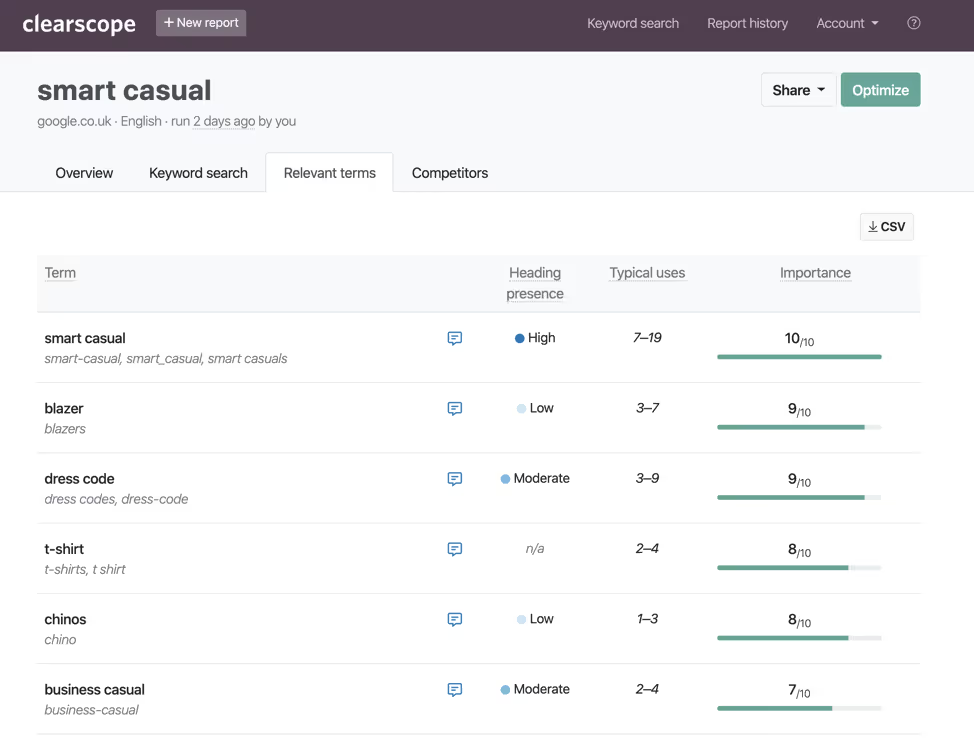
Of course, common sense is required. You can’t simply shoehorn a phrase into your content just to tick a box. Look for how to add an original spin on important terms, and use them as a guide when planning content from a macro/micro perspective.
An 80/20 approach to promotion
When publishing content, many marketers go on a promotion spree, spamming every channel they feel is relevant.
However, for pure-play SEO, you don’t need to go nuts. Select a handful of channels where your audience is active, and promote your content there in a contextual manner.
Why? Because if you did your homework correctly, your content should do the heavy lifting. A handful of promotion channels will help get your content on Google’s radar. As a bonus, it’s likely you’ll attract targeted eyeballs in the first seven days of publishing.
[[component]]
However, for SEO-driven content that relies on a reliable publishing schedule, focus on content quality.
What about link building?
In short: Link building isn’t always necessary. For example, we managed to get this Sales Hacker article ranked #1 without any link building, appearing above the likes of HubSpot for our target keyword:

And it’s not an isolated occasion. We recently helped a fintech client rank on page one for a term with over 400,000 monthly searches and a keyword difficulty of 57/100 (according to Ahrefs).
How? Because we committed to creating something 10 times better than the competition. Pick your link building battles and focus on the topics and keywords that need it most.
Conclusion
Getting better SEO results requires the best content. But before you can do that, you need to identify the right topics.
This means understanding your audience’s challenges and needs at all stages of the funnel. Use the funnel as a guide to deliver the right content at the right time.
Ultimately, focus on creating content that delivers long-term nurturing opportunities, while simultaneously catering to visitors who are ready to buy.
Fuel your growth with content that actually delivers.


